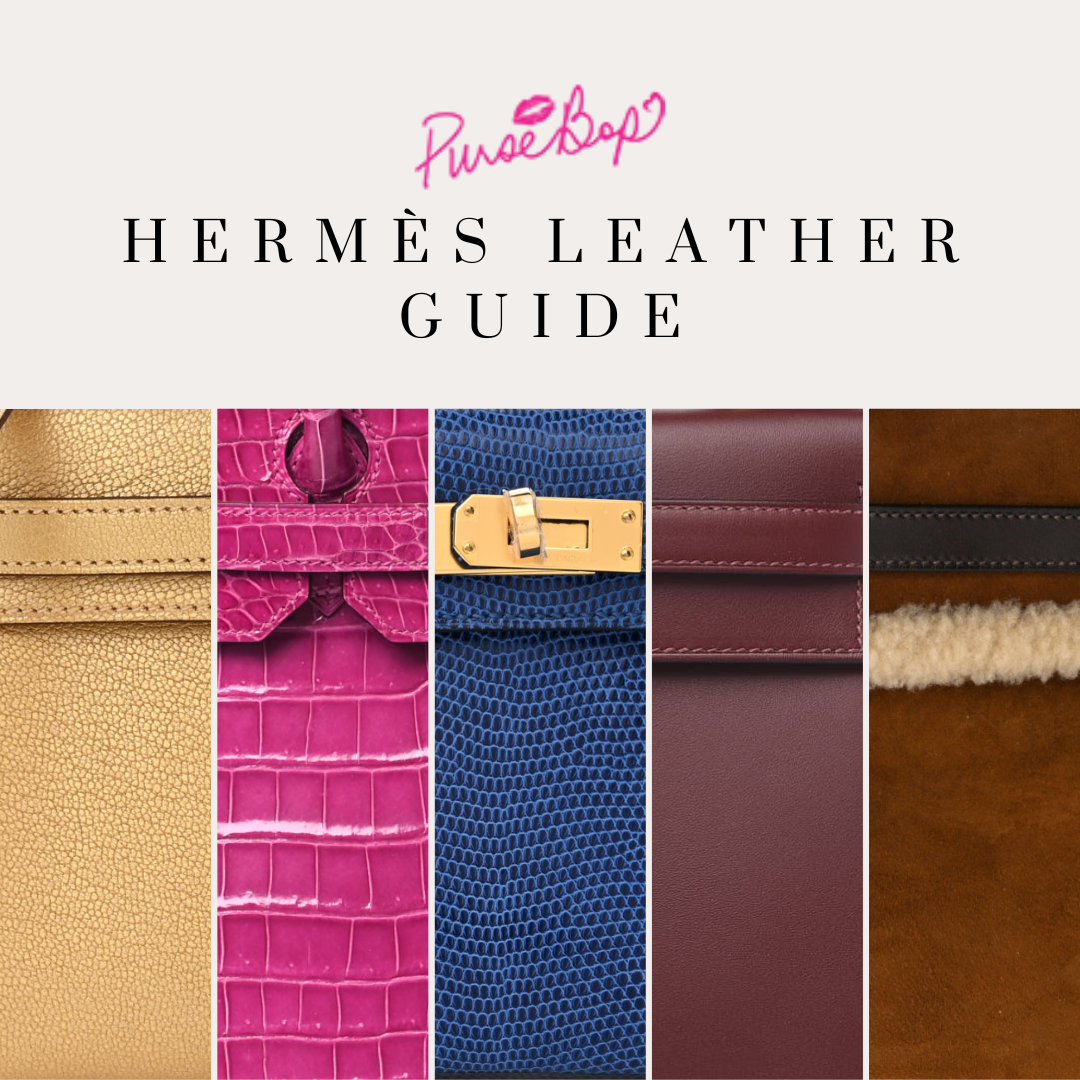
The Evolution of Hermès
Founded in 1837 by Thierry Hermès, Hermès began as a small Parisian workshop specializing in equestrian gear and catering to the elite with high-quality harnesses and saddles. While the product range has greatly expanded over the decades, the commitment to artistry and craft has remained, transforming Hermès into a luxury goods powerhouse.
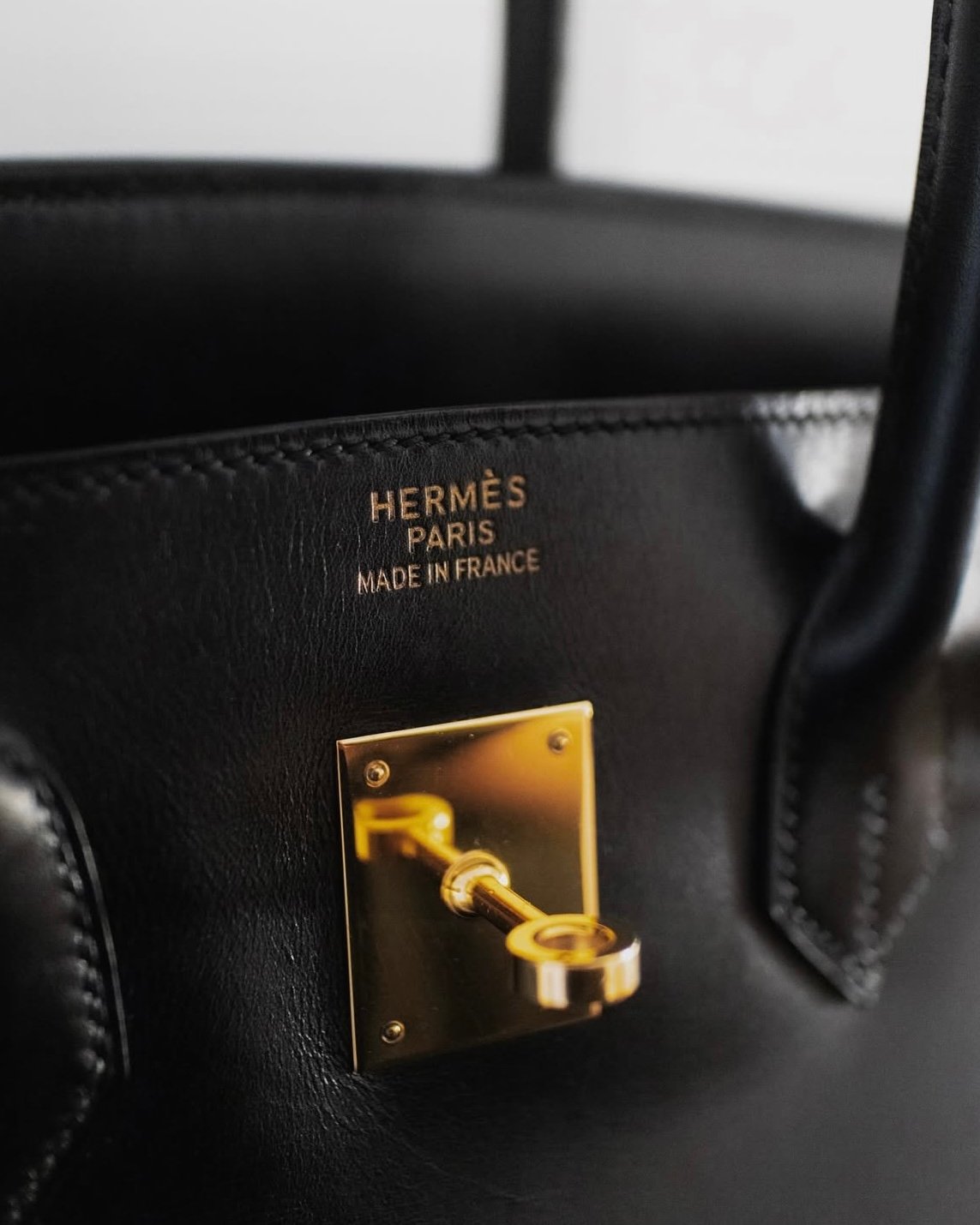
Image courtesy: @the.life.of.niels
As Hermès grew, it introduced more leather products, and unveiled its first iconic bag, the Haut à Courroies (HAC), in 1892. Originally designed to carry saddles and riding equipment, the HAC became the landmark creation for the Maison’s renowned handbag collection.
In 1953, the Kelly bag followed as Hermès’ first true luxury handbag, cementing its place as one of the most iconic designs in history. Then, in 1984, the original HAC inspired the creation of the beloved Birkin, another legendary piece. Remarkably, the HAC remains an integral part of Hermès’ permanent collection today, underscoring the enduring appeal and legacy of the Maison’s luxury accessories.
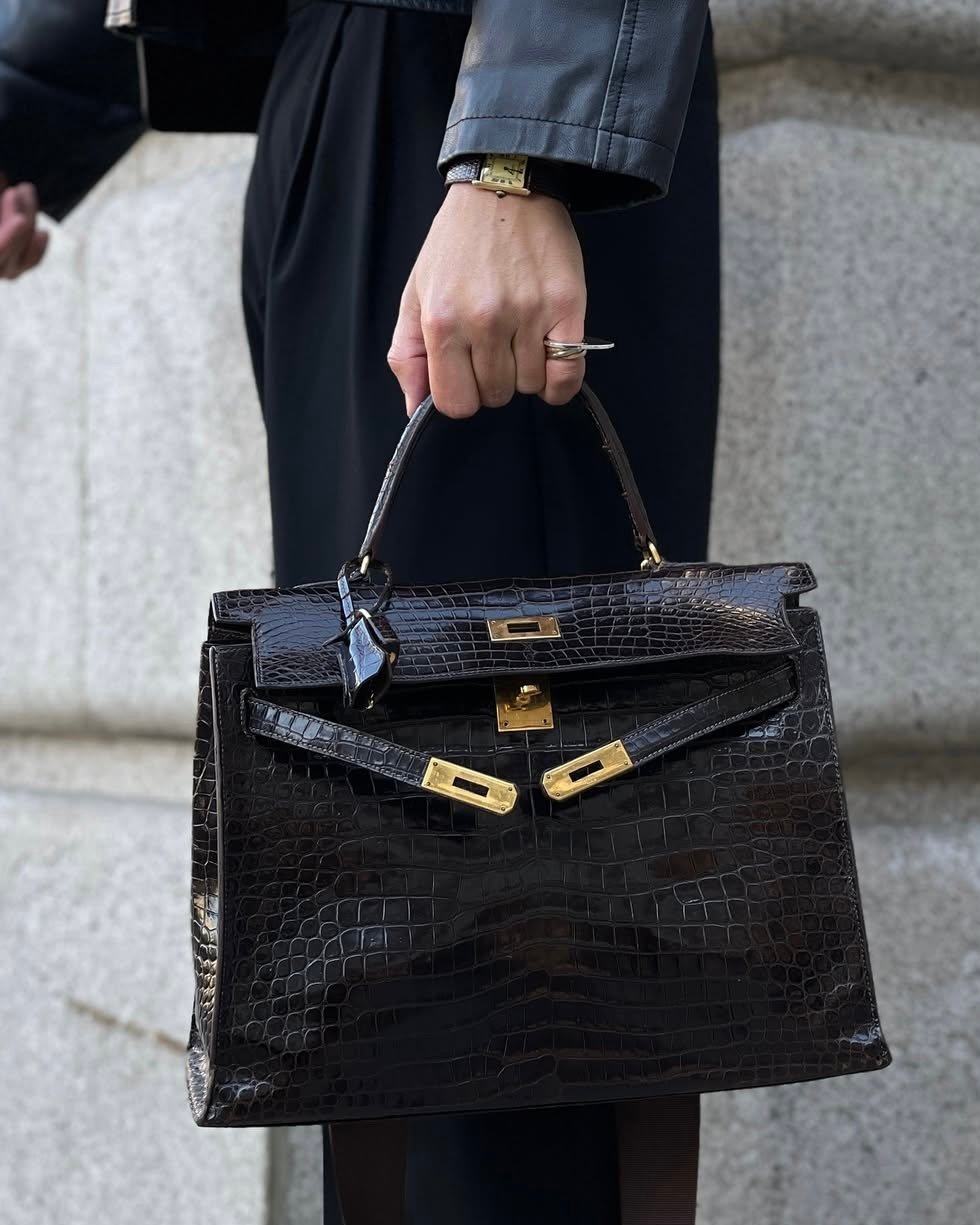
Image courtesy: @thebirkinboy
The Legacy of Hermès
Today, Hermès continues to be revered for its timeless designs, commitment to quality, and attention to detail that defines each of its exceptional creations.
Hermès Leathers: The Cornerstone of Craftsmanship
Leather lies at the heart of Hermès’ legacy, forming the foundation for the Maison’s iconic bags and accessories. Every hide is carefully selected and masterfully crafted into something extraordinary. From the everyday elegance of supple Togo to the refined beauty of Box Calfskin and the luxurious appeal of exotic Alligator, each leather is selected for its unique qualities. This dedication to creating and using only exceptional materials is at the heart of Hermès’ art and creations.
Decoding Hermès Leathers and Exotic Skins
This comprehensive guide offers you an insider’s look into the expansive world of Hermès leather. Whether you’re a seasoned collector or a curious enthusiast, this guide will enhance your understanding of the unique characteristics of the leathers and skins that define Hermès leather goods.
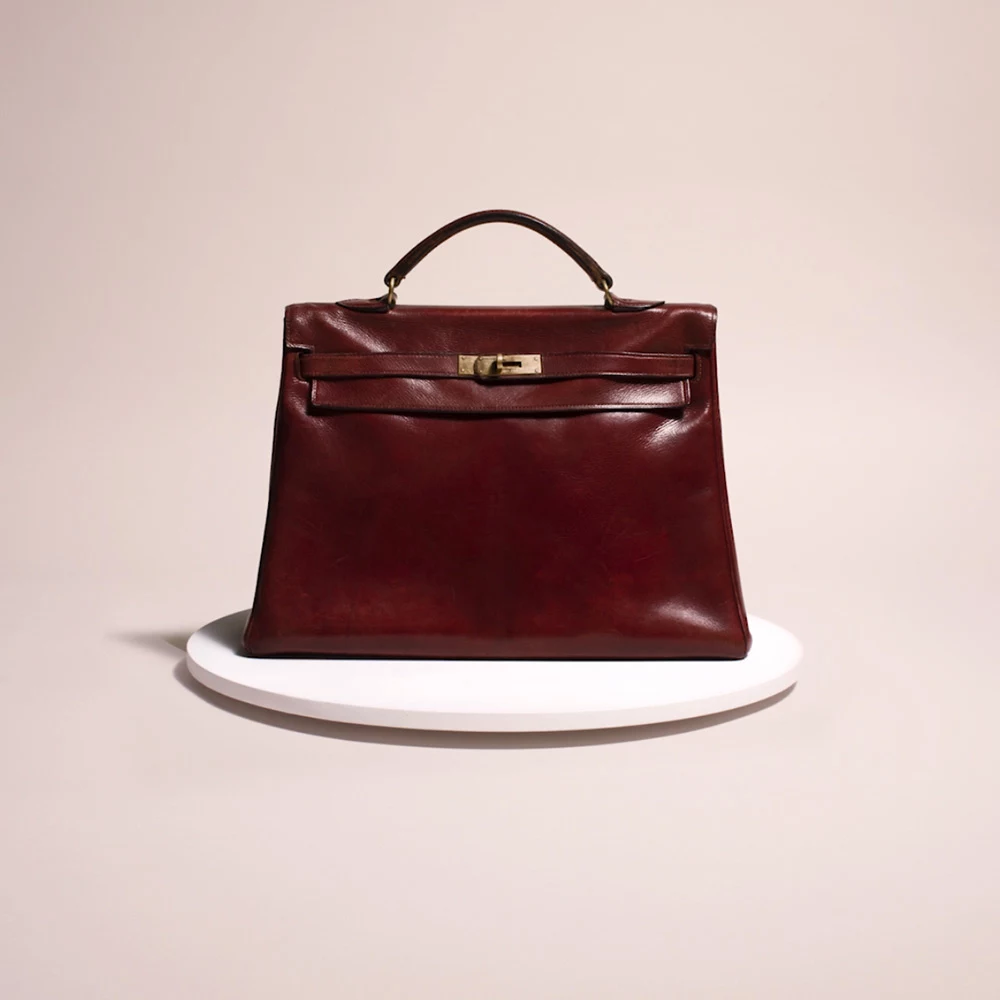
Image courtesy: Hermès
Why Leather Choice Matters in Hermès Handbags
Fundamental to creating any Hermès leather product is the careful selection of materials. Whether the leather inspires the design or the design dictates the choice of leather, each material is chosen to enhance the functionality and visual appeal.
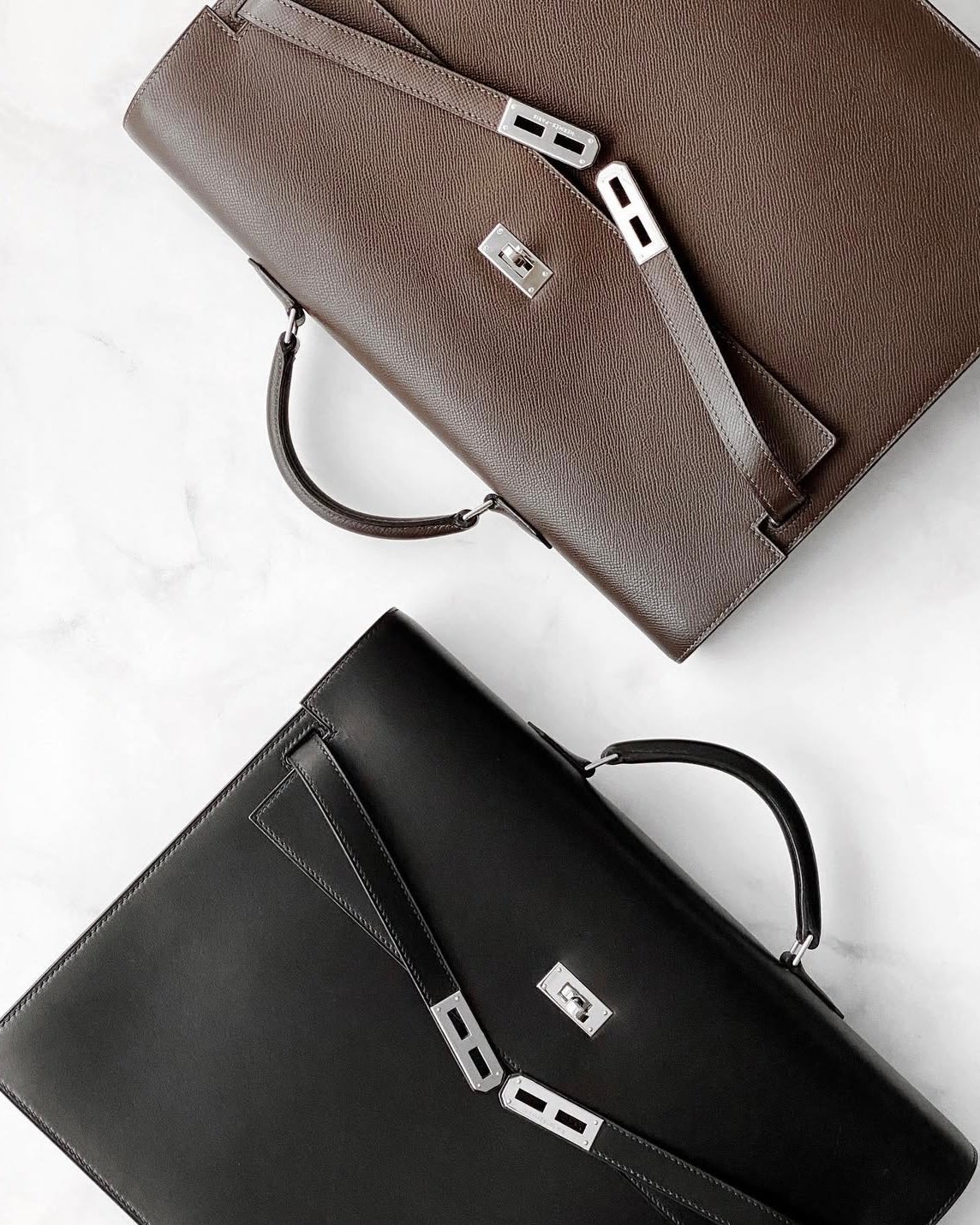
Image courtesy: @heynixon
Impact on Aesthetics and Functionality
The choice of leather used in a Hermès piece doesn’t just serve a functional purpose – it’s a key factor in shaping the bag’s overall aesthetic. Each type possesses distinct properties – some are suited for everyday wear due to their casual appearance and durability; others, such as exotic skins, excel in special occasions and infrequent use.

Image courtesy: @thebirkinboy
Investment Value
As you might expect, the value of Hermès products is heavily influenced by the choice of leather. Retail pricing varies accordingly, with exotic skins like Crocodile and Alligator commanding higher price tags than classic leathers such as Togo or Epsom. Beyond the initial cost, the type of leather plays a crucial role in determining retained value, affecting both resale potential and collectibility.
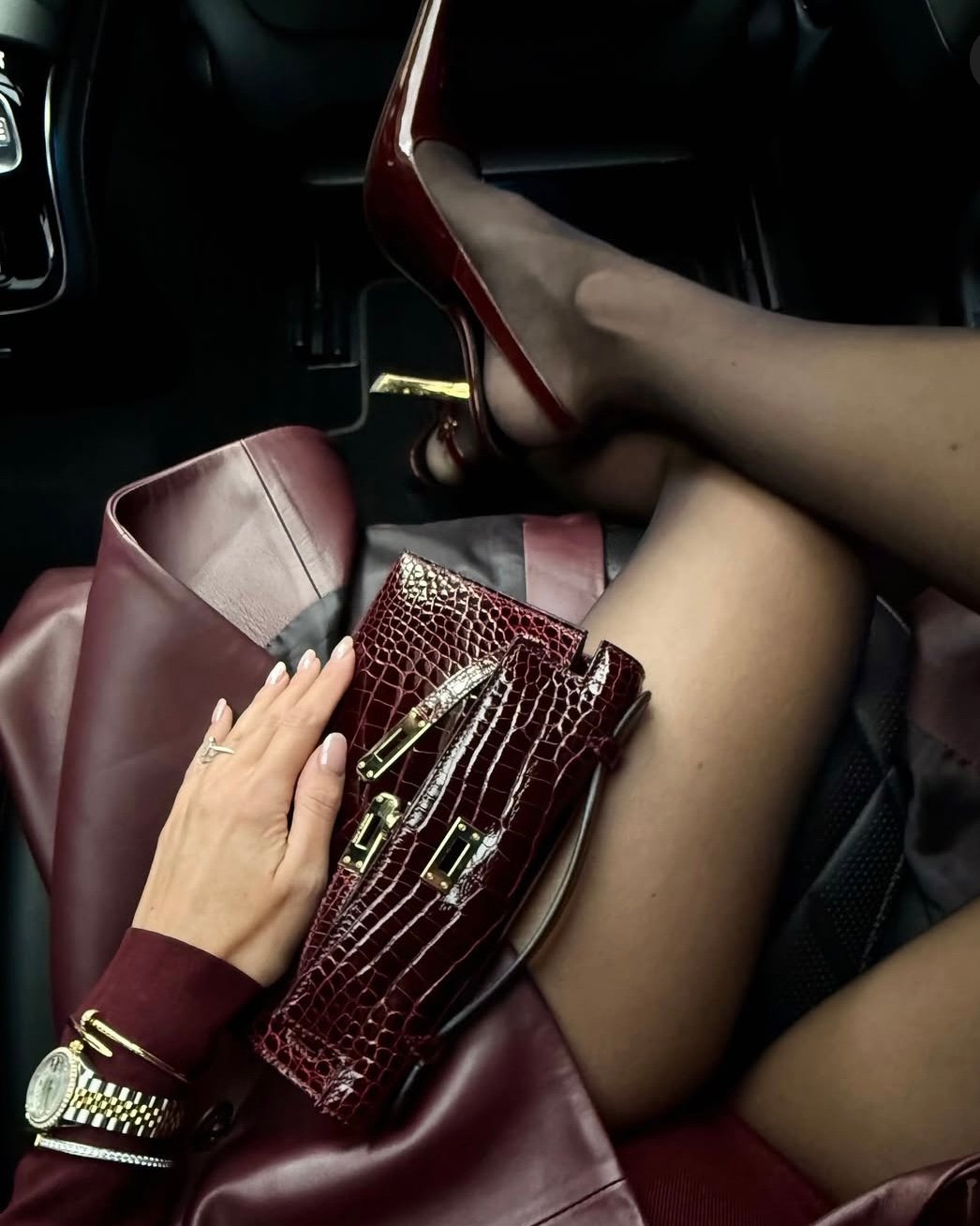
Image courtesy: @leoniehanne
Exploring Hermès’ Top 10 Leathers
It’s easy to feel overwhelmed when asked to choose a Hermès leather. After all, there are more than 40 options available. To make things simpler, we’ve curated this list of the 10 most popular types of leather, exploring their distinctive features, unique properties, ideal uses, and essential care tips.
Textures of Top 10 Hermès Leathers
| Leather | Texture |
| Togo | Pebbled |
| Clemence | Larger Pebbled |
| Epsom | Embossed, crosshatched |
| Swift | Smooth |
| Box Calf | Semi-glossy, fine grain |
| Barenia | Smooth |
| Chèvre de Coromandel | Soft, iridescent |
| Chèvre Mysore | Soft sheen, fine grain |
| Evercolor | Satin finish, tight grain |
| Sombrero | Smooth, matte finish |
Togo Leather
Togo leather, introduced in 1997, is one of the most popular choices in the Hermès leather lineup, favored for its appearance and durability. Made from calfskin, it is characterized by a fine grain and semi-matte finish. Togo features a distinctive pebbled pattern that feels smooth. Occasionally, you may encounter Togo leather bags with visible veining, which can vary from hide to hide, adding to their unique character.

Togo Leather
Due to its textured surface, Togo leather is easy to maintain and is less prone to scratches. Its ability to hold shape makes it ideal for various bag styles, particularly the Birkin and Kelly. Additionally, Togo is relatively lightweight compared to other full-grain leathers, making it a favored option for larger bags like the Birkin 35. Available in classic neutrals and seasonal shades, popular color choices include Noir, Gold, and Étoupe.
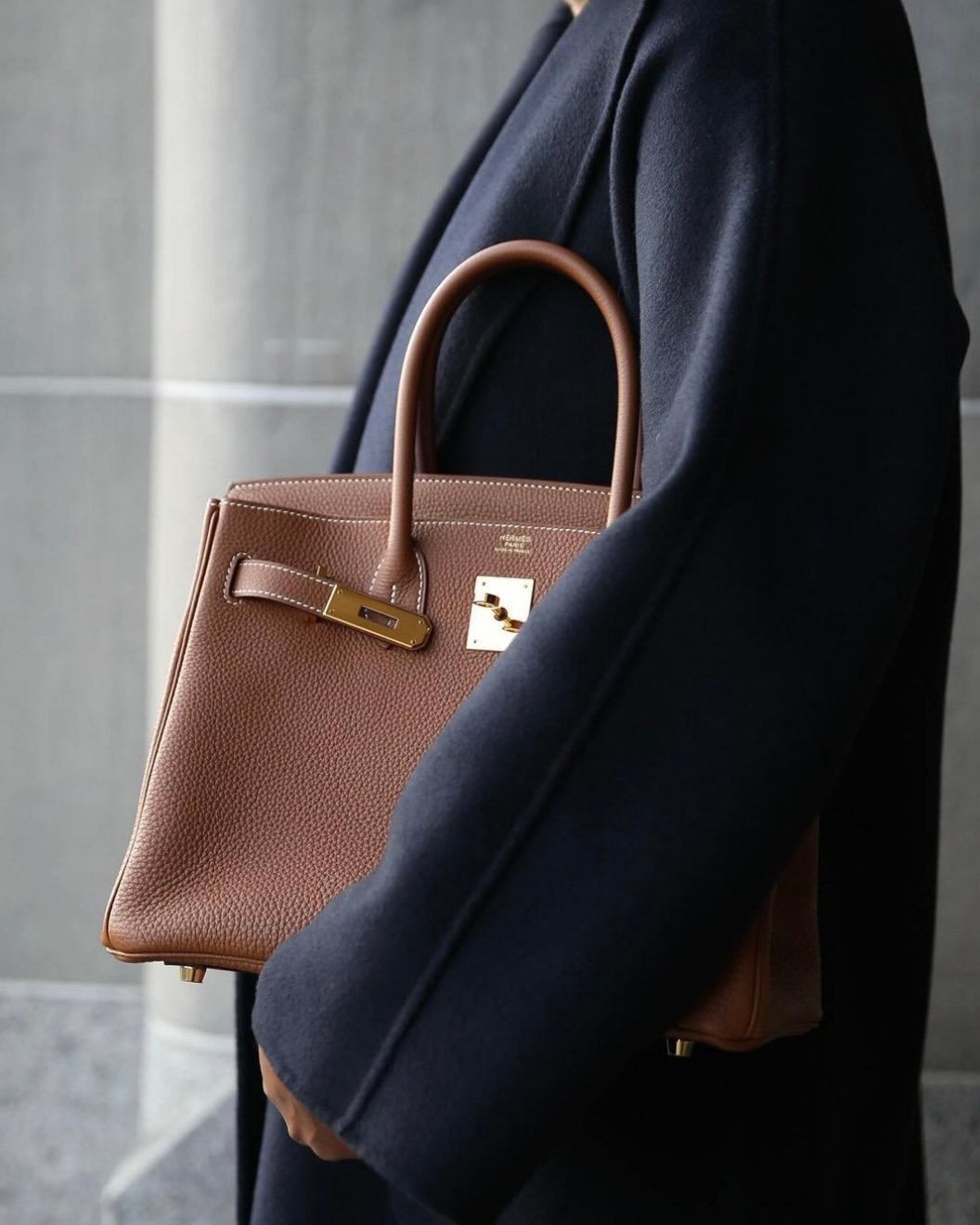
Image courtesy: @steffysstyle
Caring for Togo
To maintain the beauty and longevity of Togo leather, follow these essential care tips:
- Regular Cleaning: Wipe your bag with a soft, lint-free cloth to remove dust and dirt.
- Avoid Overloading: Do not overfill your bag, as this can distort its shape.
- Proper Storage: Keep your Togo bag away from direct sunlight and moisture. When not in use, insert tissue paper or bubble wrap to help maintain its silhouette.
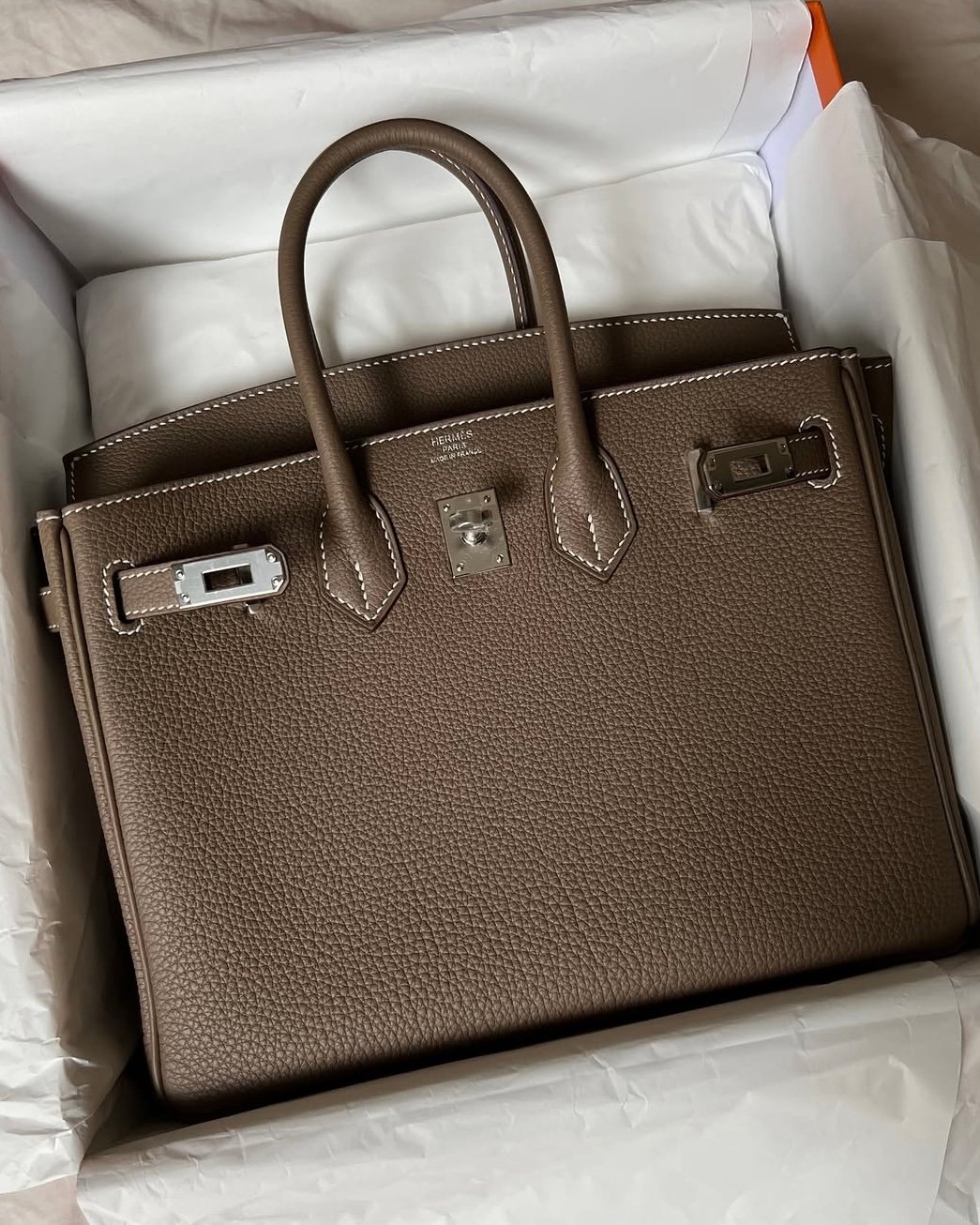
Image courtesy: @masha_lobanovaa

Image courtesy: @imnotahermesholic
Clemence Leather
Clemence, also known as Taurillon Clemence, is a durable leather made from bull-calf hide. Introduced in the 1990s, it features a pebbled-grained surface with a semi-matte finish. While similar to Togo, Clemence has slightly larger and flatter grains as well as a softer, more supple feel, lacking the pronounced veining sometimes seen in Togo.

Clemence Leather
This luxuriously thick leather offers a relaxed aesthetic, making it ideal for larger handbags. You’ll most commonly find Clemence in popular designs like the Picotin, Lindy, and the Evelyne.
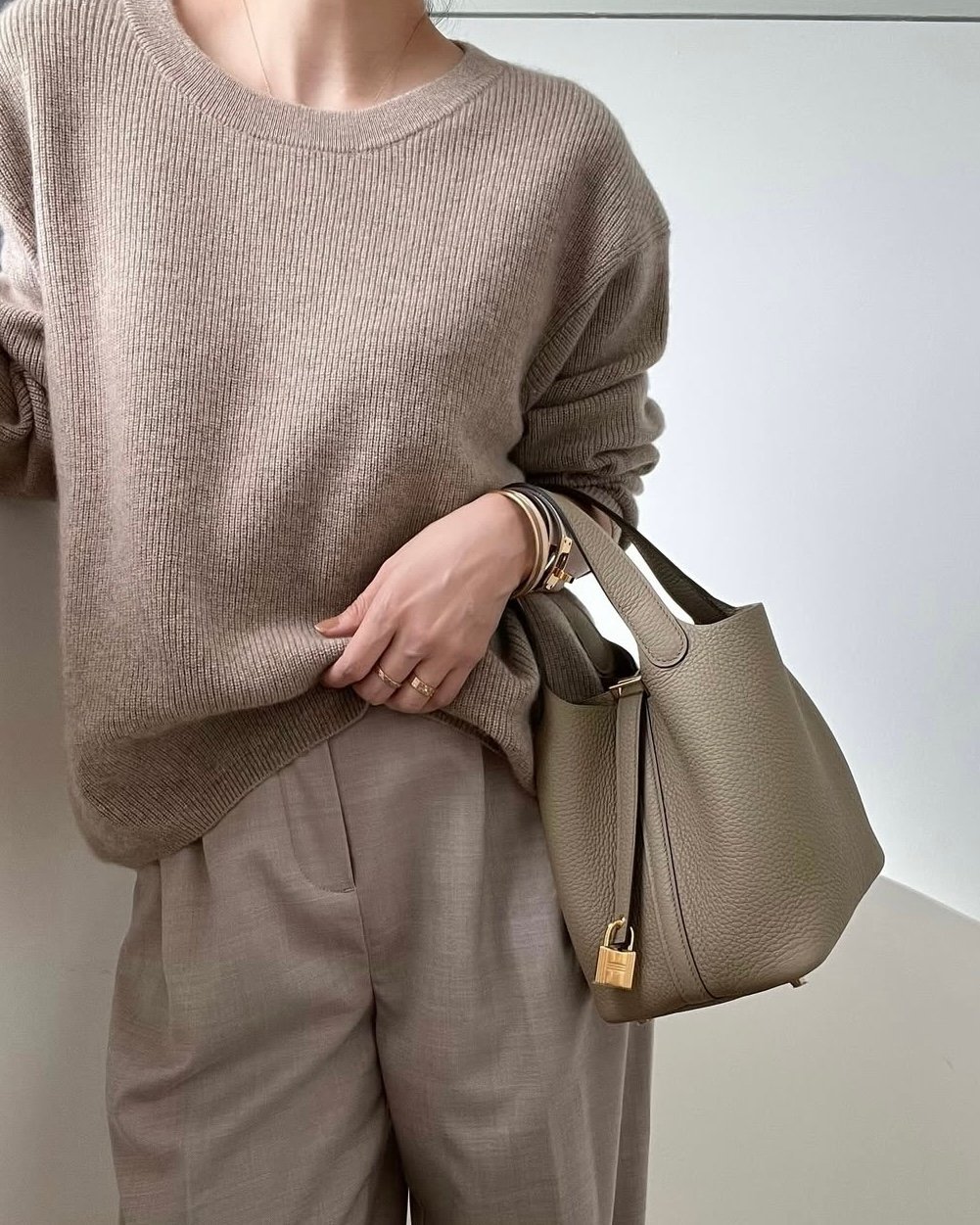
Image courtesy: @vk_8112
Clemence Leather Care
Caring for Clemence leather is similar to Togo, but the thicker, softer texture gives it a more casual, slouchy appearance over time. To keep it looking its best, follow these additional care guidelines:
- Water Exposure: Keep your Clemence bag away from inclement weather. If you’re caught in a sudden storm, gently pat it dry with a soft, clean cloth.
- Avoid Overloading: Overstuffing can accentuate and accelerate slouching, so be mindful of how much you pack.
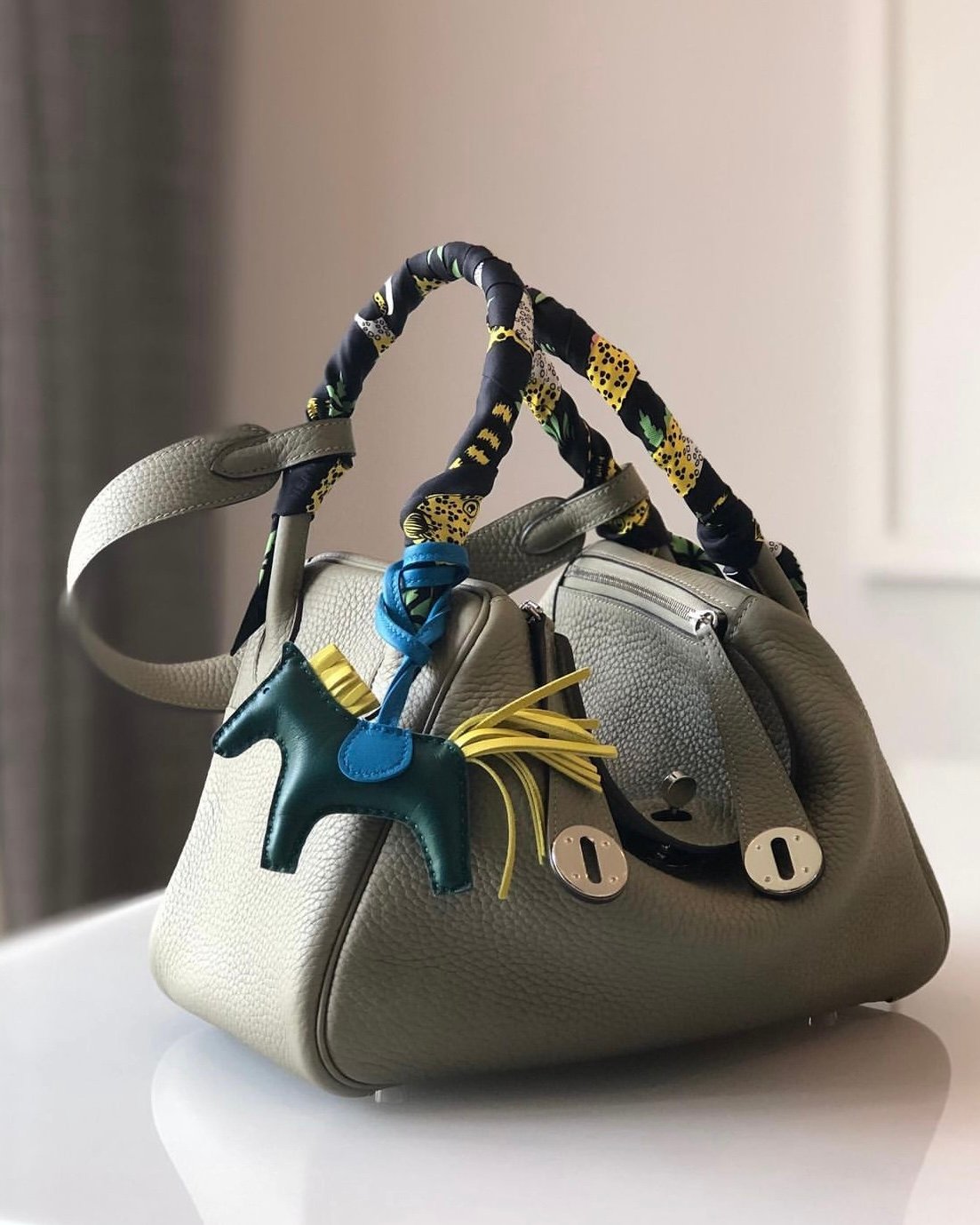
Image courtesy: @colorful_noir

Image courtesy: @imnotahermesholic
Epsom Leather
Epsom leather, made from calfskin, is recognized for its embossed grain with a cross-hatched design, created through heat-pressing, which gives it a rigid appearance and scratch-resistant properties. Introduced in 2004 as a replacement for Courchevel, Epsom is one of Hermès’ most lightweight leathers. Known for its fantastic color retention, Epsom also boasts an attractive sheen.

Epsom Leather
Epsom’s rigid structure ensures bags maintain their shape over time, making it a popular choice for Birkin, Kelly, and Mini Kelly bags in the Sellier-style construction. However, this rigidity can make opening and accessing smaller bags like the Mini Kelly more challenging.
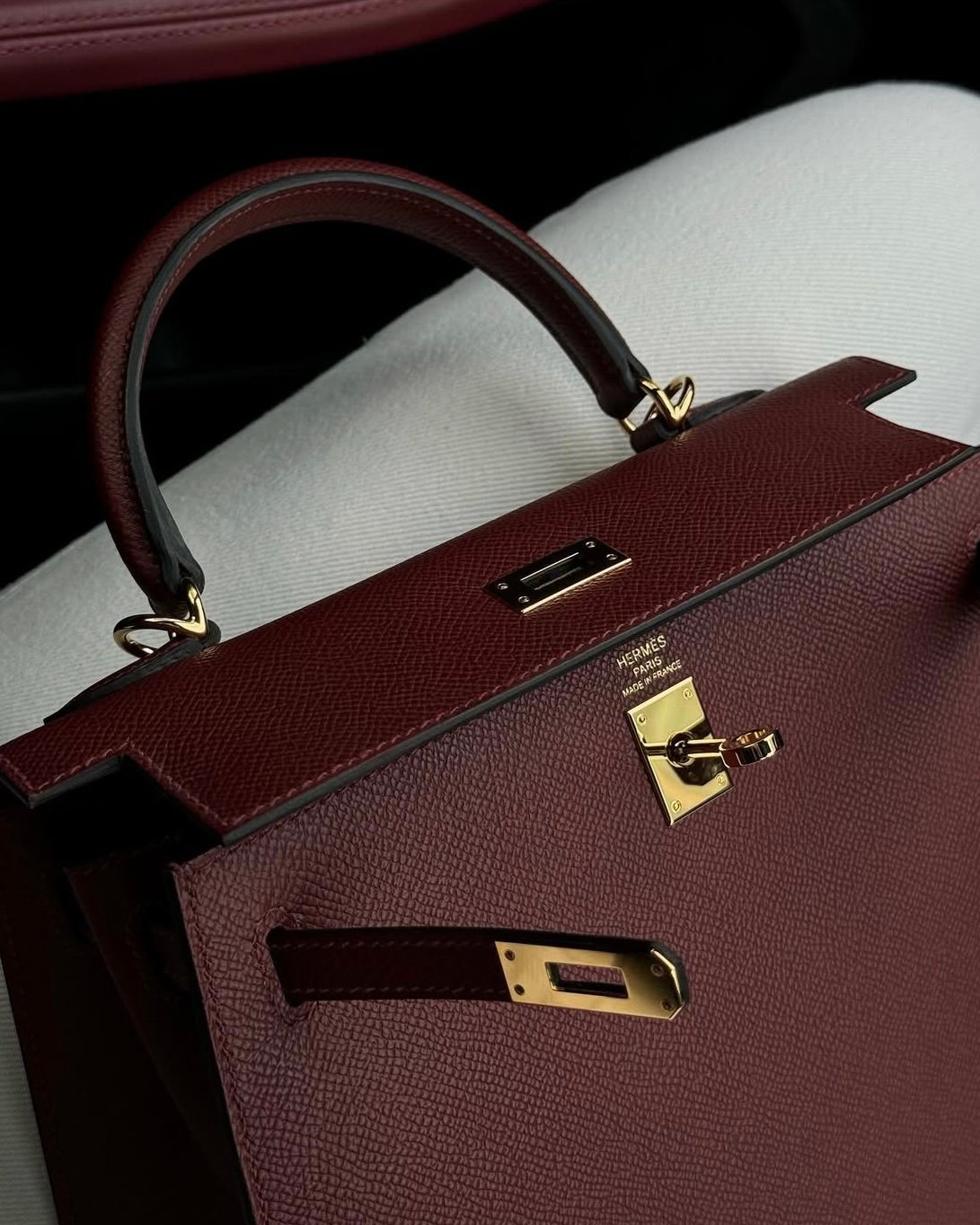
Image courtesy: @anjelicamar
Maintaining Epsom Leather
While Epsom leather is relatively easy to care for, thanks to its durability and water-resistant properties, there are a few things to keep in mind to ensure it stays looking its best:
- Water Exposure: Epsom leather is considerably more durable if caught in the rain; however make sure to promptly and gently pat it dry with a soft, clean cloth.
- Be Mindful of Overloading: Avoid packing your bag too tightly, as overstuffing can cause Epsom to slouch and lose its shape.
- Maintaining Shape: Refrain from bending or folding the leather, as its rigid, pressed texture can develop visible creases that are often irreversible.
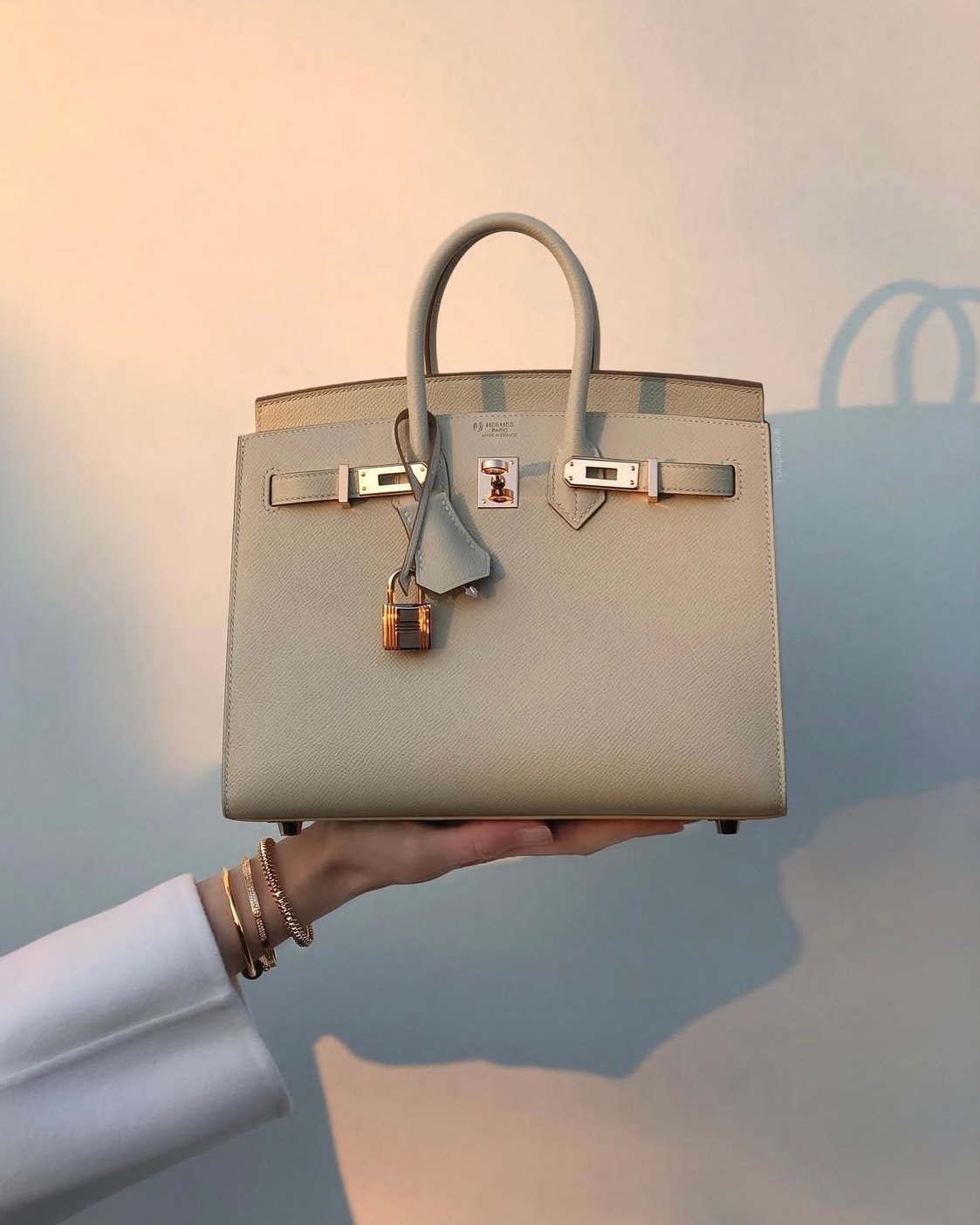
Image courtesy: @mrandmrs.j
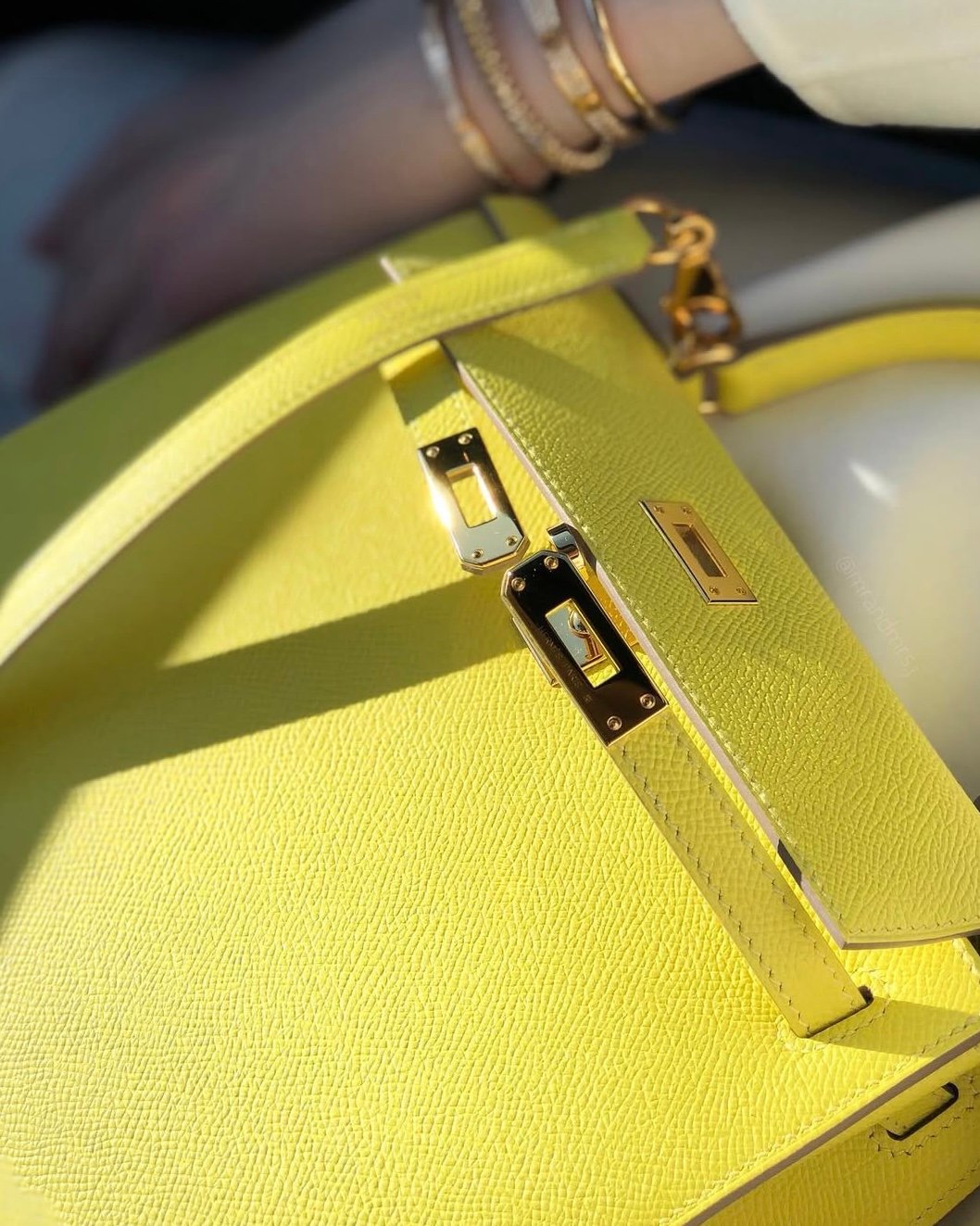
Image courtesy: @mrandmrs.j
Swift Leather
Previously known as Gulliver, which was discontinued in 1999, Swift leather was introduced in 2005 as a replacement with similar properties. This calfskin is characterized by its fine natural grain that offers smoothness and a slight sheen. Favored for its exceptional color absorption, Swift leather provides vibrancy that is unmatched by many other Hermès leathers.

Swift Leather
Hermès Swift leather is typically reserved for smaller bags such as the Kelly Pochette, Kelly Moove, Kelly Cut, and Constance. Additionally, it is often used in a variety of accessories, including jewelry, particularly Hermès leather bracelets, which showcase the leather’s supple texture and vibrant hues in a petite format.
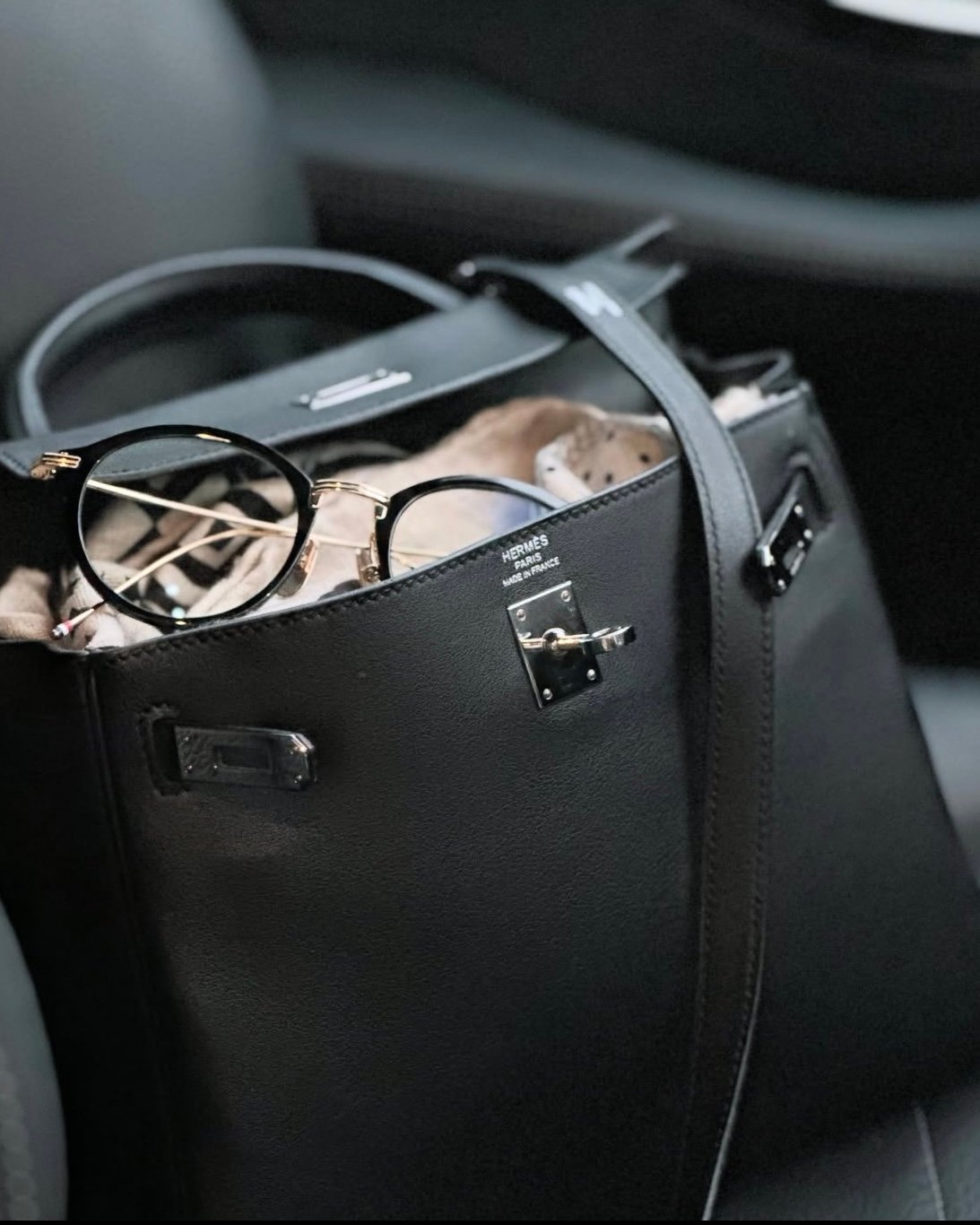
Image courtesy: @votre.propre.vie
Swift Leather Care
Despite its softness, Swift leather is surprisingly durable and able to withstand wear and tear over time. However, its supple texture does make it more prone to visible scratches. To minimize this risk, consider these care tips:
- Regular Cleaning: Wipe your bag down with a soft, lint-free cloth after use to remove dust and dirt.
- Avoid Overloading: Retain from overloading your bag or packing irregularly shaped items.
- Proper Storage: To prevent slouching, stuff larger Swift bags with tissue (but avoid overstuffing) while storing.

Image courtesy: @masha_lobanovaa
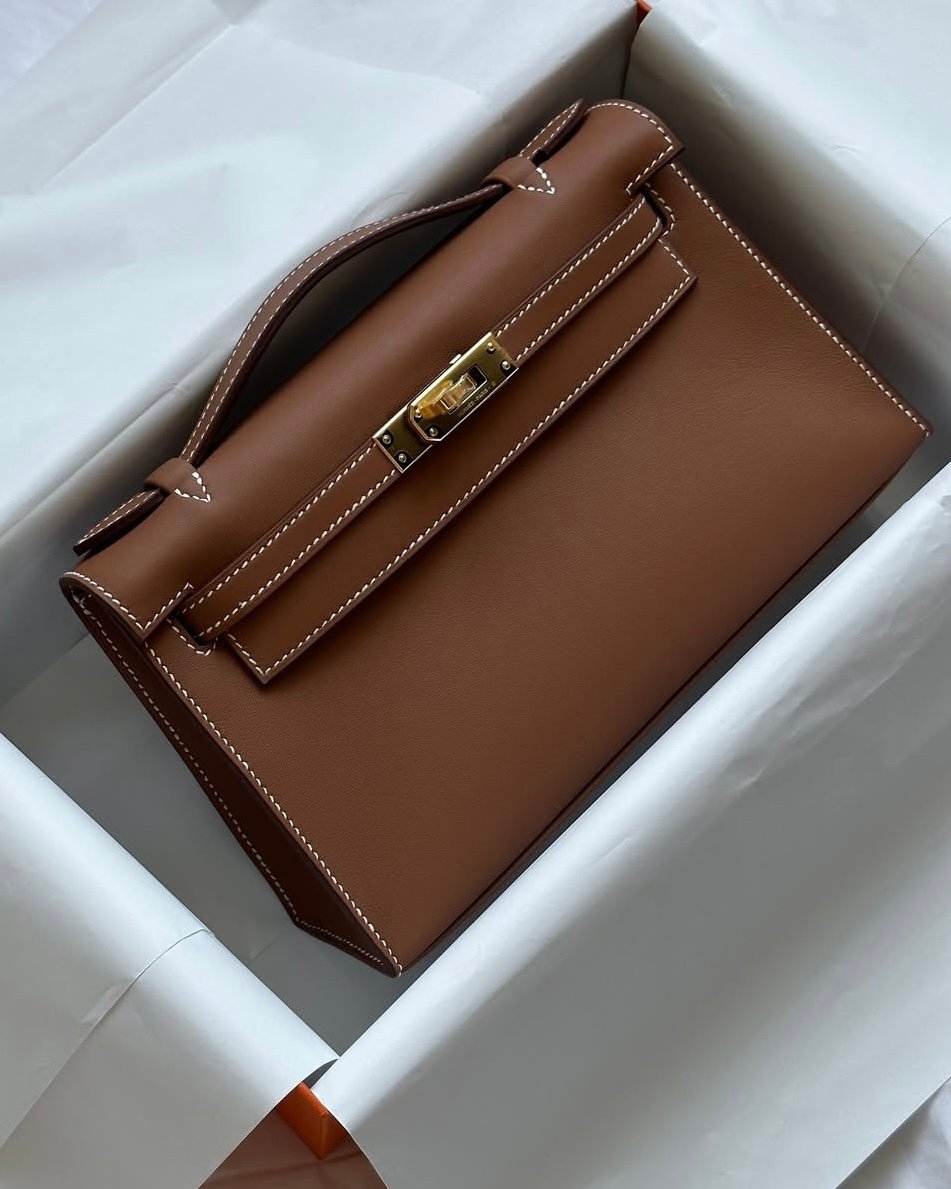
Image courtesy: @masha_lobanovaa
Box Calf Leather
Box Calf is Hermès’ oldest leather, boasting a history that spans over 130 years, dating back to the 1890s, and it is still in production today. Named after the 19th-century English shoemaker Joseph Box, this iconic leather features a distinctively smooth and semi-glossy finish and a fine grain. Its rigid, ‘boardy’ (a term used within the leather-making community to refer to leather’s stiffness) feel makes it particularly well-suited for structured bags like the Kelly Sellier. This leather exudes a timeless sophistication, prized for its elegant appearance. However, its smooth surface scratches very easily, so you may find yourself babying it and/or visiting the Hermès spa frequently. This leather exudes a timeless sophistication, prized for its elegant appearance.
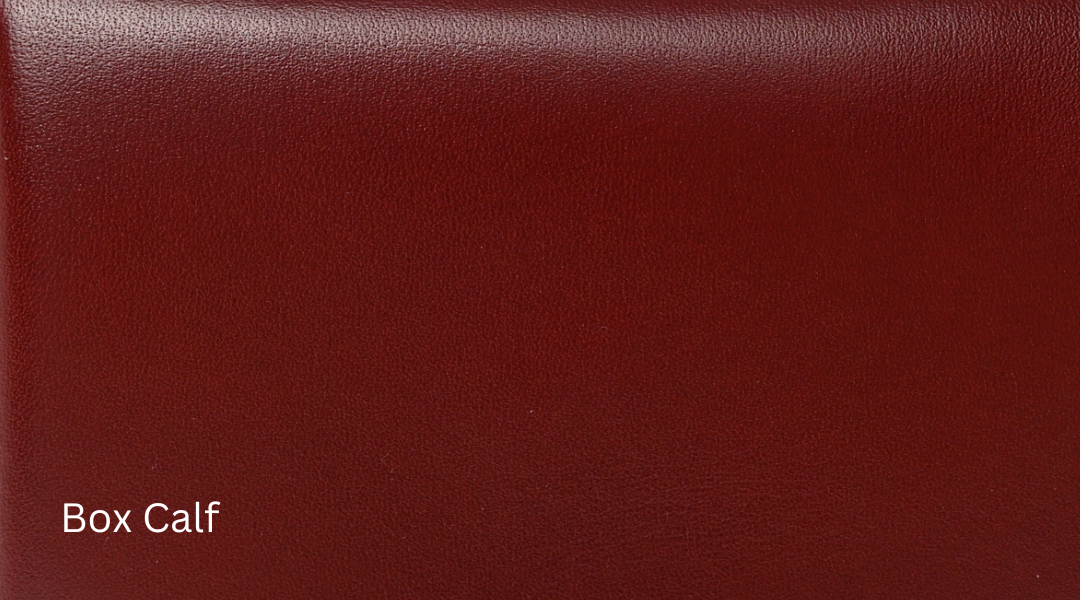
Box Calf
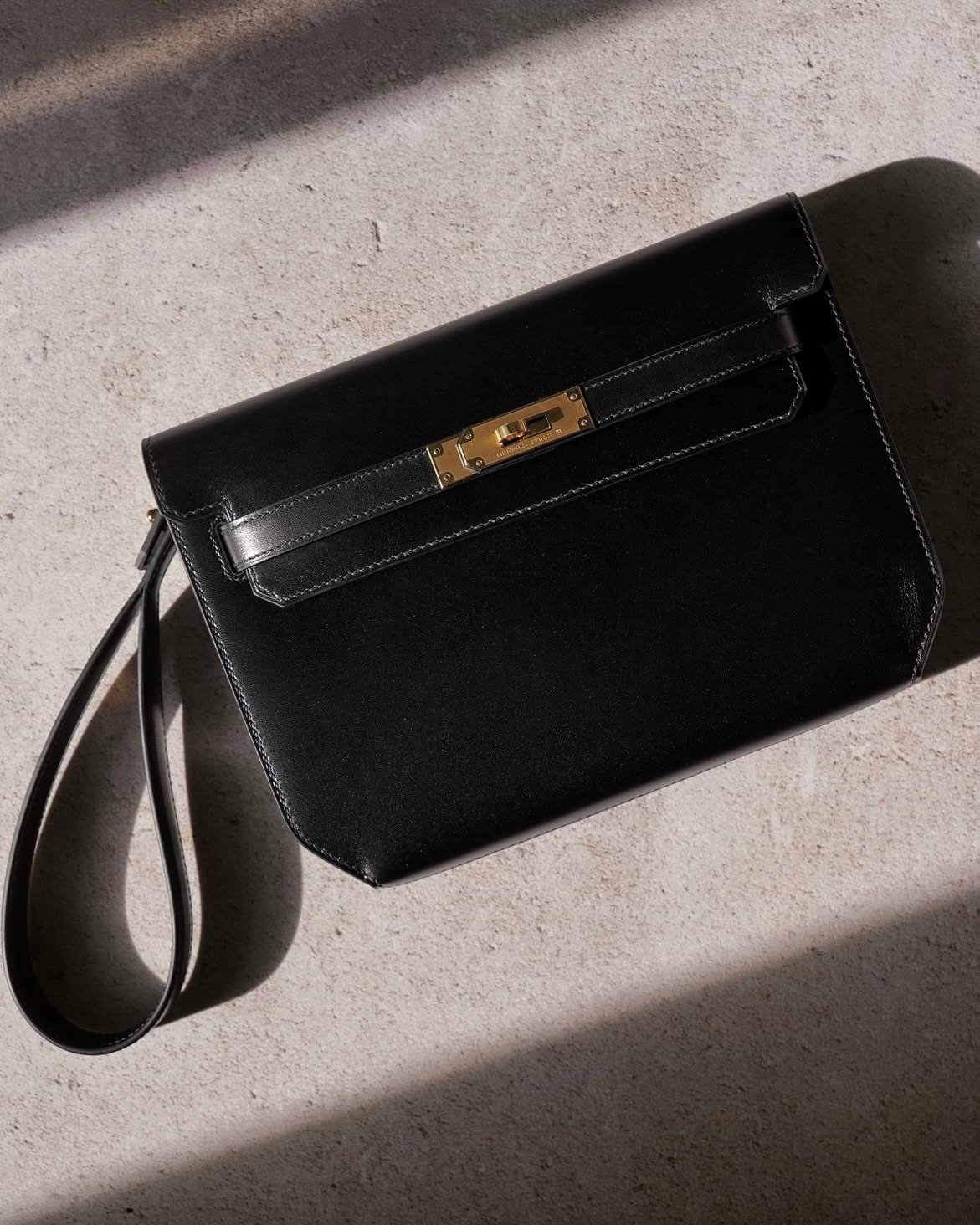
Image courtesy: @heynixon
Caring for Box Calf
Caring for Box Calf comes with some important considerations. Perhaps the most unique characteristic is the way it develops a beautiful patina over time, telling the story of your handbag. To maintain its exquisite look and ensure longevity, careful maintenance is essential:
- Water Exposure: Avoid wet conditions to prevent blistering.
- Scratch Maintenance: Light scratches can often be buffed out with a clean, dry cloth, while deeper ones may require assistance from the Hermès Spa.
- Patina Development: Embrace the natural aging process, as the patina enhances the leather’s character over time.
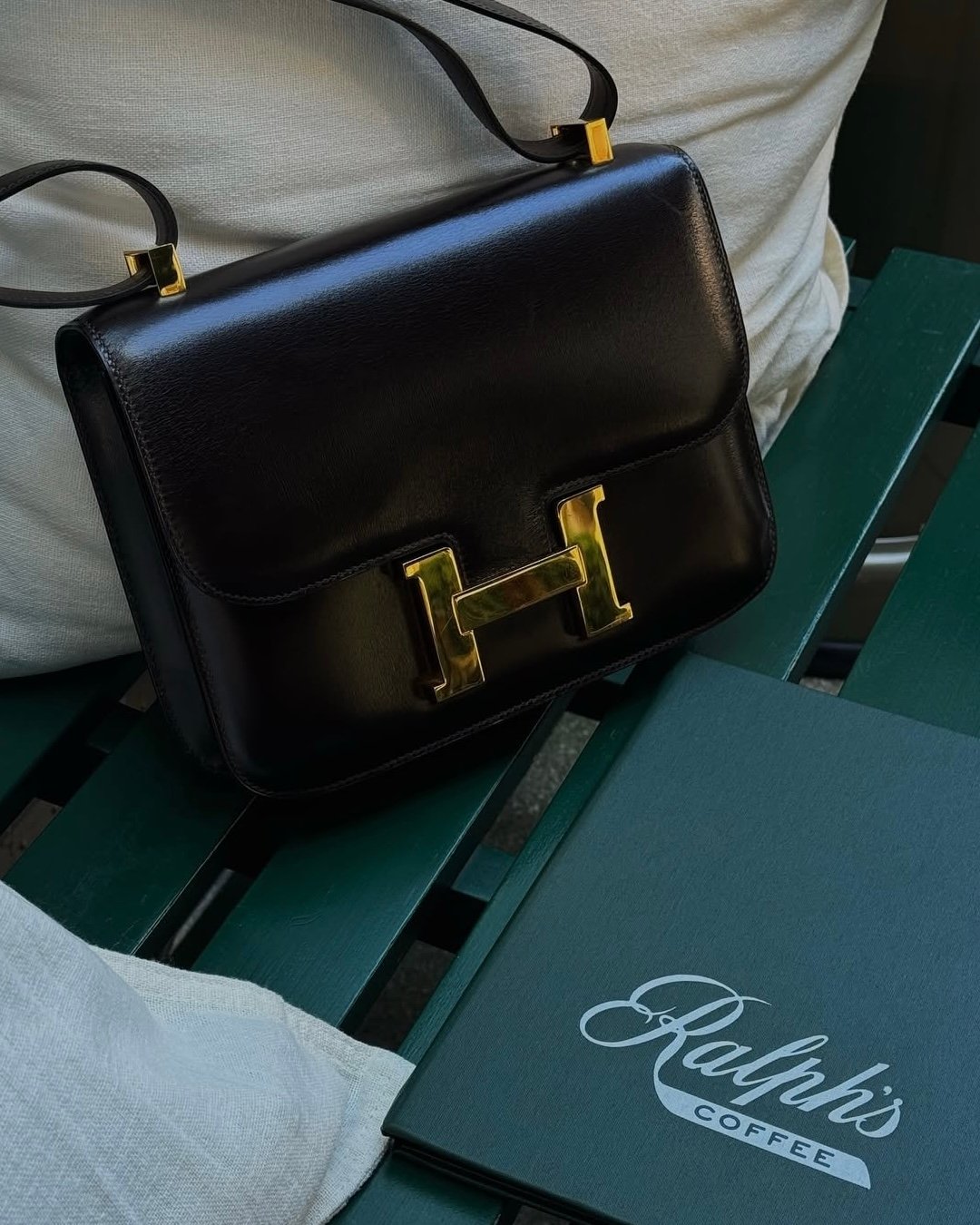
Image courtesy: @the.life.of.niels
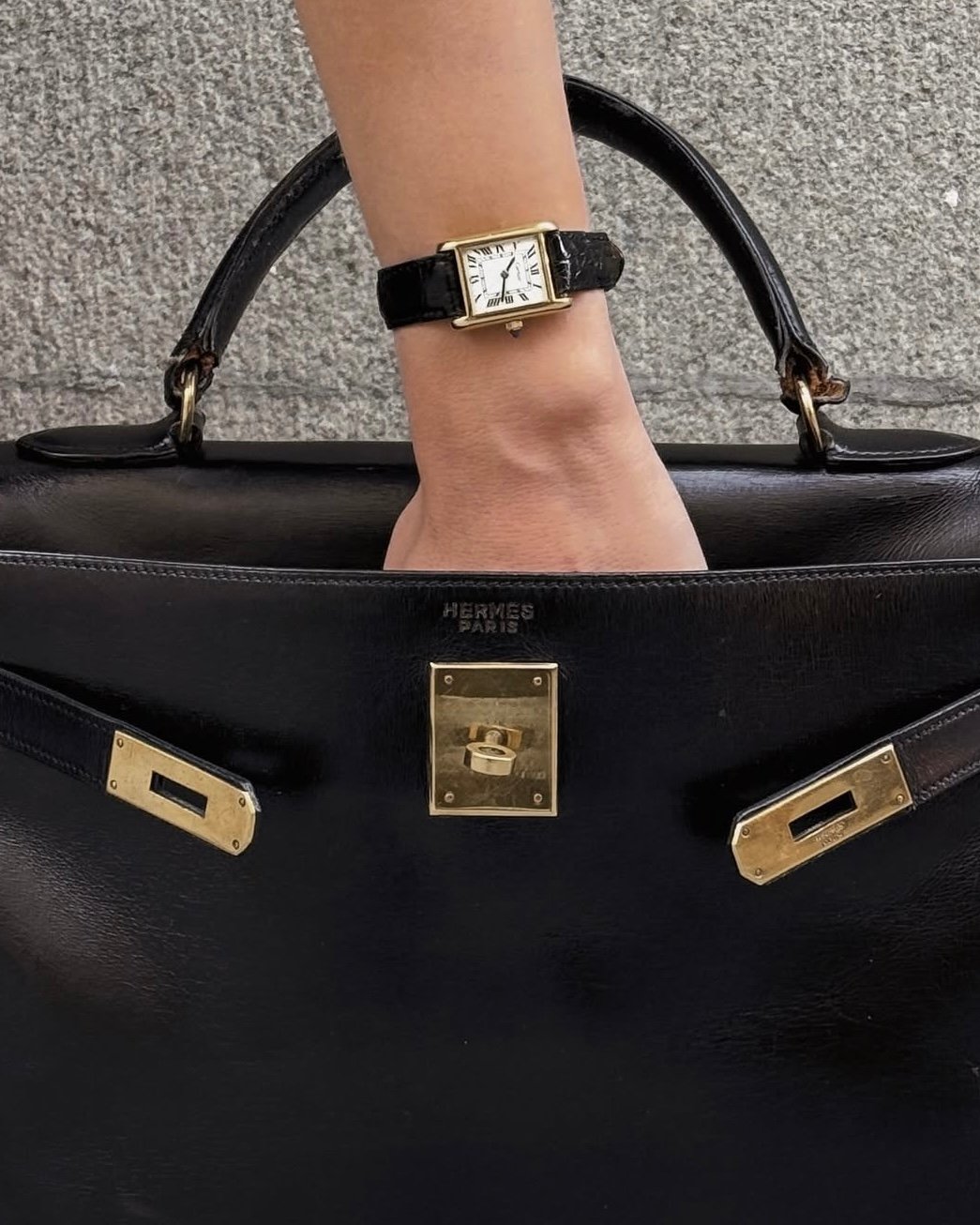
Image courtesy: @isolinafedel
Barenia Leather
Barenia leather has long been an iconic leather at Hermès, originally used in saddle making. Known for its smooth finish, durability, and water resistance, it has become a favorite in equestrian circles. In the 1970s, Hermès incorporated Barenia into handbags, and it remains a Heritage leather today, known for its time-consuming tanning process that involves double tanning with chrome and vegetable dyes, followed by a five-week oil soak.
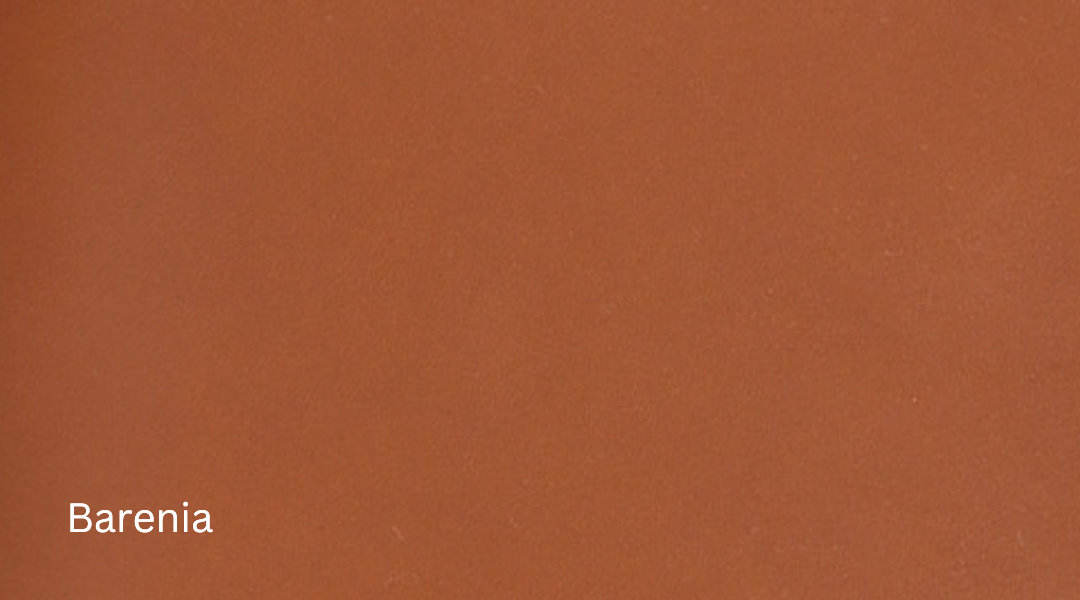
Barenia
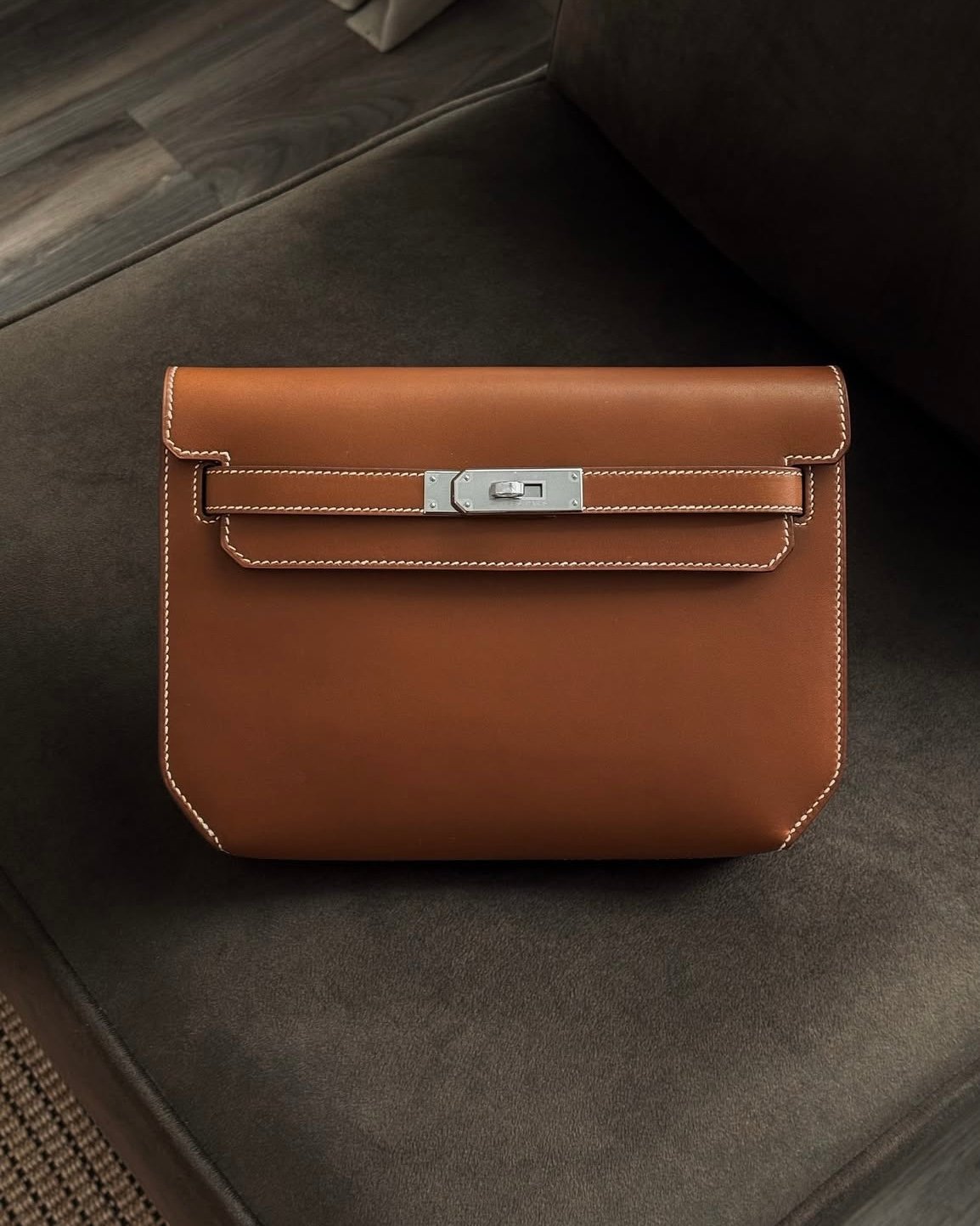
Image courtesy: @heynixon
Preserving Barenia Leather
One of Barenia’s standout features is its ability to develop a rich patina over time, aging gracefully and enhancing its character. To keep Barenia looking its best and ensure it lasts for years, consider the following:
- Embrace the Patina: Embrace the natural aging process of Barenia, as the patina enhances the leather’s character over time.
- Water Exposure: If caught in the rain, noticeable water droplets will appear, but don’t panic – as the leather dries, these marks will disappear.
- Buff Light Scratches: Light scratches can often be buffed, while deeper ones will blend into the leather over time.
- Mind Your Contents: Avoid storing loose cosmetics, perfume, or pens in your Barenia bag, as any spills can result in permanent stains.

Image courtesy: @hpluxe
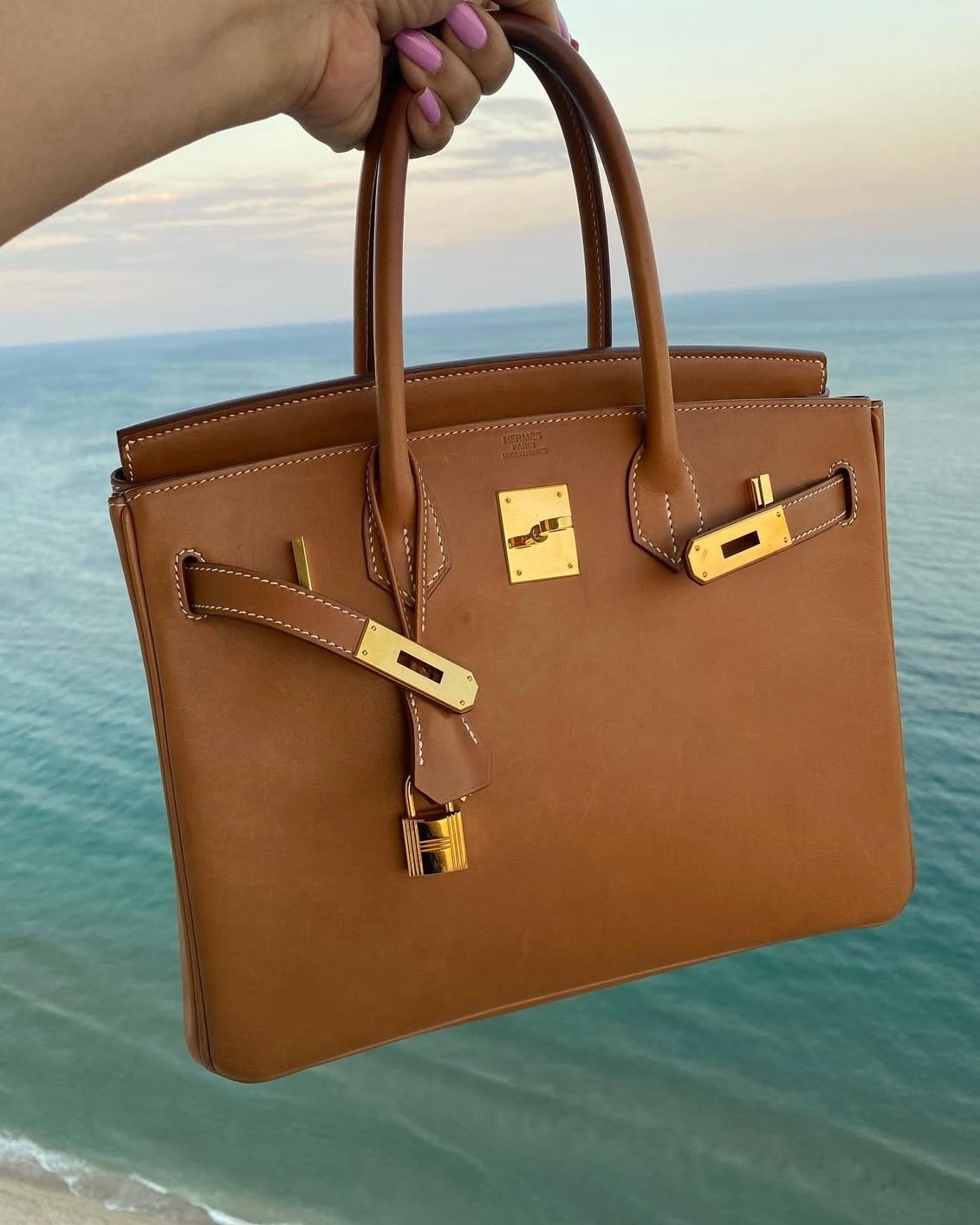
Image courtesy: @pursebop
Chèvre de Coromandel Leather
Chèvre de Coromandel is a highly coveted leather recognized for its iridescence, lightweight properties, and distinctive graining. Sourced from male mountain goats, Chèvre de Coromandel is exceptionally resistant compared to other Chèvre varieties. Despite its soft feel, it offers remarkable durability against scratches and blemishes.
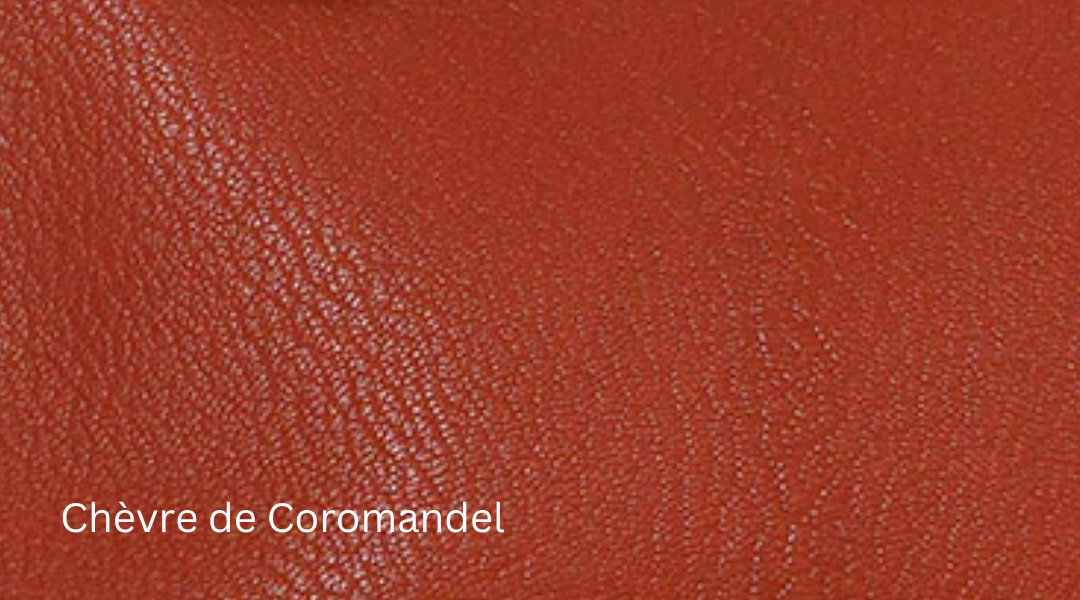
Chèvre de Coromandel
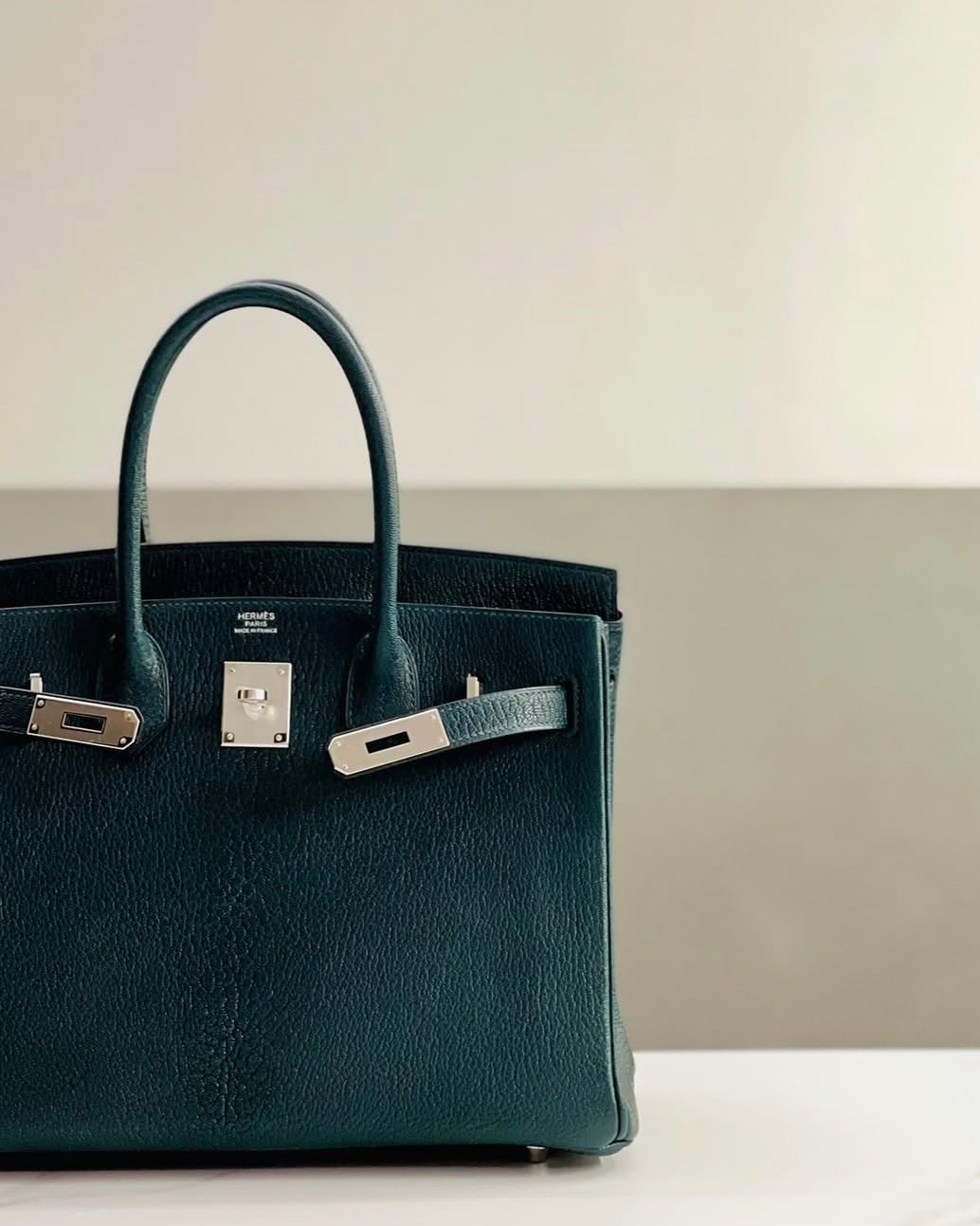
Image courtesy: @imnotahermesholic
Caring for Chèvre de Coromandel Leather
While as a whole, Chèvre leathers are considerably more durable than smooth calf skins – they still require attention and care. Consider these care tips:
- Maintain the Shine: To preserve its shine, regularly wipe the leather with a dry, lint-free cloth.
- Reduce Sun Exposure: Minimize sun exposure to help maintain Chèvre de Coromandel leather’s sheen.
- Avoid Dents: Be cautious with sharp or heavy items inside your bag, as Chèvre leather is prone to developing noticeable dents.
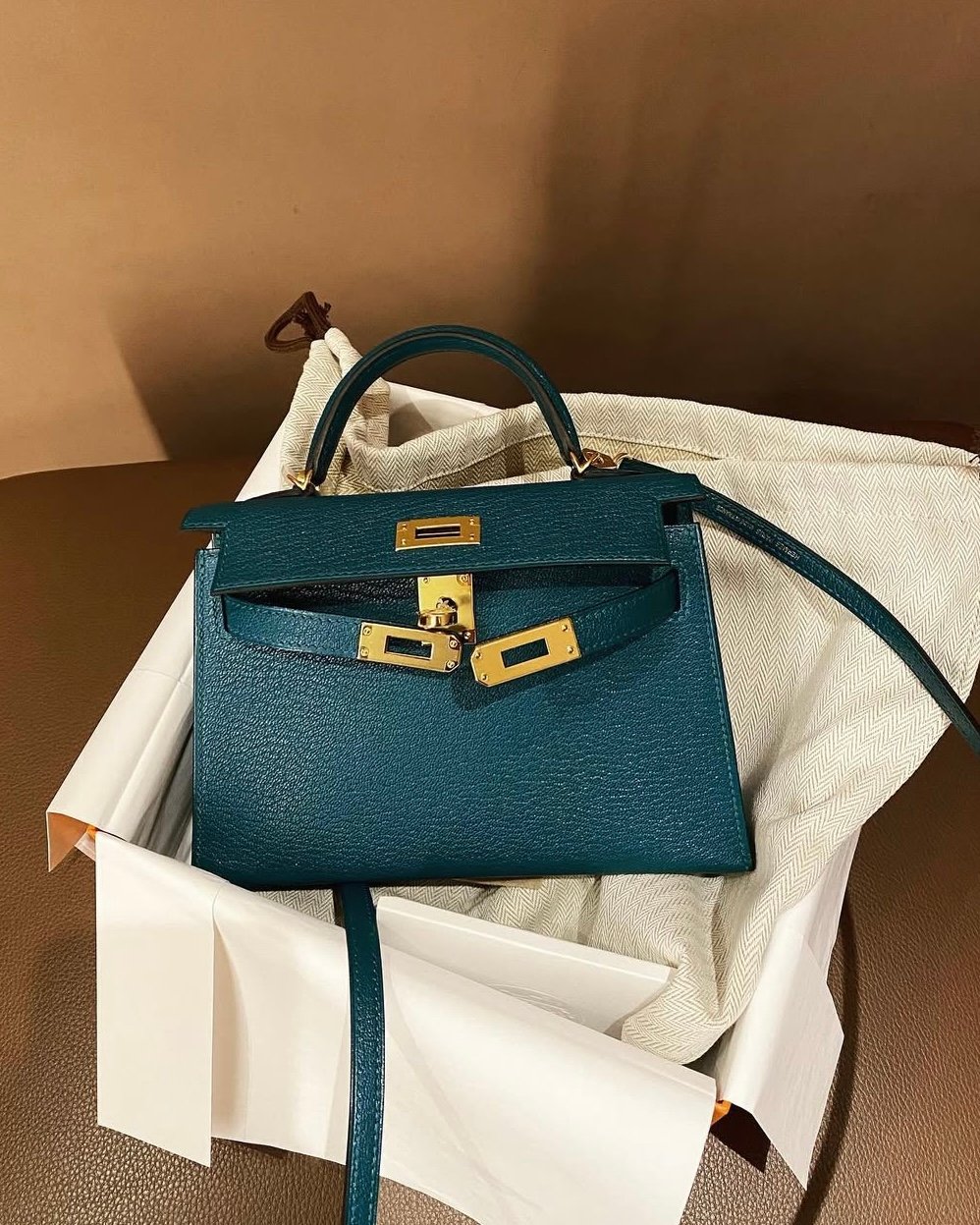
Image courtesy: @littlekkaren
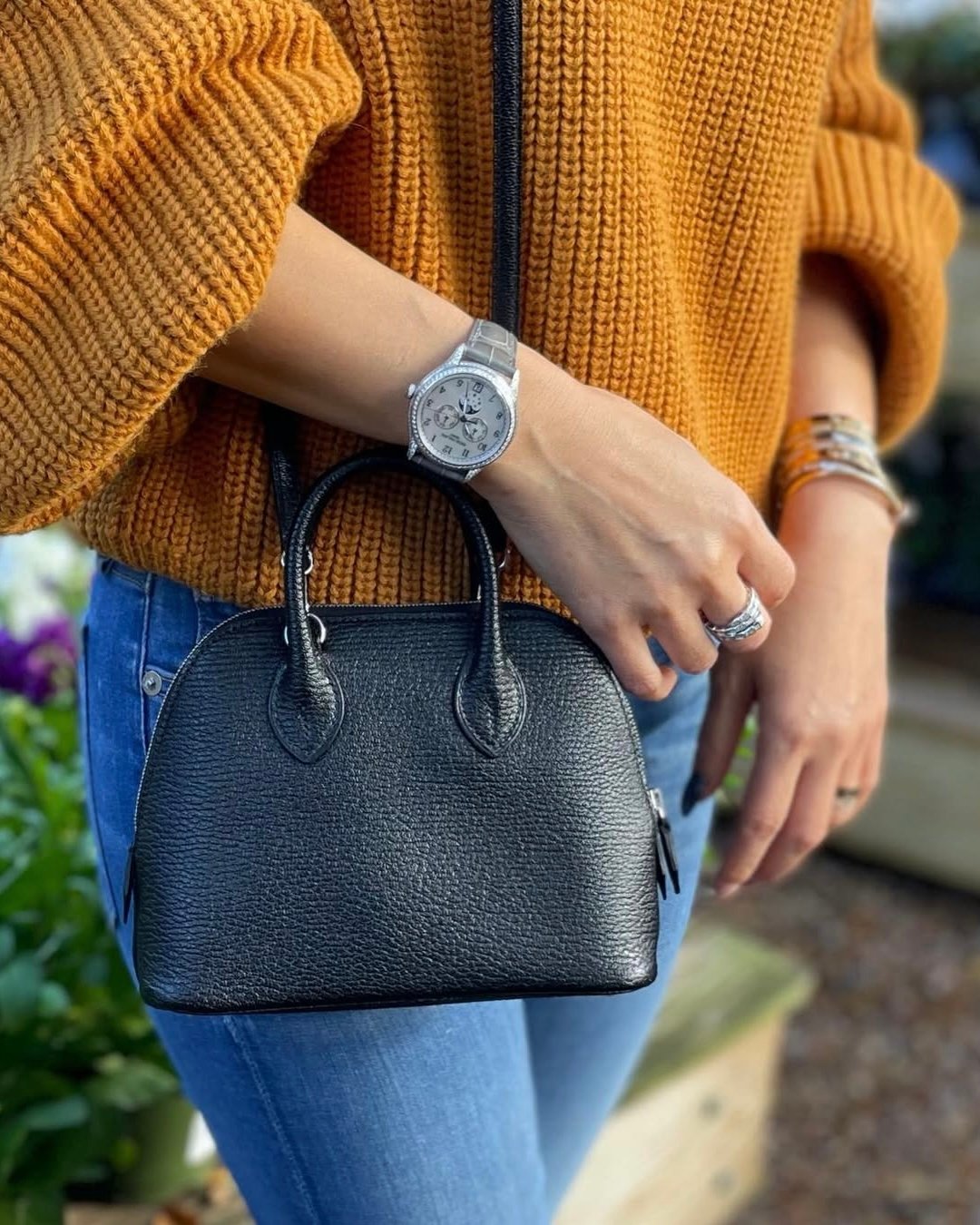
Image courtesy: @fnch310
Chèvre Mysore Leather
Chèvre Mysore, derived from goat hide, is currently Hermès’ most widely used goat leather. Like Chèvre de Coromandel, it offers a soft sheen, lightweight feel, and scratch resistance, but has a more refined grain. Chèvre Mysore can often be distinguished by a visible spine that runs down the center of many bags. This elegant leather is particularly favored for the Mini Kelly II.
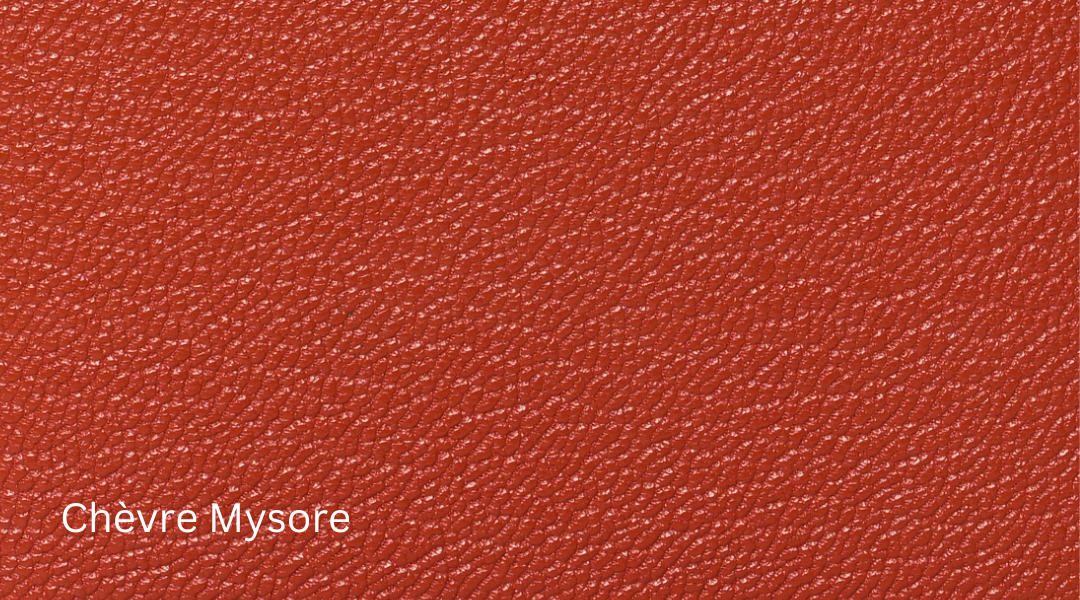
Chèvre Mysore
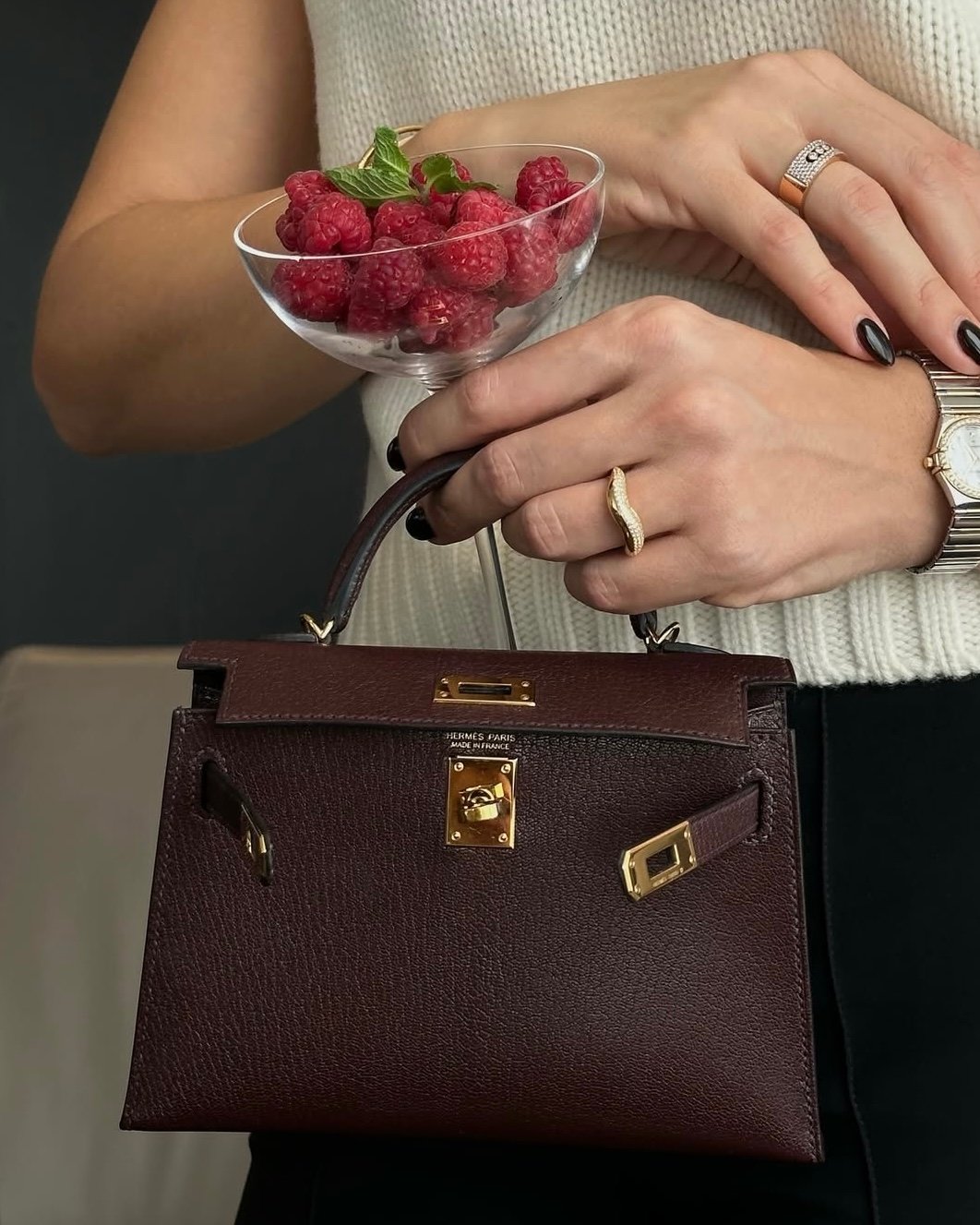
Image courtesy: @iitsninaaaa
Chèvre Mysore Leather Care Tips
Like Chèvre de Coromandel Leather, Chèvre Mysore also requires its own specialized care:
- Avoid Dents: Be mindful of sharp or heavy objects inside your bag, as Chèvre leather can develop noticeable dents.
- Keep the Shine: To maintain the shine of your Chèvre Mysore, avoid prolonged sun exposure and gently wipe down your bag with a soft, lint-free cloth after each use.
- Maintaining Shape: Chèvre leathers are prone to losing their shape over time. To help preserve their structure, avoid overfilling your bag and ensure it’s properly stuffed when storing.
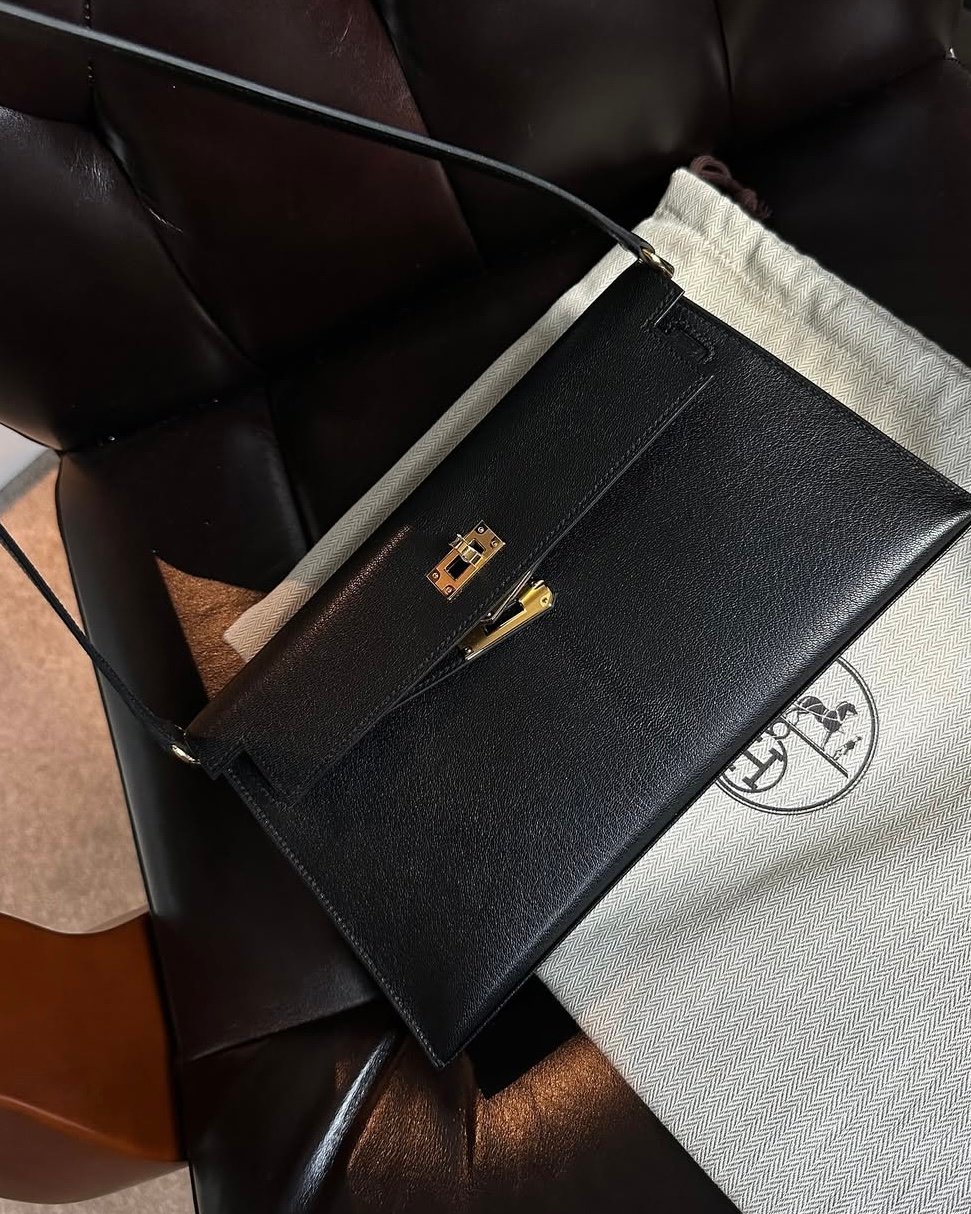
Image courtesy: @masha_lobanovaa
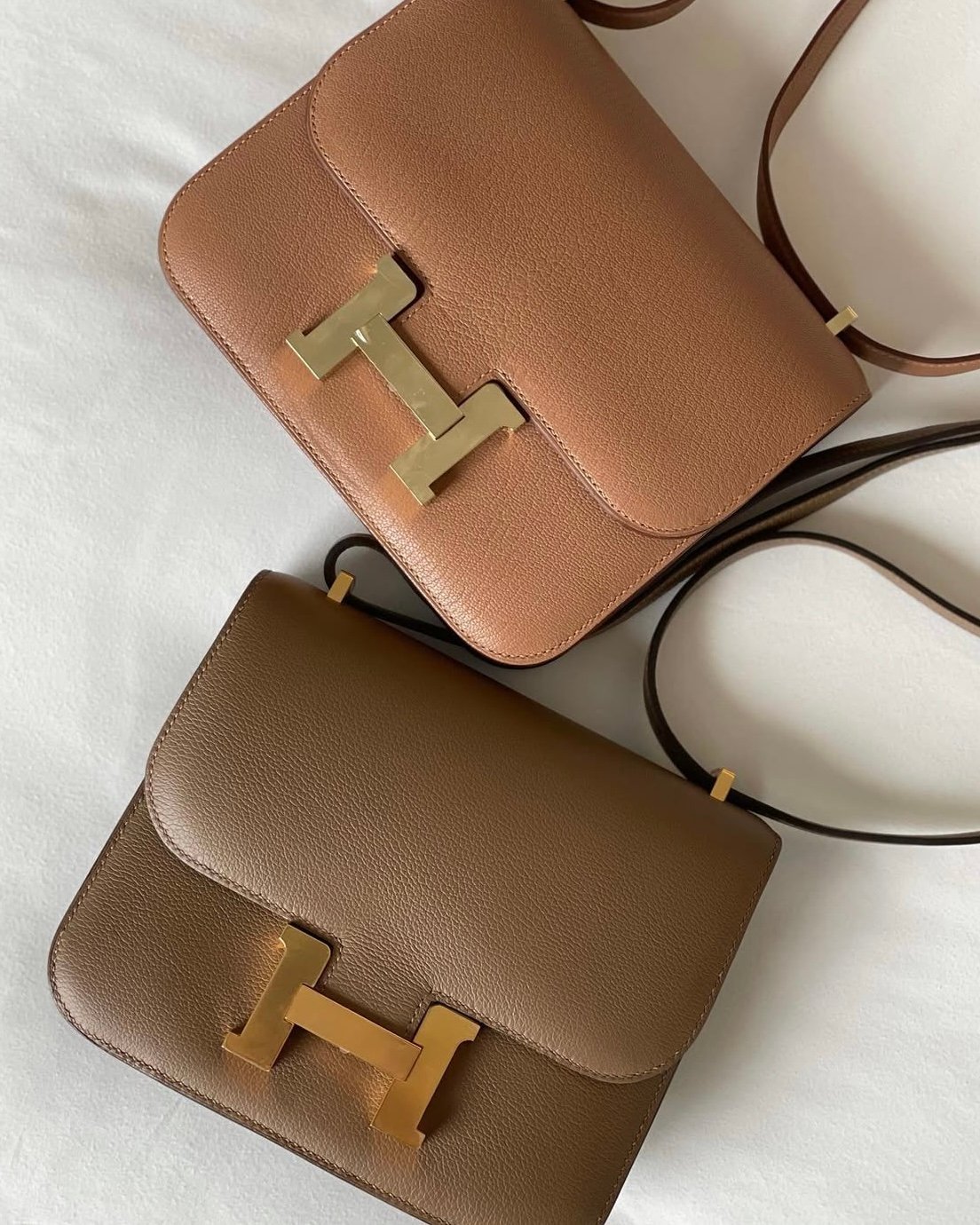
Image courtesy: @aline.inparis
Evercolor Leather
Introduced to the Hermès leather lineup in 2013, Evercolor is a pressed leather characterized by its tight grain, satin finish, and soft feel. Like other pressed leathers from Hermès, Evercolor offers excellent durability and fantastic color absorption. Initially popular for small leather goods, Evercolor has become a favored choice for handbags like the Kelly, Constance, Roulis, and Lindy.

Evercolor Leather
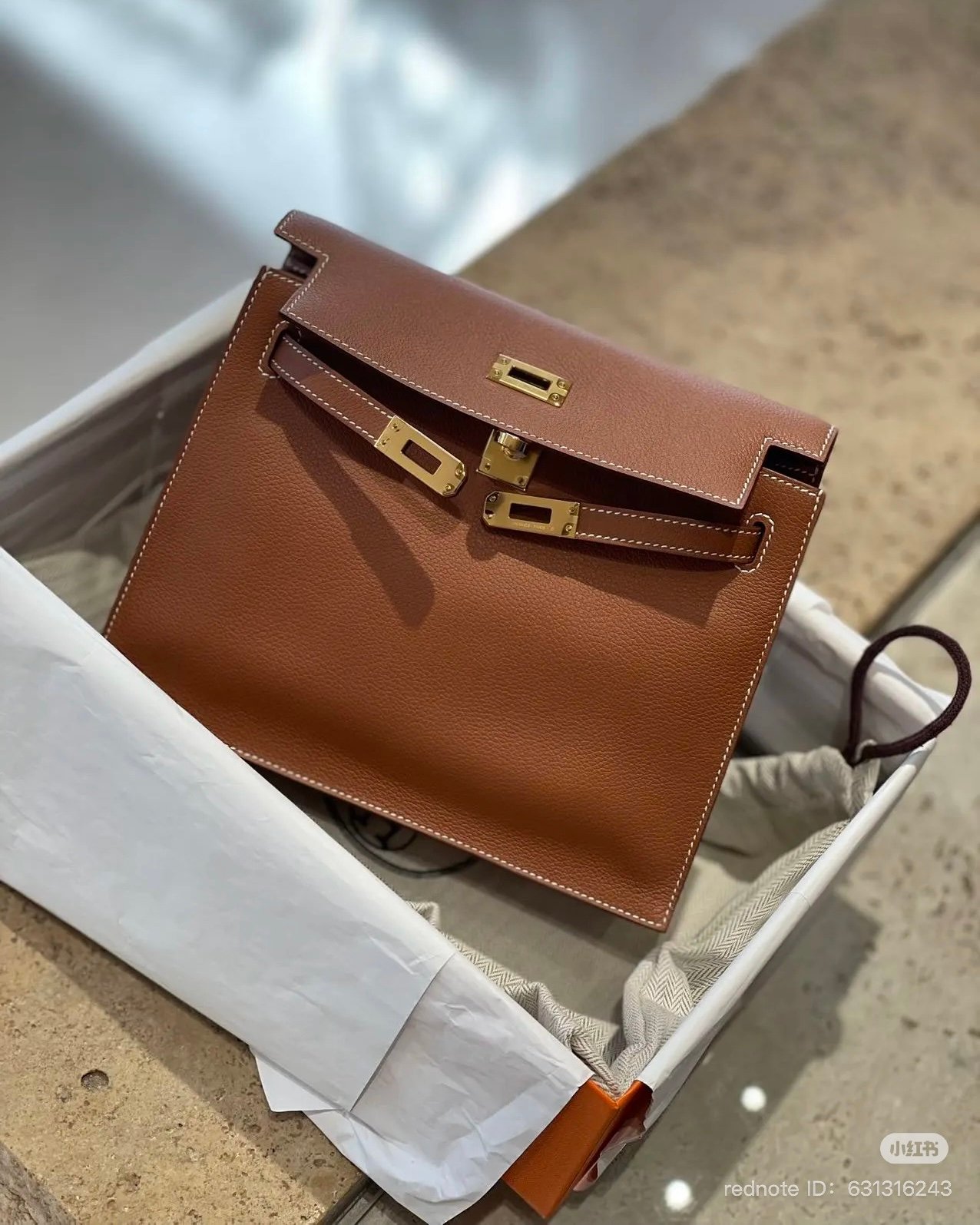
Evercolor Leather Care
Boasting similar properties to Epsom leather, Evercolor requires similar care and maintenance – with a few more niche things to consider:
- Avoid Color Fading: While Evercolor may have excellent color absorption, it is fairly sensitive to sunlight, so avoid prolonged exposure to avoid fading.
- Scratch Maintenance: Evercolor is durable, however it is not scratch-resistant – and will require TLC at the Hermès Spa to restore deep scratches.
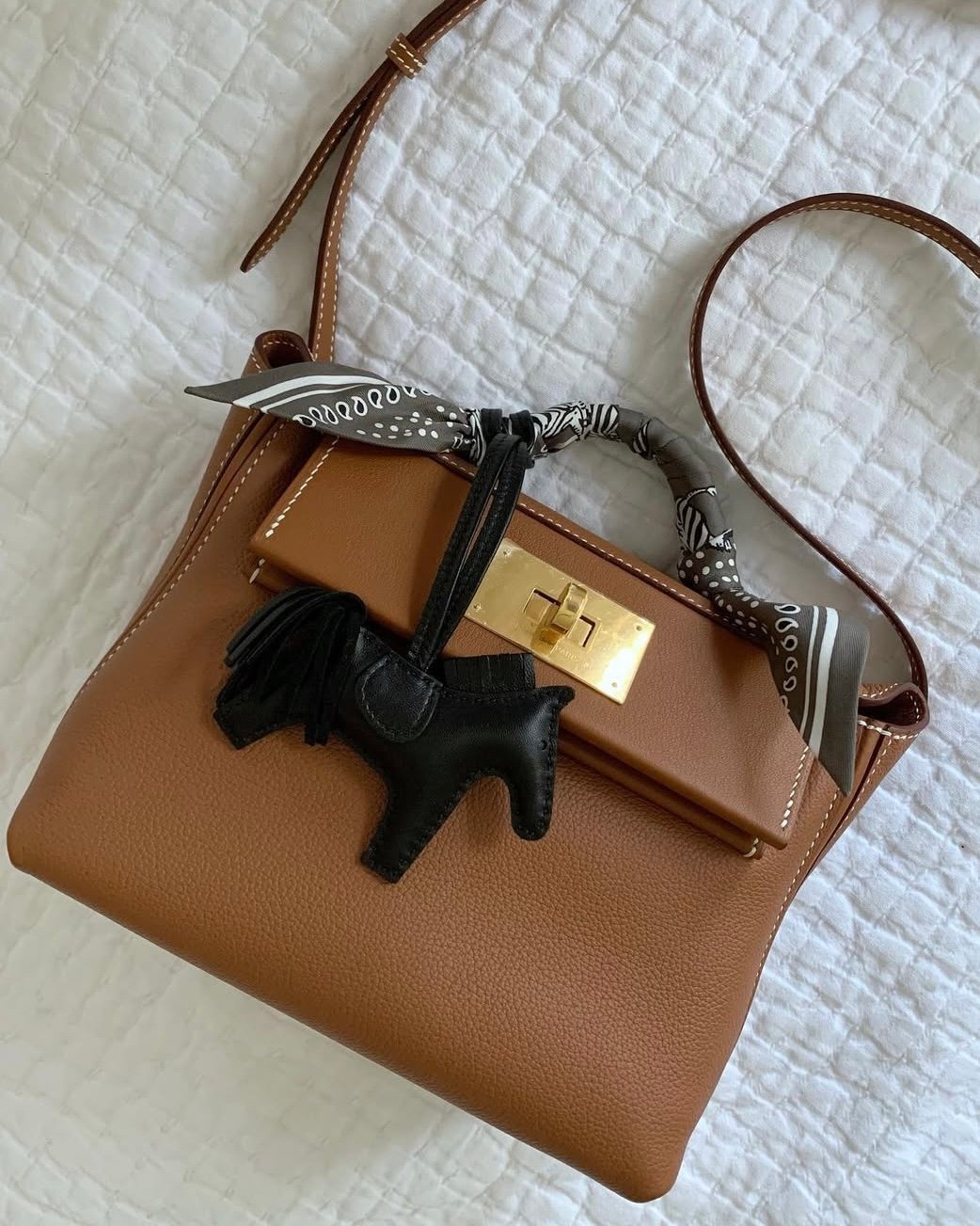
Image courtesy: @hpluxe
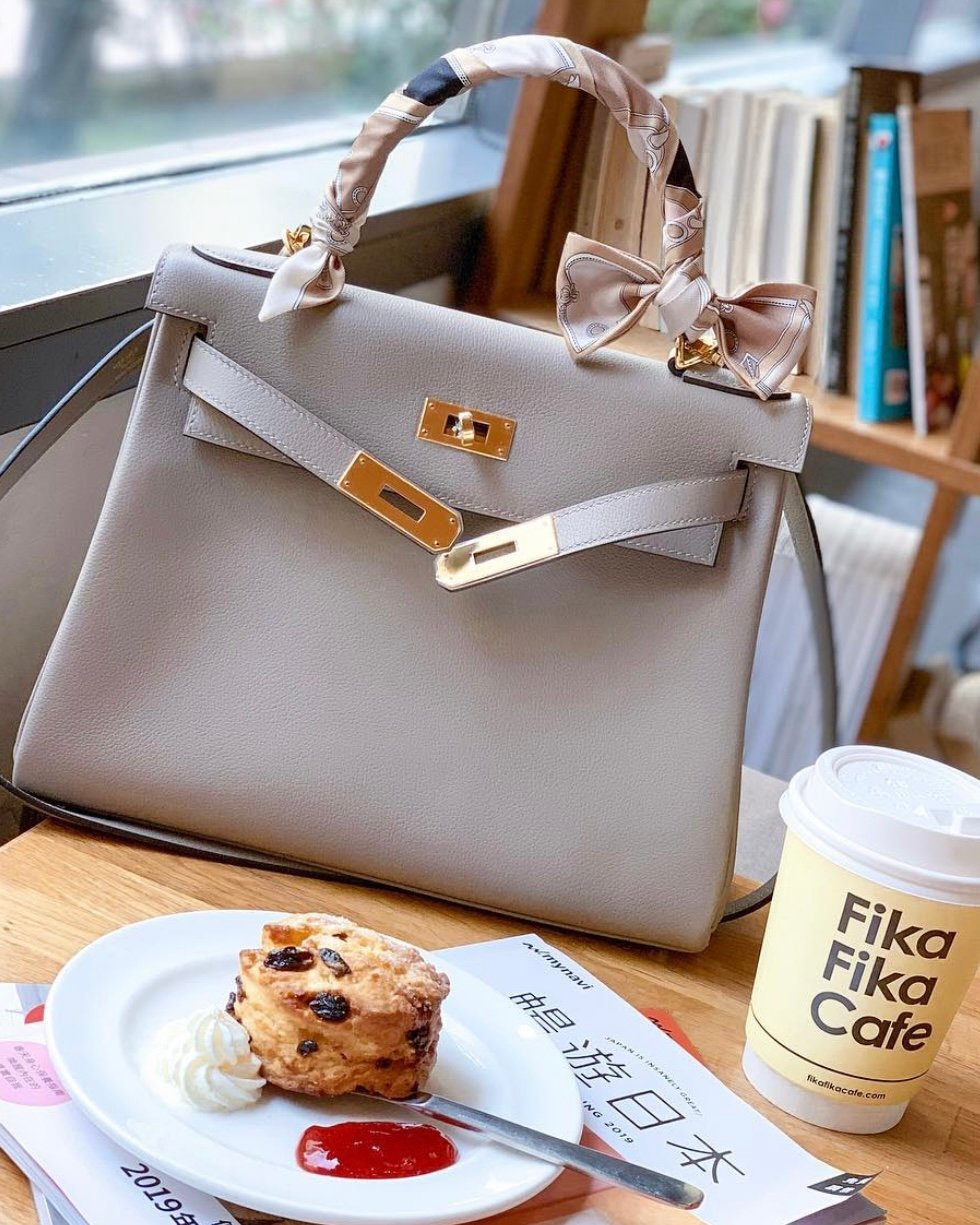
Image courtesy: @cherrylin0821
Sombrero Leather
Sombrero leather is a smooth, delicate calf leather with a matte finish that was added to Hermès’ offerings in 2011. Its soft texture provides a luxurious feel, while its sturdy nature makes it ideal for structured bags like the Kelly in Sellier style and the Constance.
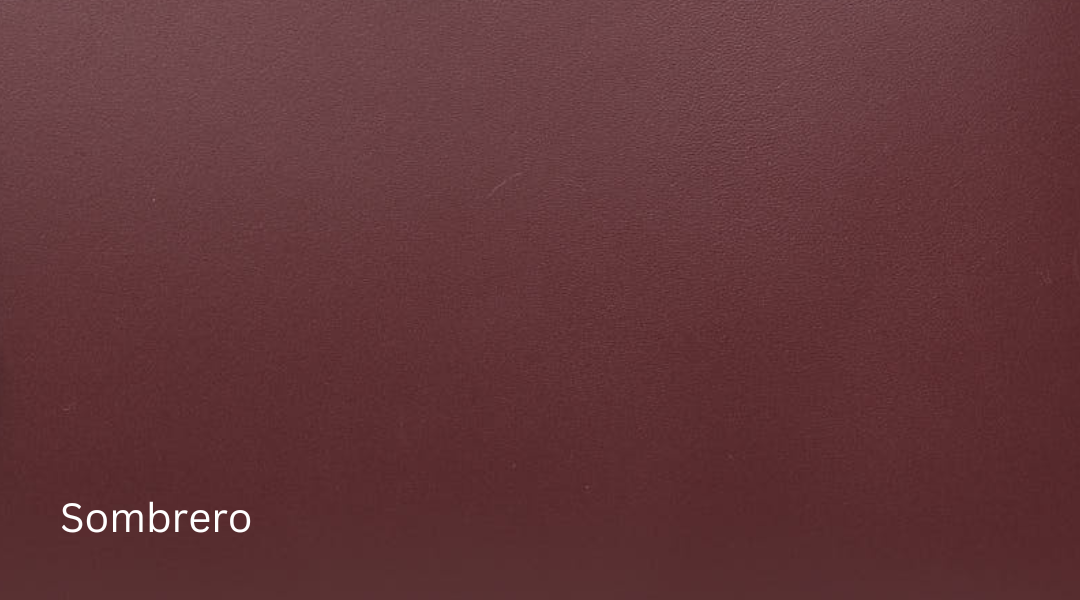
Sombrero
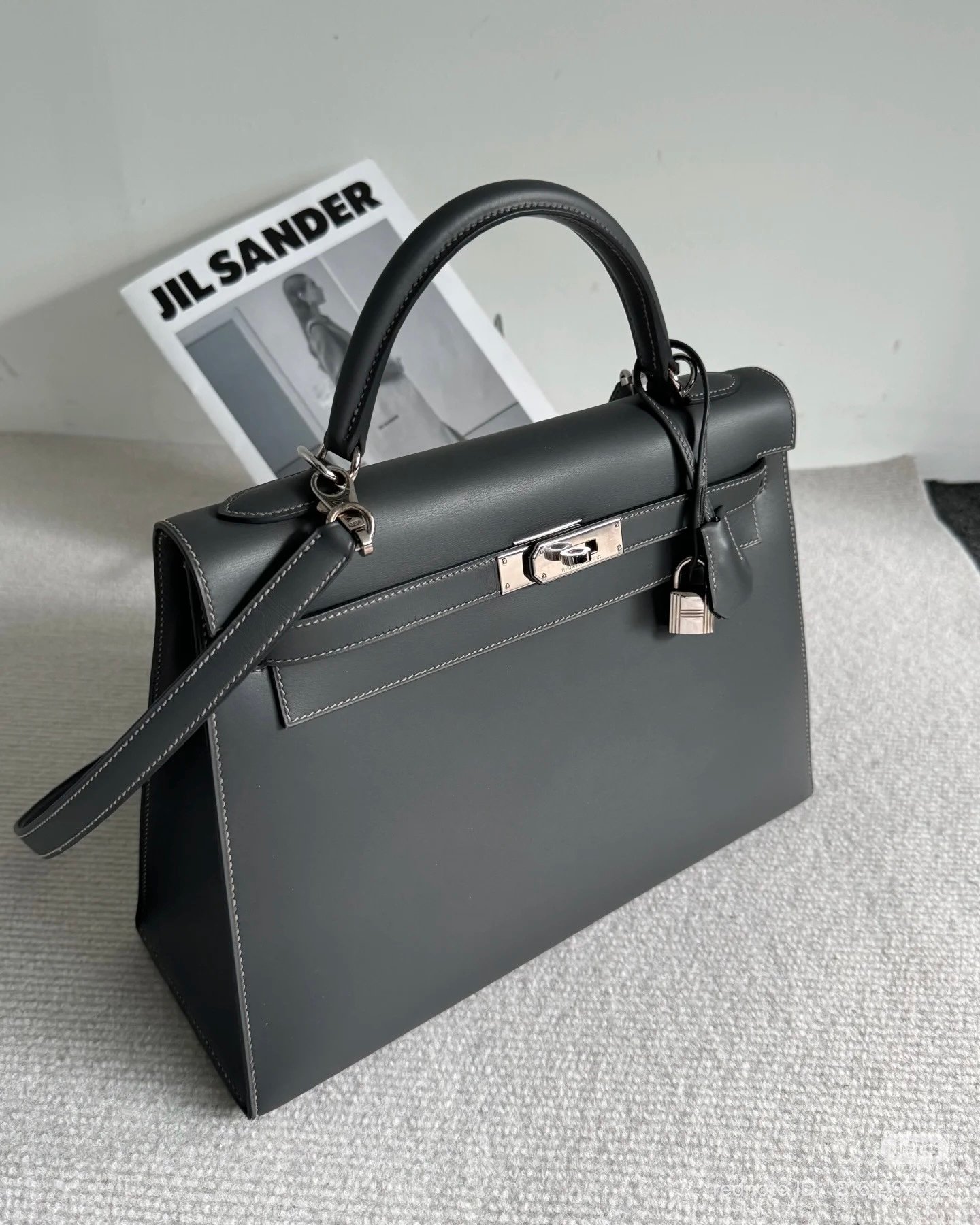
Caring for Sombrero Leather
Though beautiful, Sombrero is a delicate leather, best suited for those who appreciate leather that develops character with age or are willing to invest in its upkeep. Here are some tips:
- Embrace the Patina: Sombrero will naturally develop a patina over time, but this aging process can be minimized or managed with treatment at the Hermès Spa.
- Water Exposure: Avoid water contact – while Sombrero leather won’t blister like Box Calfskin, it remains a delicate leather susceptible to marks.
- Buff Light Scratches: Minor scratches can be buffed out, but deeper ones should be addressed at the Hermès Spa.
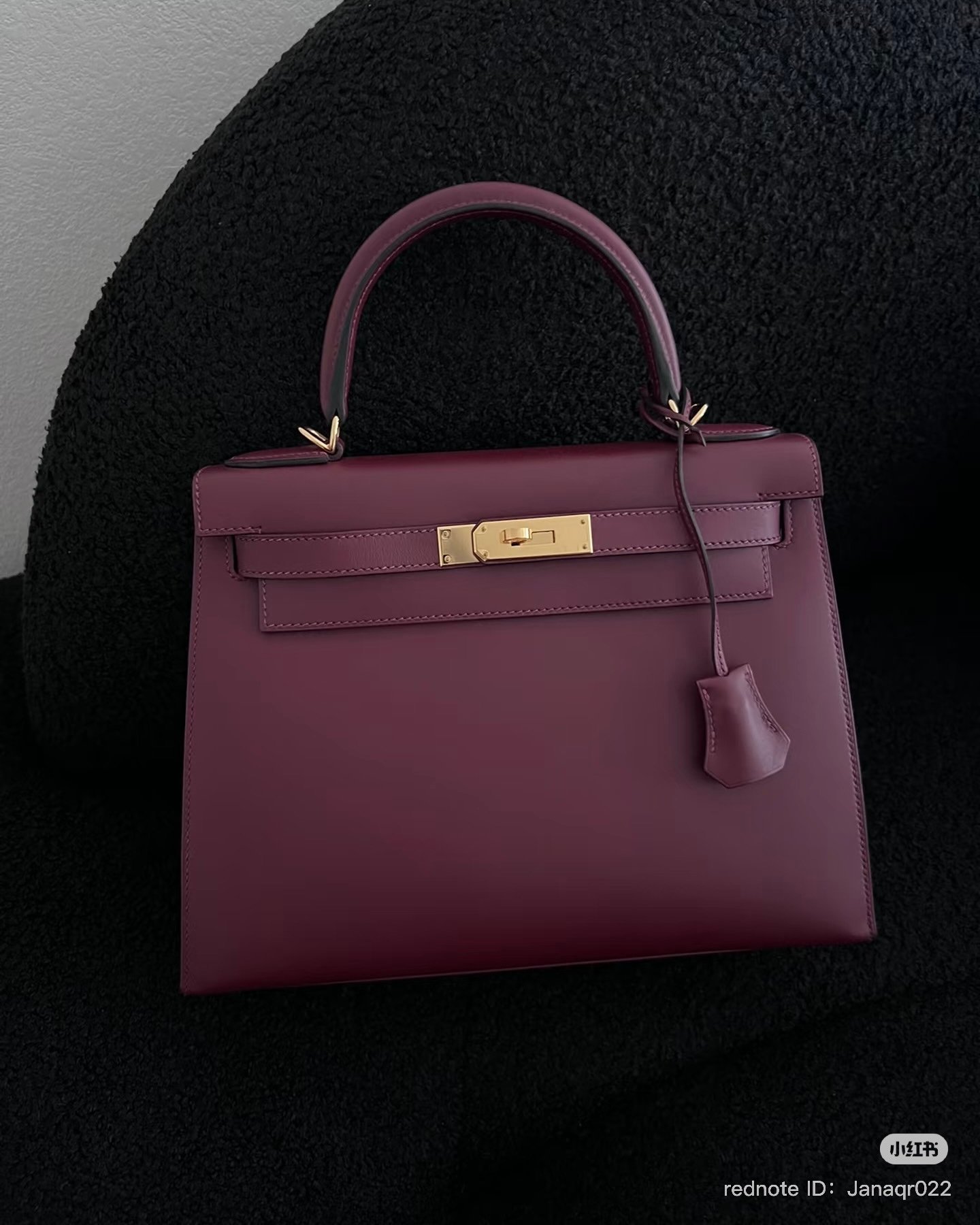
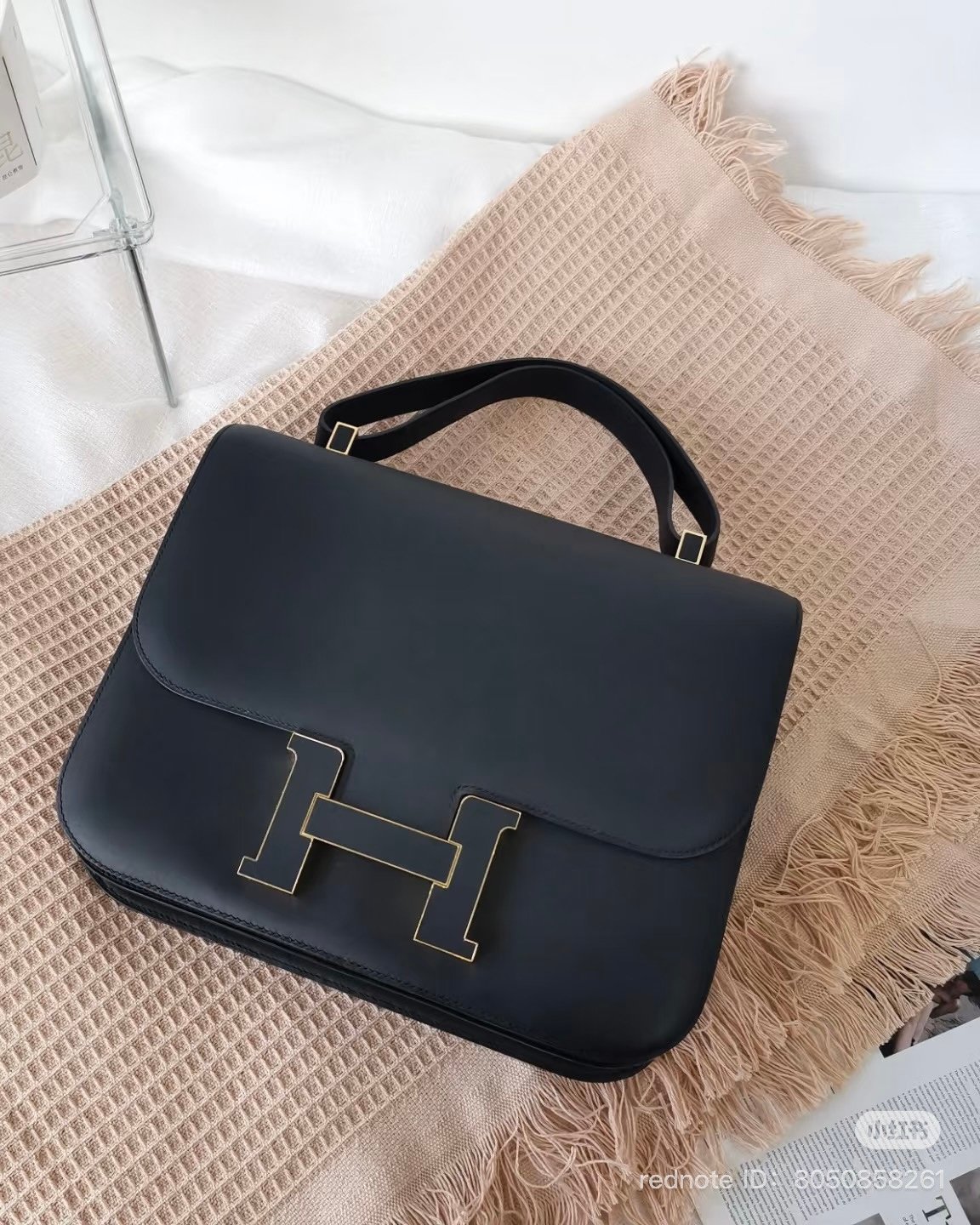
Hermès Exotic Skins: The Pinnacle of Luxury
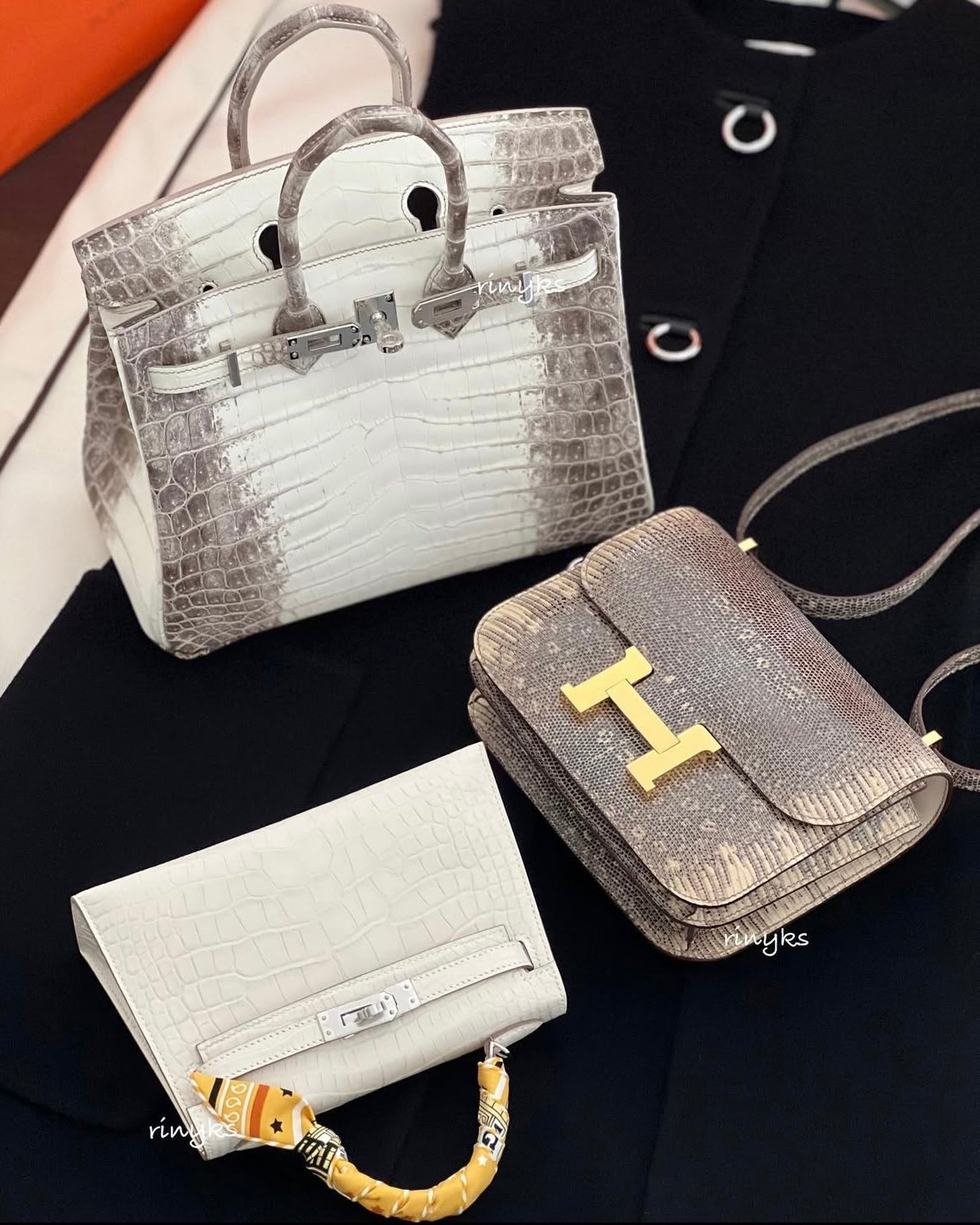
Image courtesy: @rinyks
Exotic Skins in Hermès Collections
While most Hermès products are crafted from full-grain calf or goat leather, the Maison’s rare and coveted exotic skins – Alligator, Crocodile, Lizard, and Ostrich – represent the pinnacle of luxury. These exquisite materials are used to create highly limited pieces, each with unique characteristics due to natural variations in the skin, making every item a one-of-a-kind creation.
There is, however, a clear hierarchy among Hermès’ exotic leathers. Crocodile holds the highest status, particularly valued for its role in the exclusive grouping of Himalayan bags.
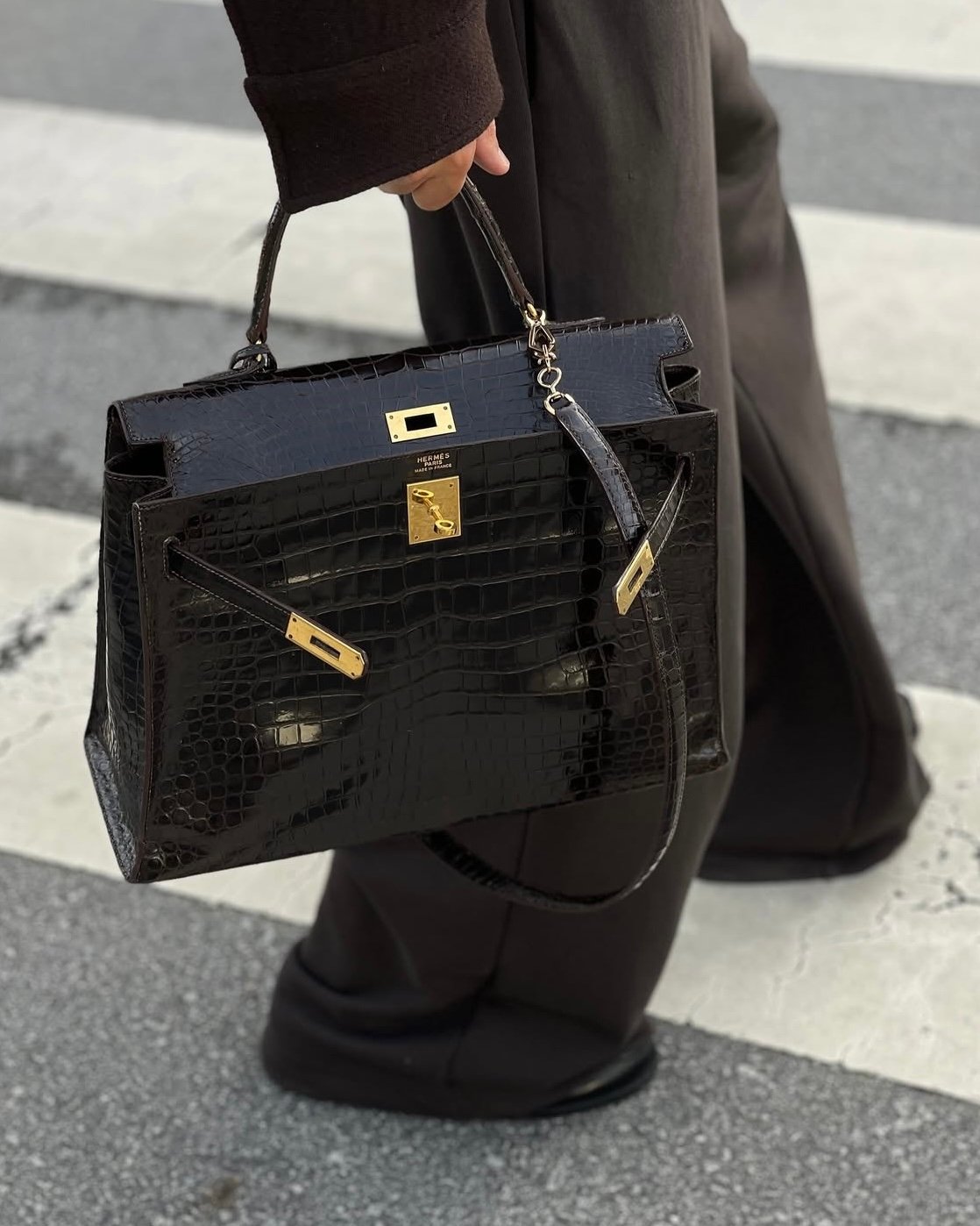
Image courtesy: @thebirkinboy
Alligator Mississippiensis
Hermès has long used Alligator skin from the Mississippiensis species, native to the United States. While at first glance, it may resemble Crocodile skin, Alligator skin possesses distinct features that set it apart. For starters, alligators are significantly smaller than crocodiles, with full-grown lengths reaching about 12 feet, explaining why Hermès predominantly uses Alligator skin for smaller bags such as the Mini Kelly II, Kelly 25, and Birkin 25.
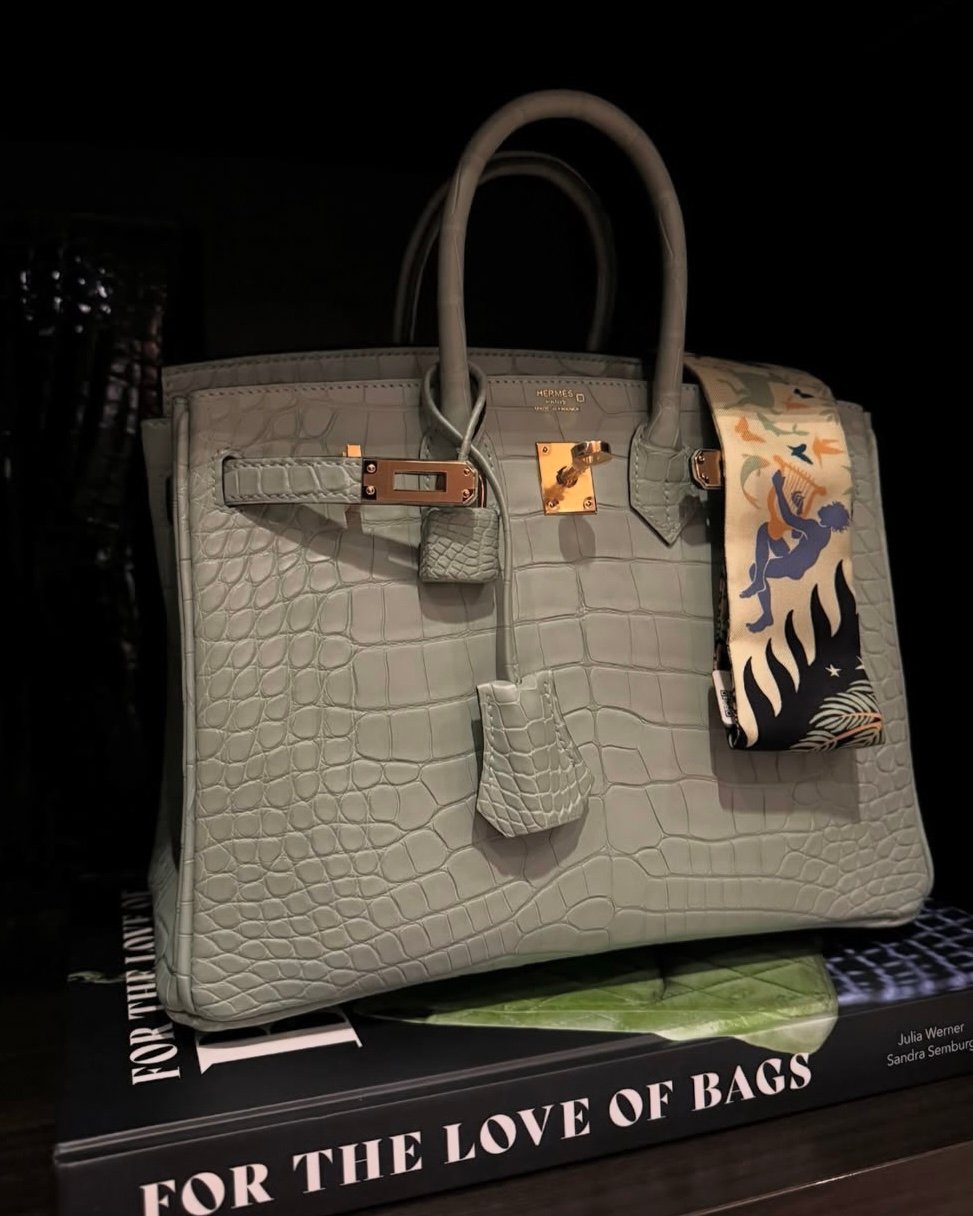
Image courtesy: @m.t.l1968
The smaller Alligator hide also features noticeably smaller scales without visible pores, giving it a smoother feel. The scales may appear larger in the center and taper towards the outer edges.
Each Hermès Alligator bag is marked with a square (☐) symbol, indicating it is made from Alligator Mississippiensis. Alligator bags are available in three finishes – Matte, Shiny (Lisse), and Boreal Satin – each achieved through different processing techniques.
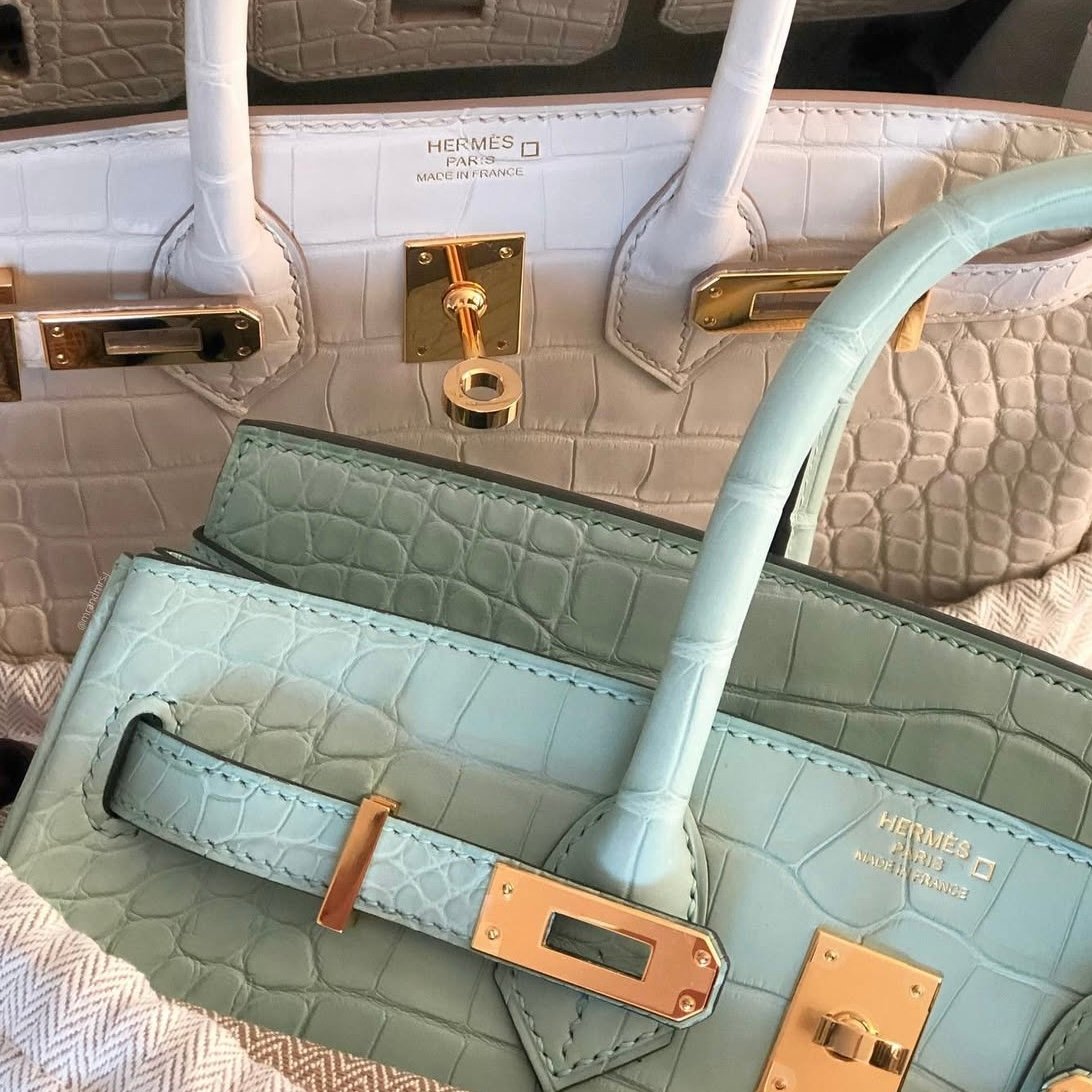
Image courtesy: @mrandmrs.j
Matte Alligator
The process of achieving the matte finish on Hermès Matte Alligator skin begins with the perfect hide. Artisans meticulously rub the skin with wool felt to create its distinctive Matte surface. Currently, Matte Alligator is favored over the Shiny finish and tends to be priced slightly higher.

Matte Alligator
Shiny Alligator
Also referred to as Lisse, the luxurious shiny finish on Alligator skin is achieved by buffing the surface with a stone until a rich sheen develops. While Shiny Alligator is equally delicate as its Matte counterpart, the glossy finish efficiently conceals the minor imperfections that may arise with wear.

Shiny Alligator
Boreal Satin Alligator
Boreal Satin Alligator, one of the rarest finishes in Hermès’ Alligator lineup, is highly coveted due to its limited availability and recent introduction. Offering a unique alternative to the Matte and Shiny finishes, it boasts a distinctive silky texture. It is primarily seen on small accessories, such as the Mini Kelly.
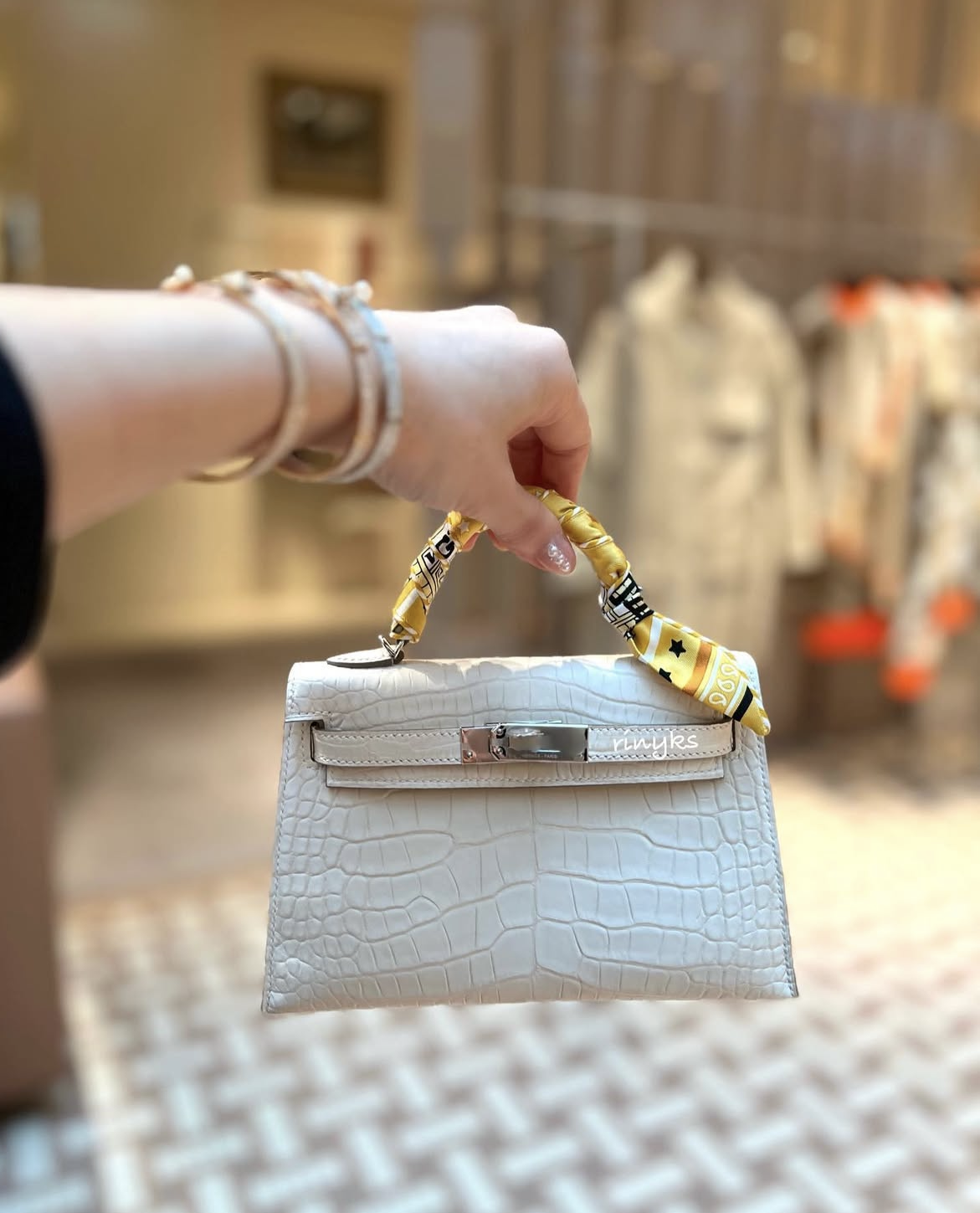
Image courtesy: @rinyks
Crocodile (Niloticus and Porosus)
The most coveted of all exotic skins at Hermès, Crocodile is considered the crème de la crème of luxury handbags, particularly renowned for its role in the Himalaya bags. Hermès offers two primary types of Crocodile skin – Niloticus and Porosus, each showcasing unique characteristics, and available in two distinct finishes – Matte and Shiny (Lisse).
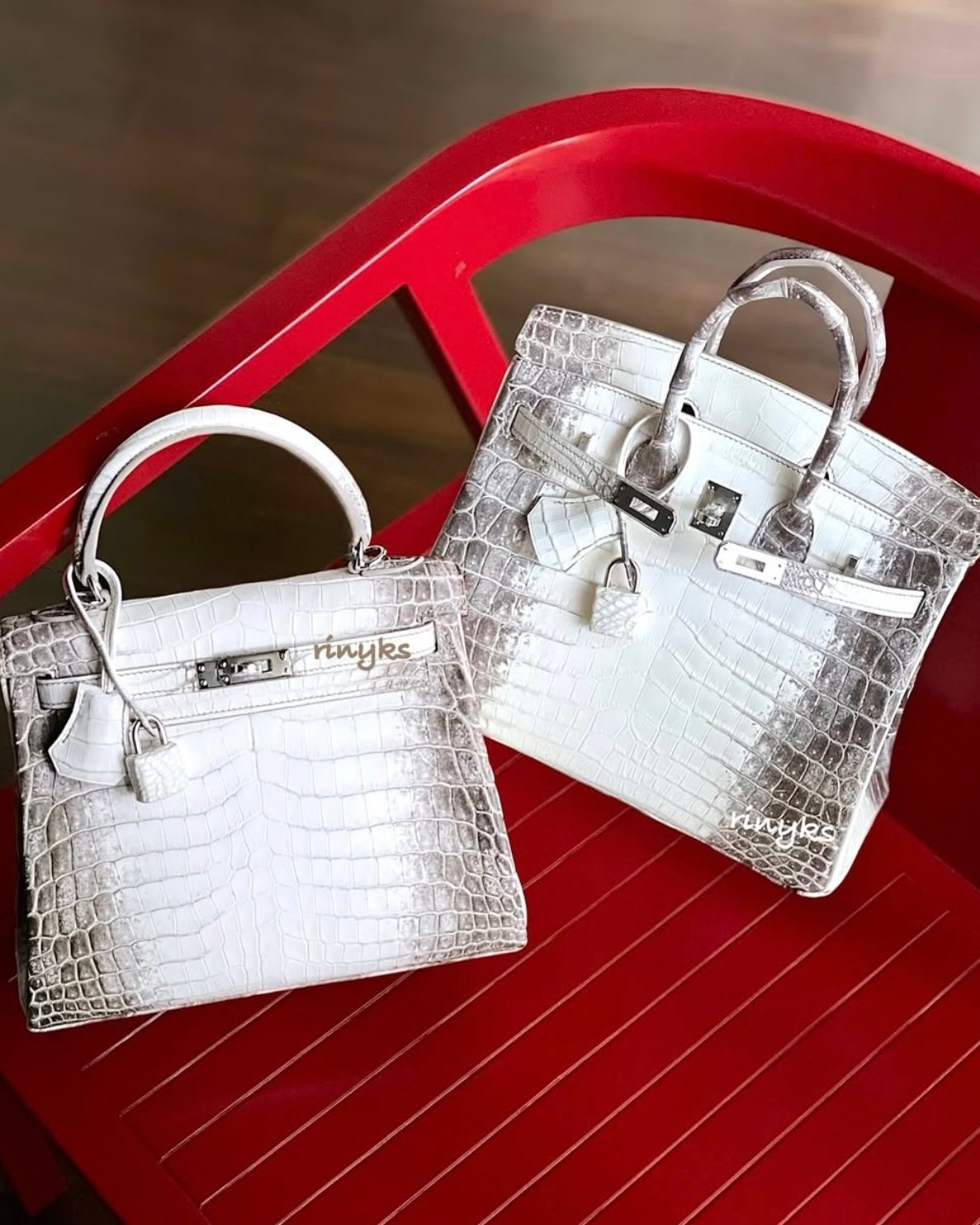
Image courtesy: @rinyks
As with Alligator leather, the Matte and Shiny finishes for Crocodile Niloticus and Porosus are achieved using the same careful methods. The Matte Finish is created by rubbing the skin with felt, while the Shiny finish is developed by buffing the skin with a stone to create a lustrous, polished surface.
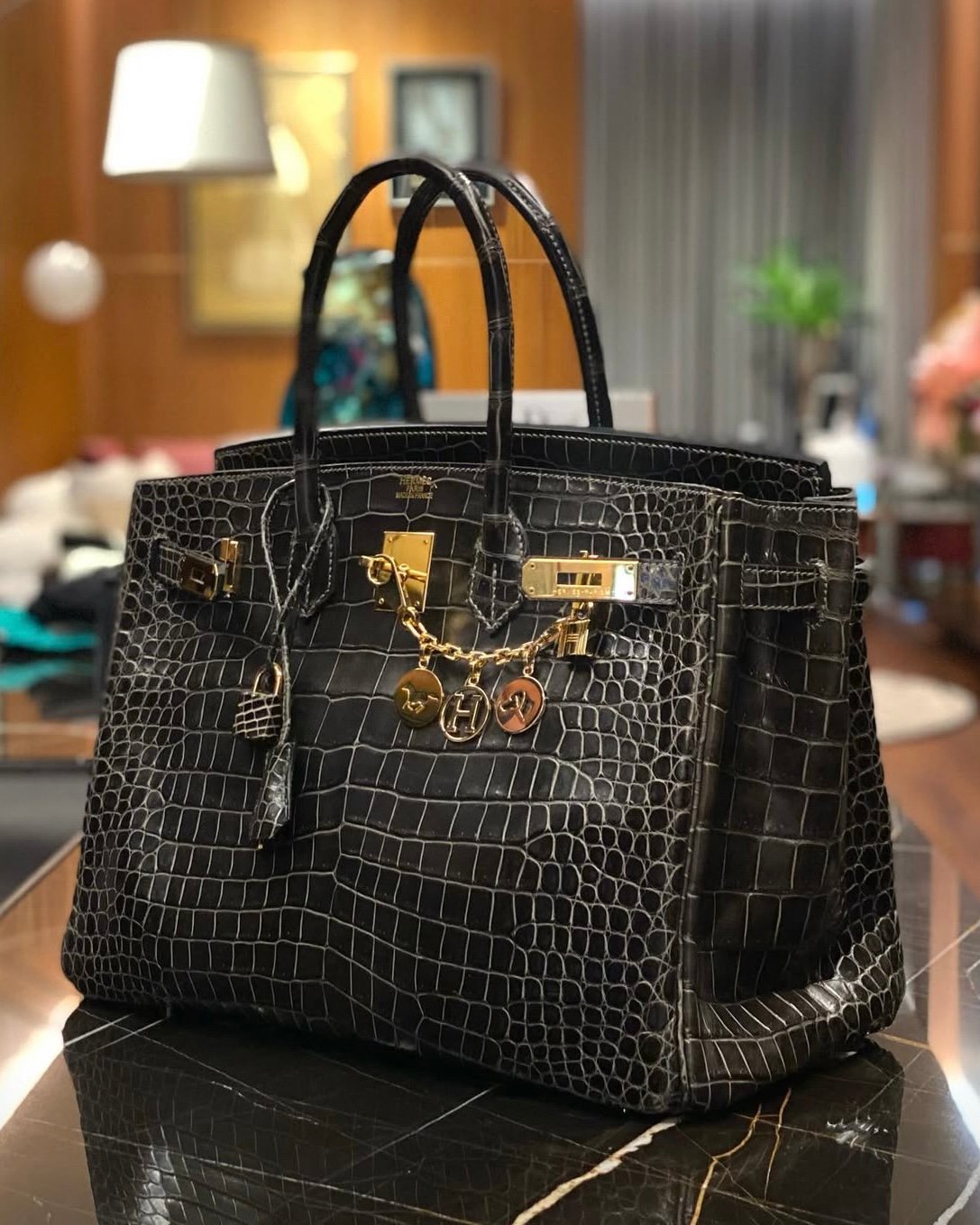
Image courtesy: @m.t.l1968
Niloticus
Crocodile Niloticus, sourced from the Nile River, is one of the most commonly used exotic leathers at Hermès. Available in both Matte and Shiny finishes, it is most famously used for the iconic Himalaya Birkin and Kelly bags, making it one of the most sought-after exotic skins in the Hermès collection.
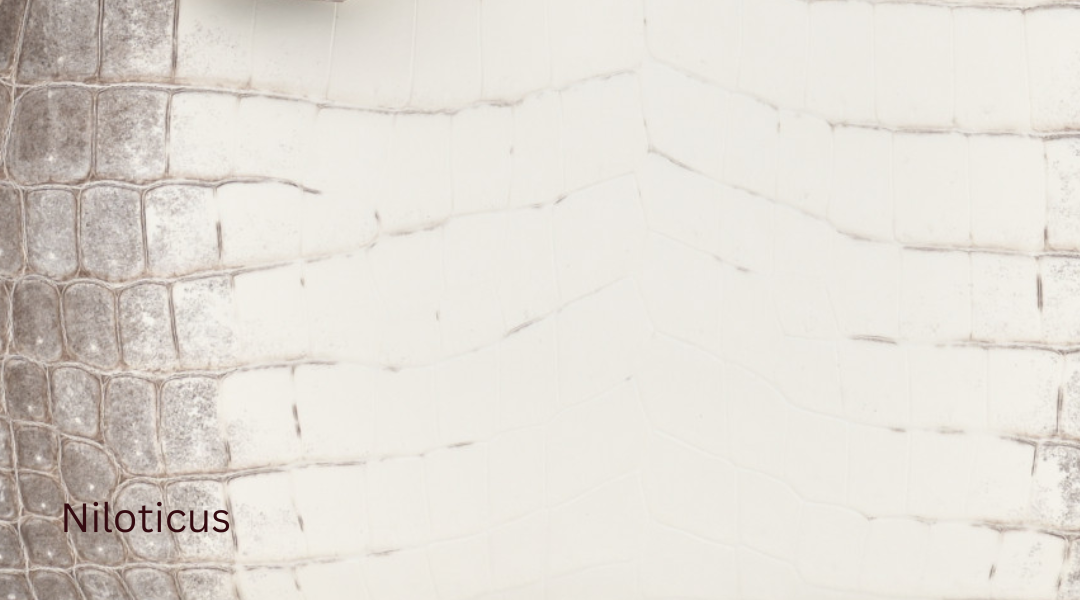
Niloticus
The skin features large, rectangular, smooth scales with visible dots or pores in the center, a key characteristic that distinguishes it from Alligator skin. Each Crocodile Niloticus bag is marked by two dots (••) next to the Hermès stamp, indicating its authenticity and source.
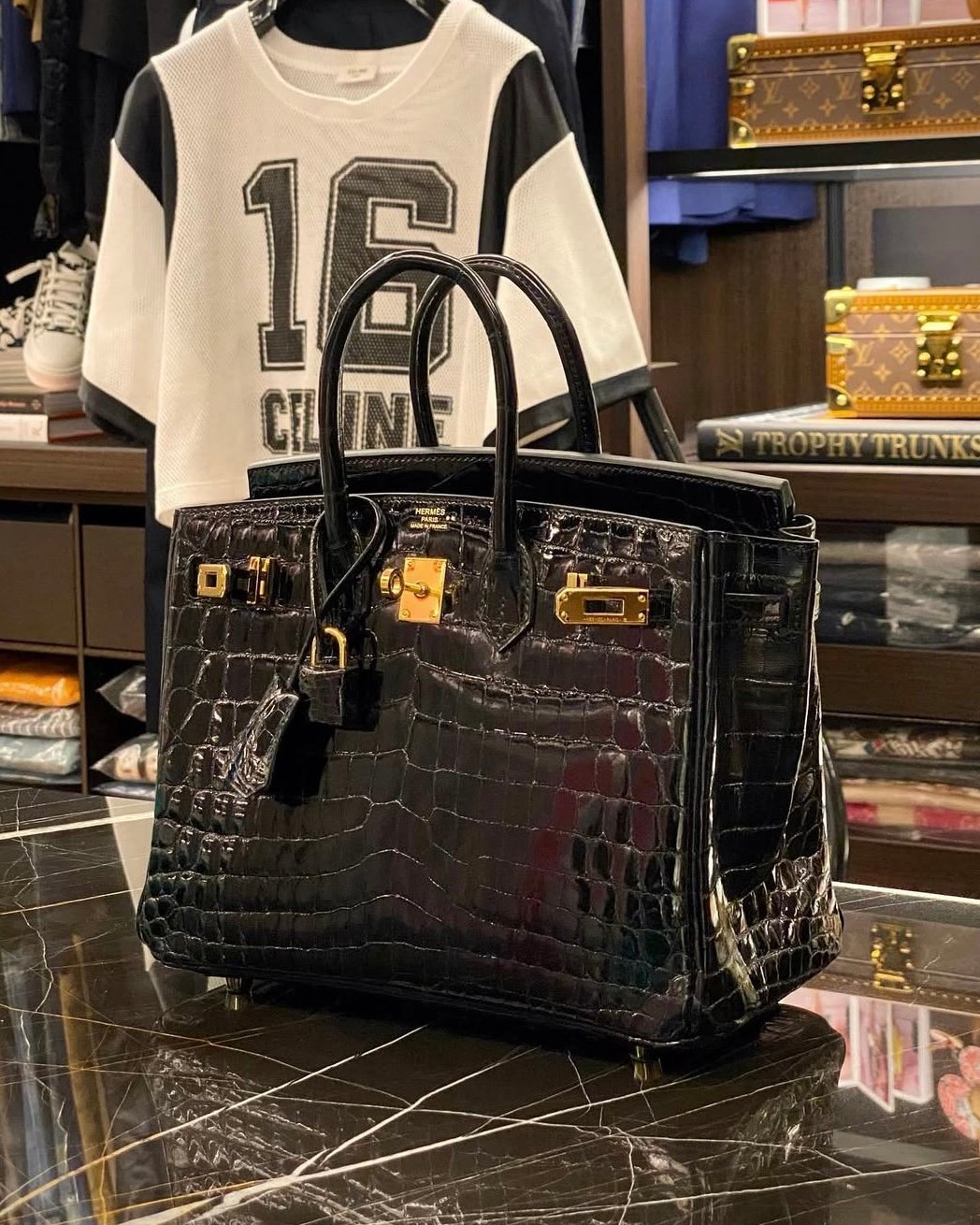
Image courtesy: @m.t.l1968
Porosus
The most expensive exotic skin at Hermès is Crocodile Porous, sourced from Asia or Australia. Like Crocodile Niloticus, it comes in both Matte and Shiny finishes.
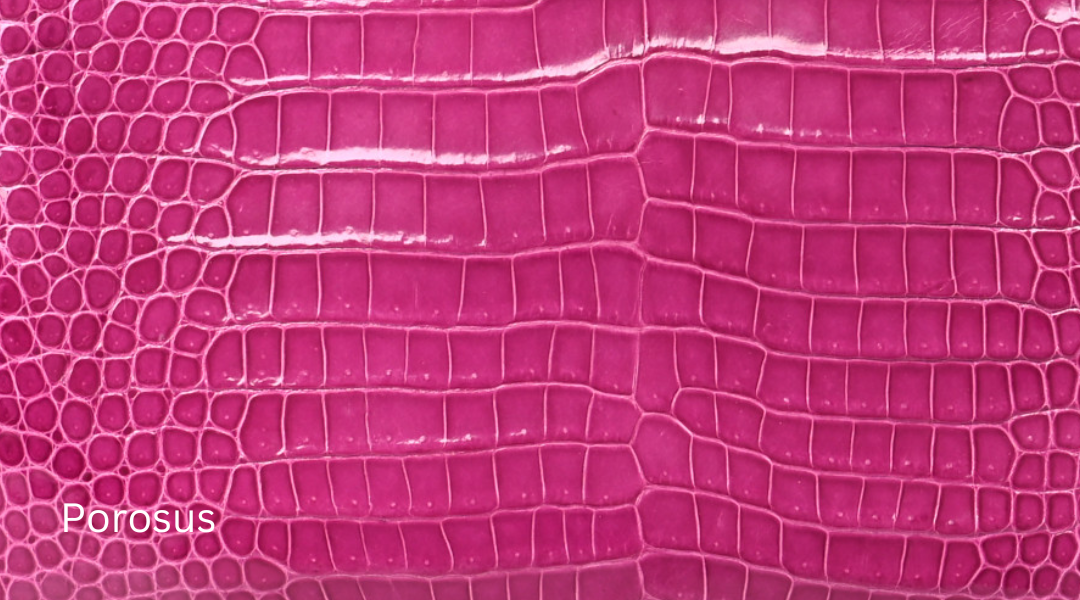
Porosus
To differentiate Crocodile Porous from Niloticus, note that Porous features smaller, more symmetrical, square-shaped scales, each with pronounced pores on either side. All Crocodile Porous bags can be identified by a caret symbol (^) next to the Hermès stamp.
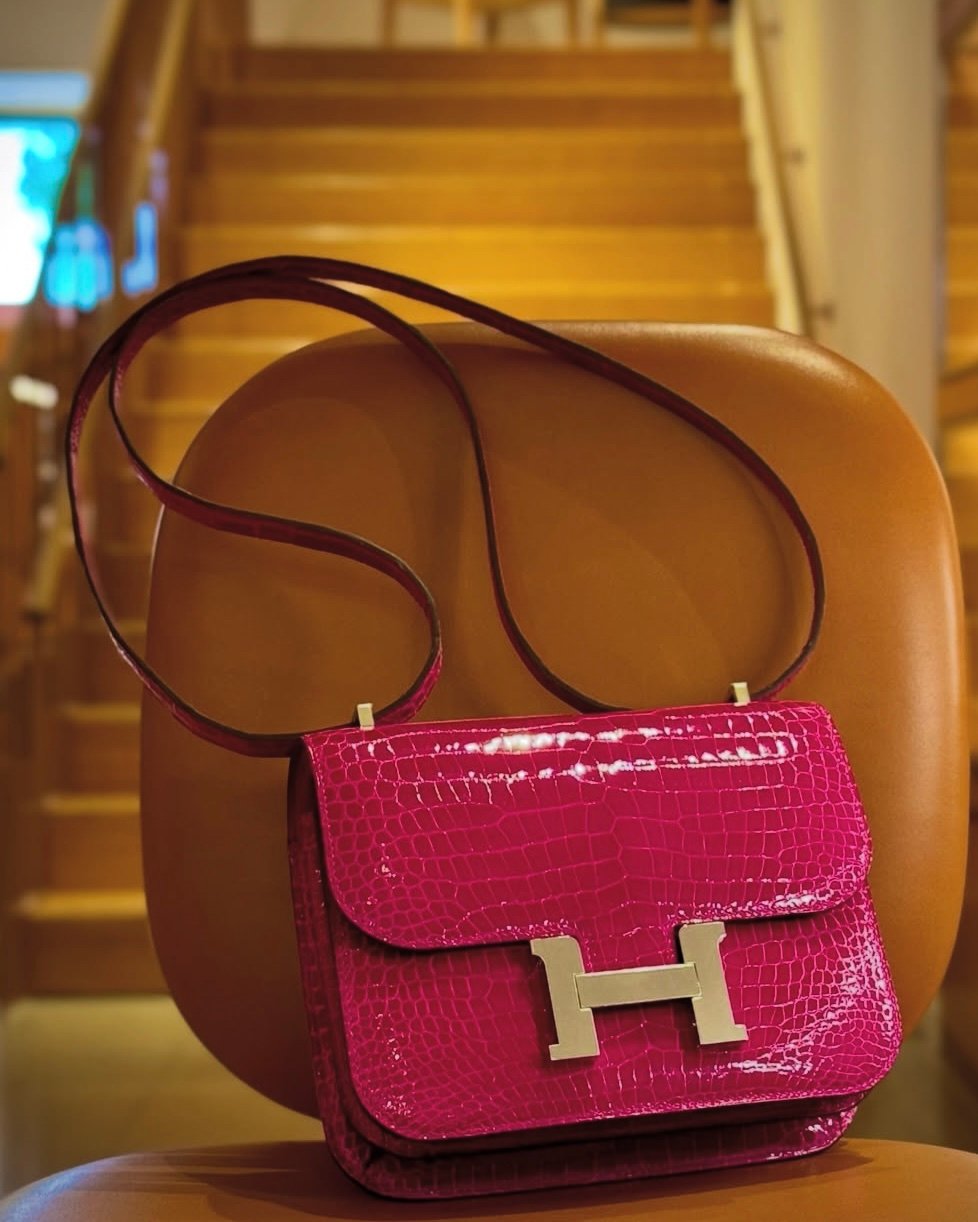
Image courtesy: @m.t.l1968
Lizard Skins
Hermès has long embraced Lizard skin in its collections, with Lizard Kelly bags dating as far back as the introduction of the style itself. However, it was in 2004, when Jean-Paul Gaultier took over as Creative Director, that the Maison began offering Lizard skin Birkin bags.
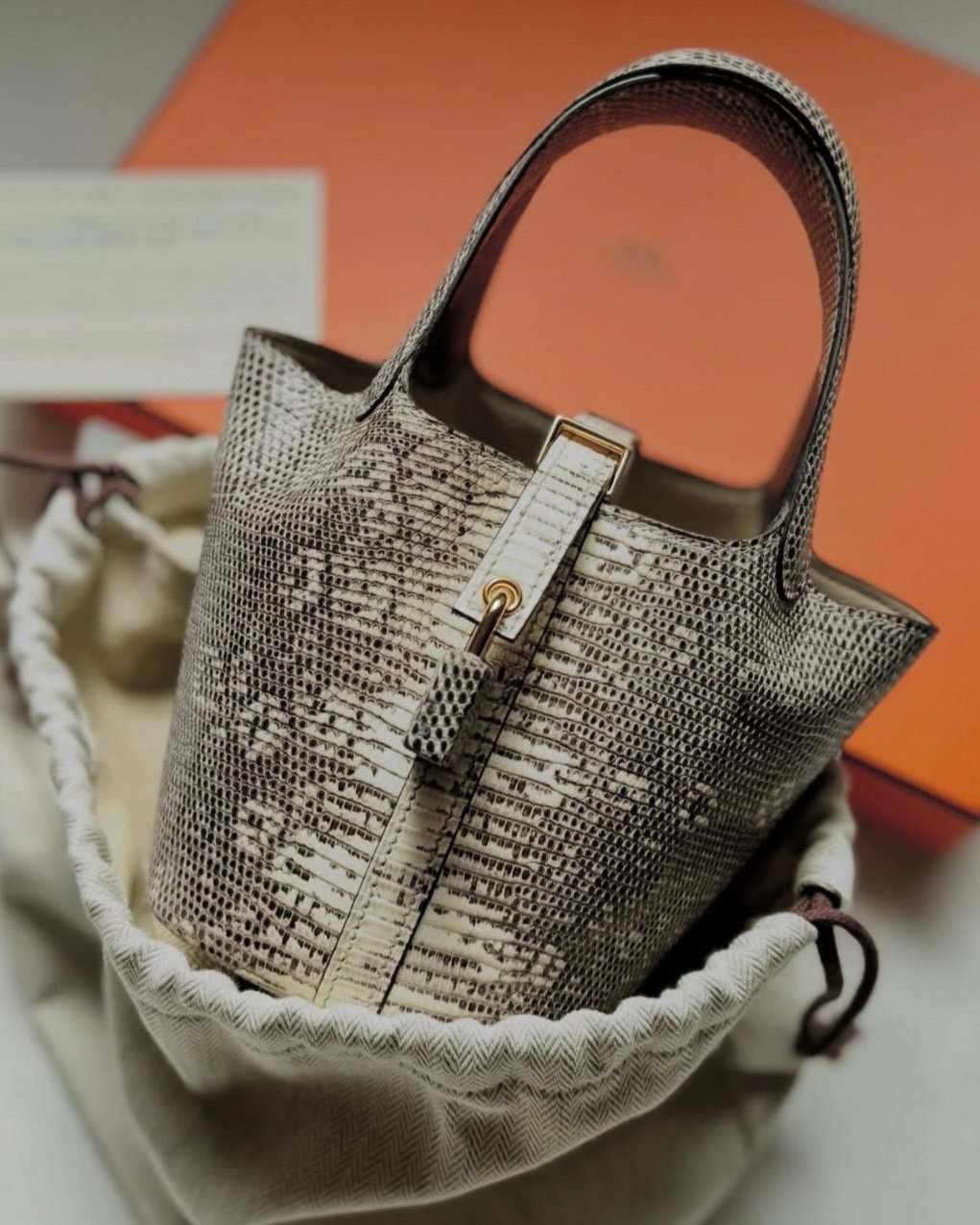
Image courtesy: @tnku_k03
Today, the Maison offers bags crafted from two distinct Lizard skins – Niloticus and Salvator. Both are celebrated for their unique texture and small-scale pattern. A firm skin known for scratch resistance qualities, Lizard is also prone to drying out, as well as fading with prolonged exposure to light.
Lizard skin bags are available in both Matte and Shiny finishes, though due to the small size of lizards, this exotic skin typically is reserved for smaller handbags and leather goods. Common styles in Lizard skin include the Kelly Pochette, Kelly Danse, Constance, and Birkin 20. Interestingly, while Crocodile Porous bags command the highest prices, Hermès Lizard bags are among the rarest in the exotic collection.
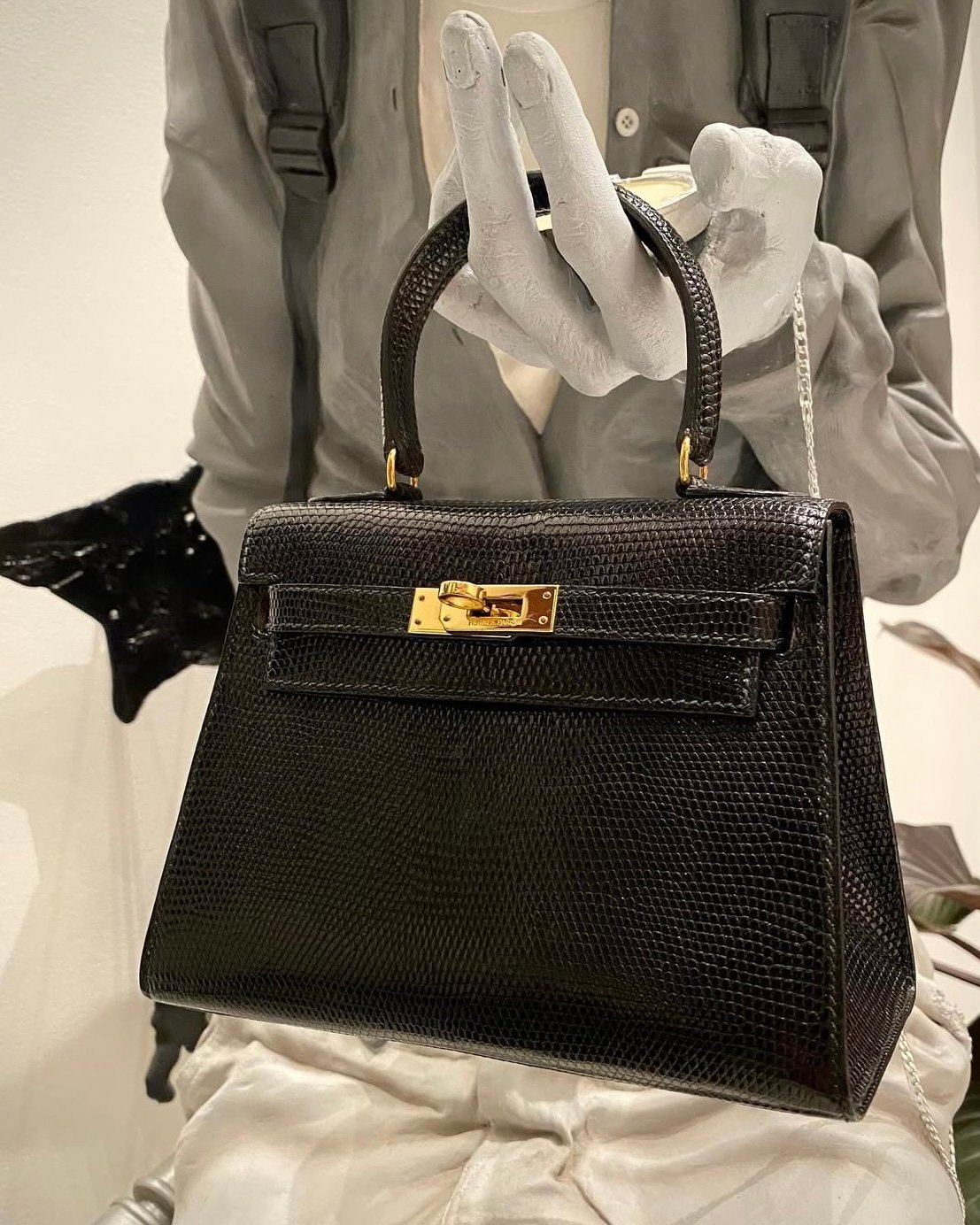
Image courtesy: @m.t.l1968
Lizard Niloticus
The most commonly used Lizard skin at Hermès is Niloticus, sourced from the Nile River. This polished Lizard skin is available in both Matte and Shiny finishes, however, due to the nature of the small scales, even the Matte version has a subtle sheen.
Lizard Niloticus bags are denoted by a single hyphen (-) next to the Hermès stamp.
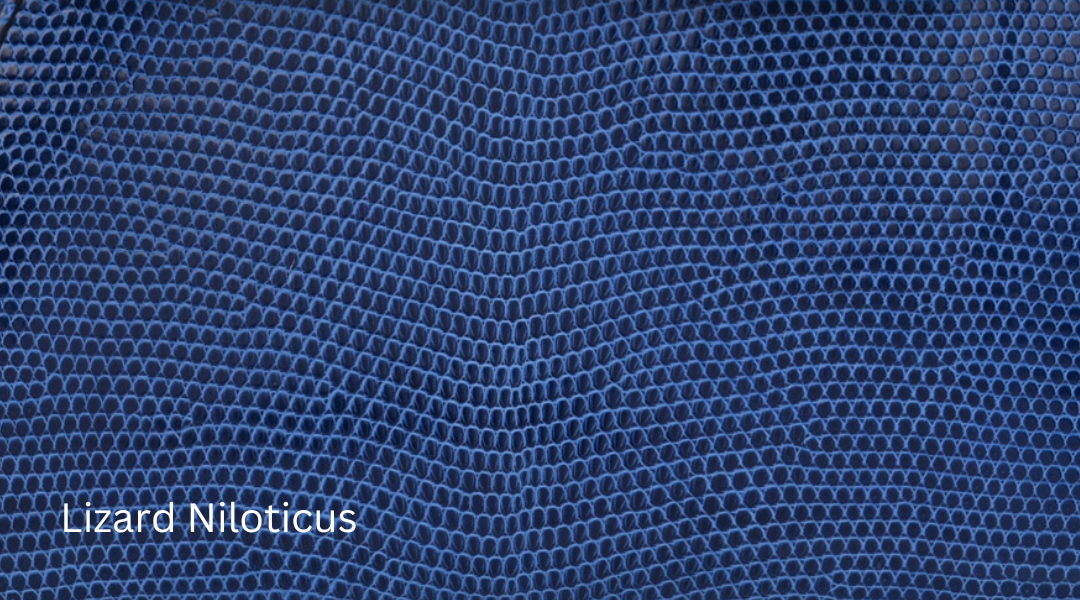
Lizard Niloticus
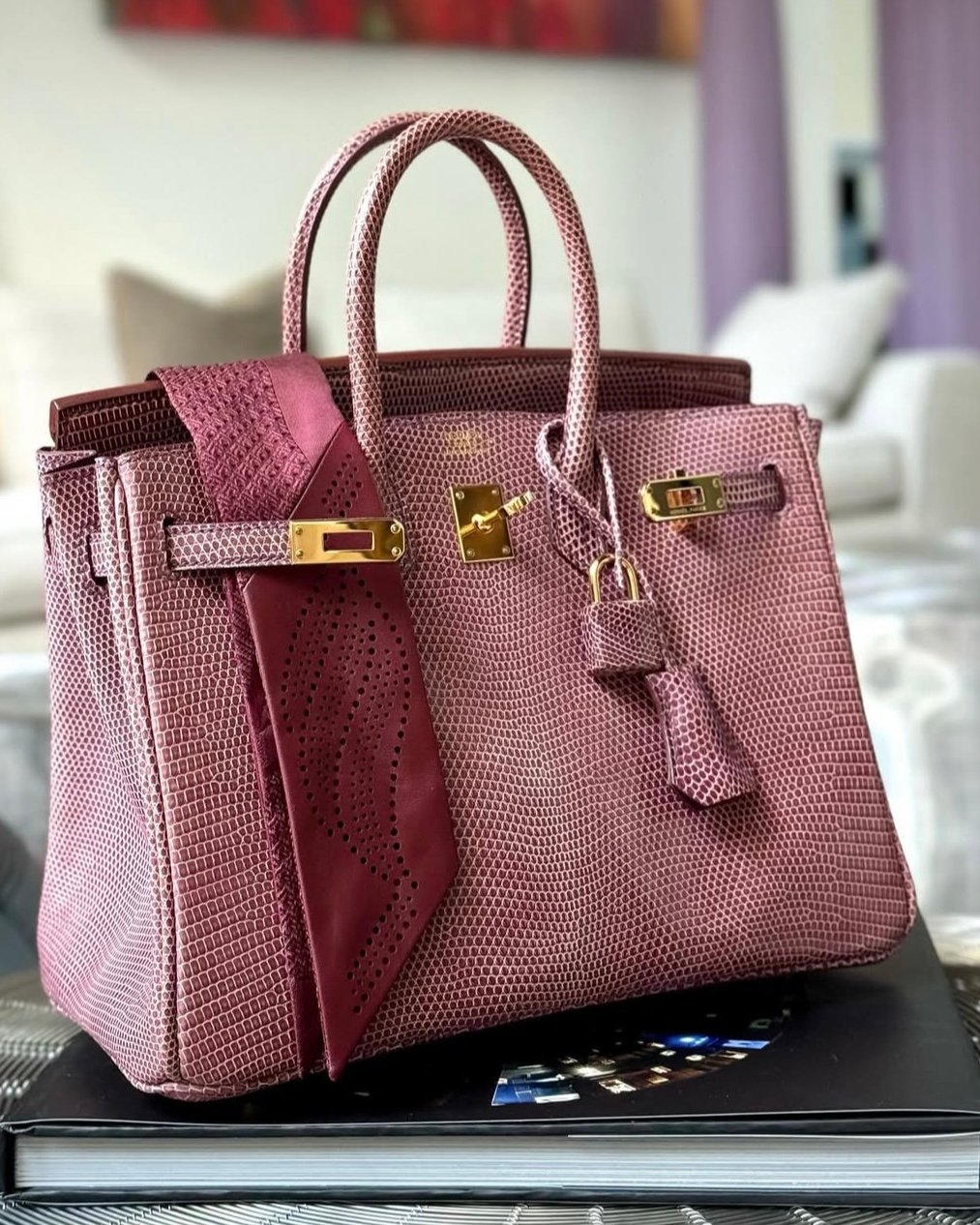
Image courtesy: @m.t.l1968
Lizard Salvator
Originating from Southeast Asia, the Salvator Lizard is the rarer of Hermès’ two Lizard skins, sometimes referenced as Natural Lizard. This exotic skin is known for its use in Hermès Ombré handbags and accessories, featuring a symmetrical dye pattern that accentuates the skin’s natural ridges.
Salvator Lizard bags are identified by an equal sign (=) located next to the Hermès stamp.

Lizard Salvator
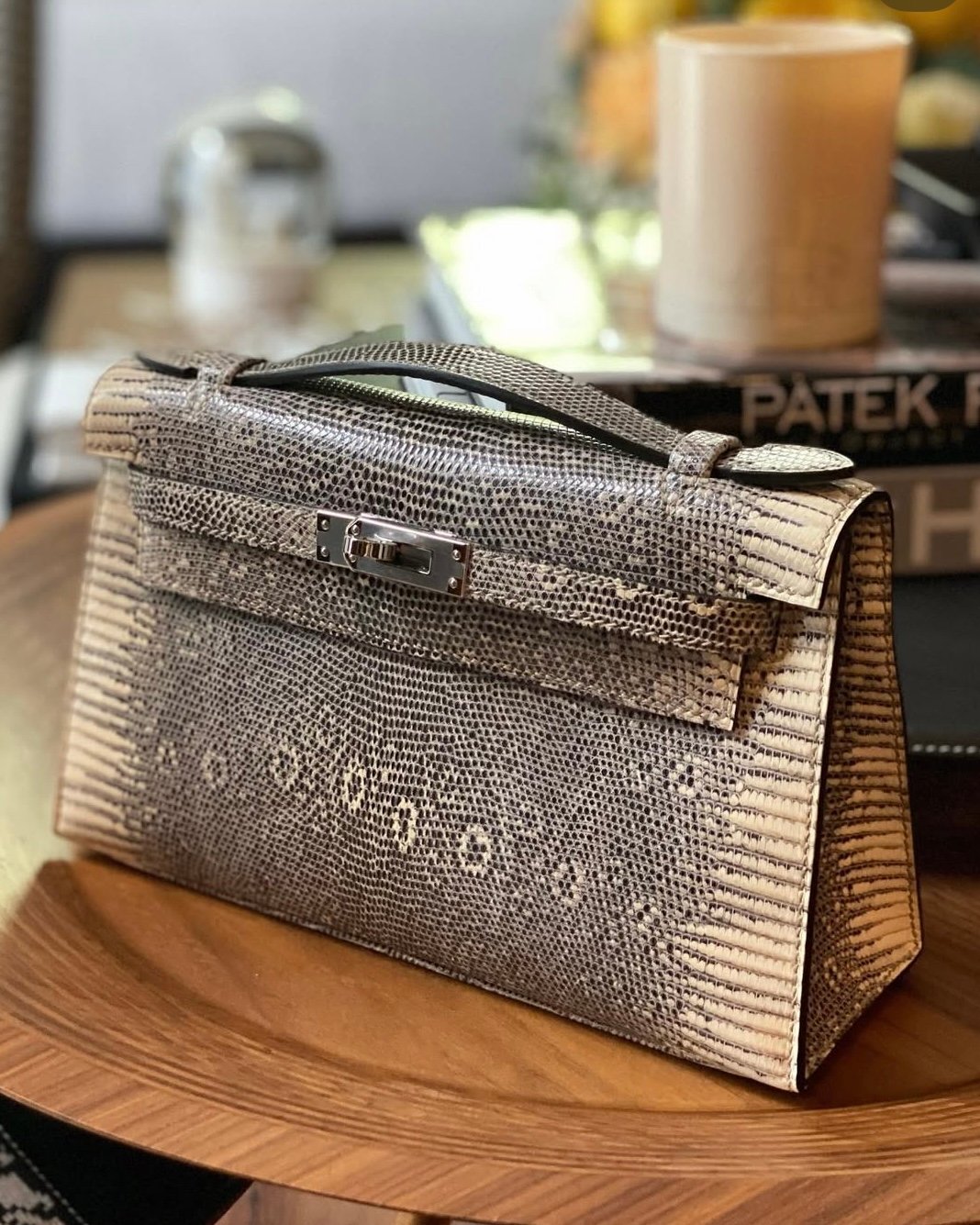
Image courtesy: @m.t.l1968
Ostrich
Hermès Ostrich leather, farmed in South Africa, has been part of the Maison’s offerings since the 1920s. Celebrated for its distinctive dotted quill pattern, Ostrich leather features a unique arrangement of follicles, which undergoes a special process to flatten and strengthen the skin, preventing damage over time.
This leather combines softness with durability, giving products a fairly rigid feel that maintains its shape well over time. Renowned for its deep and even color absorption, Ostrich leather is often offered in hues exclusive to this skin.

Ostrich
Boasting water-resistant qualities, Ostrich leather is considered one of Hermès’ most durable exotic leathers. However, it can darken and soften over time, particularly on handles and areas that come into close contact with your skin’s natural oils.
Unlike other Hermès exotic skins, Ostrich bags are not marked by a stamp and come only with a CITES certificate.
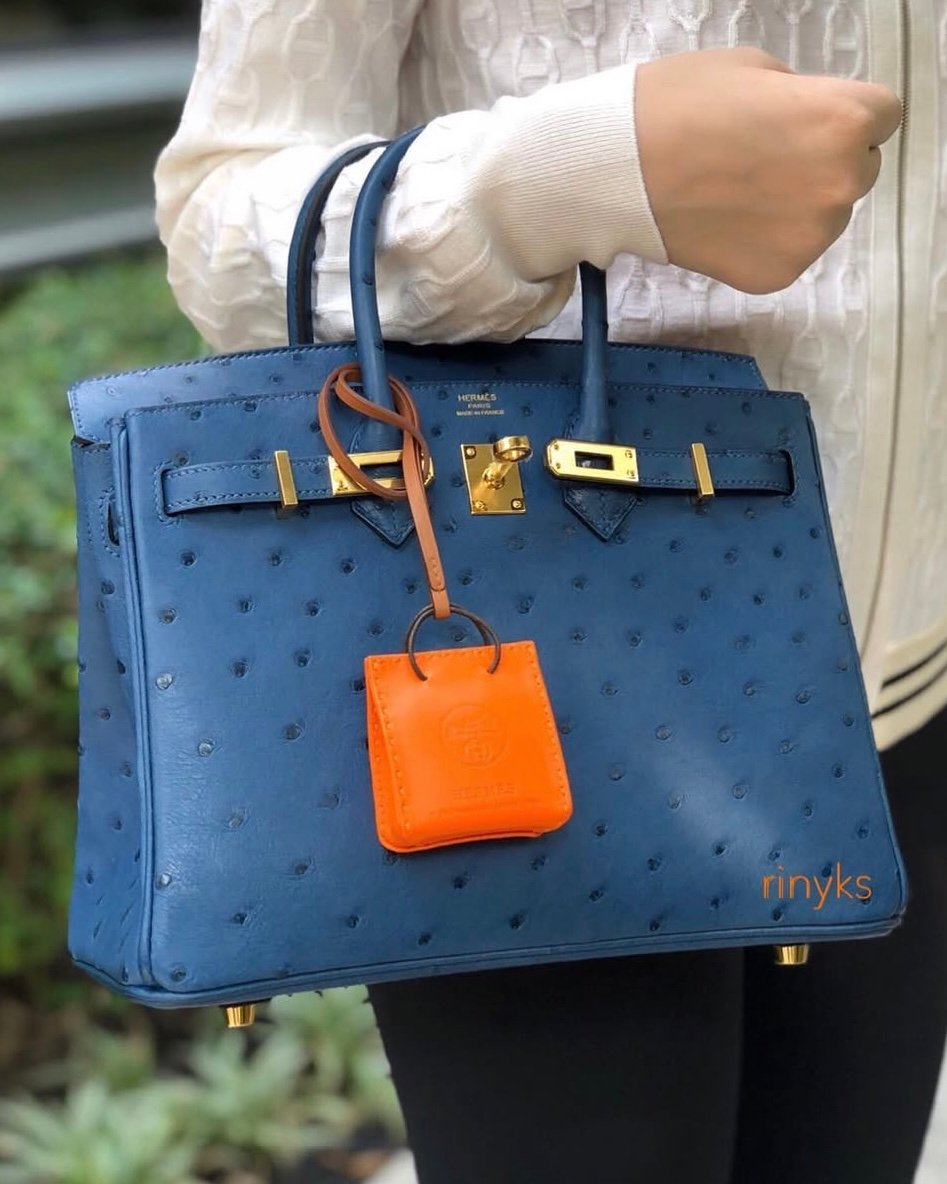
Image courtesy: @rinyks
Rare and Lesser-Known Hermès Leathers
Beyond its iconic leathers and exotic skins, Hermès presents a selection of lesser-known materials, each with unique characteristics and appeal.
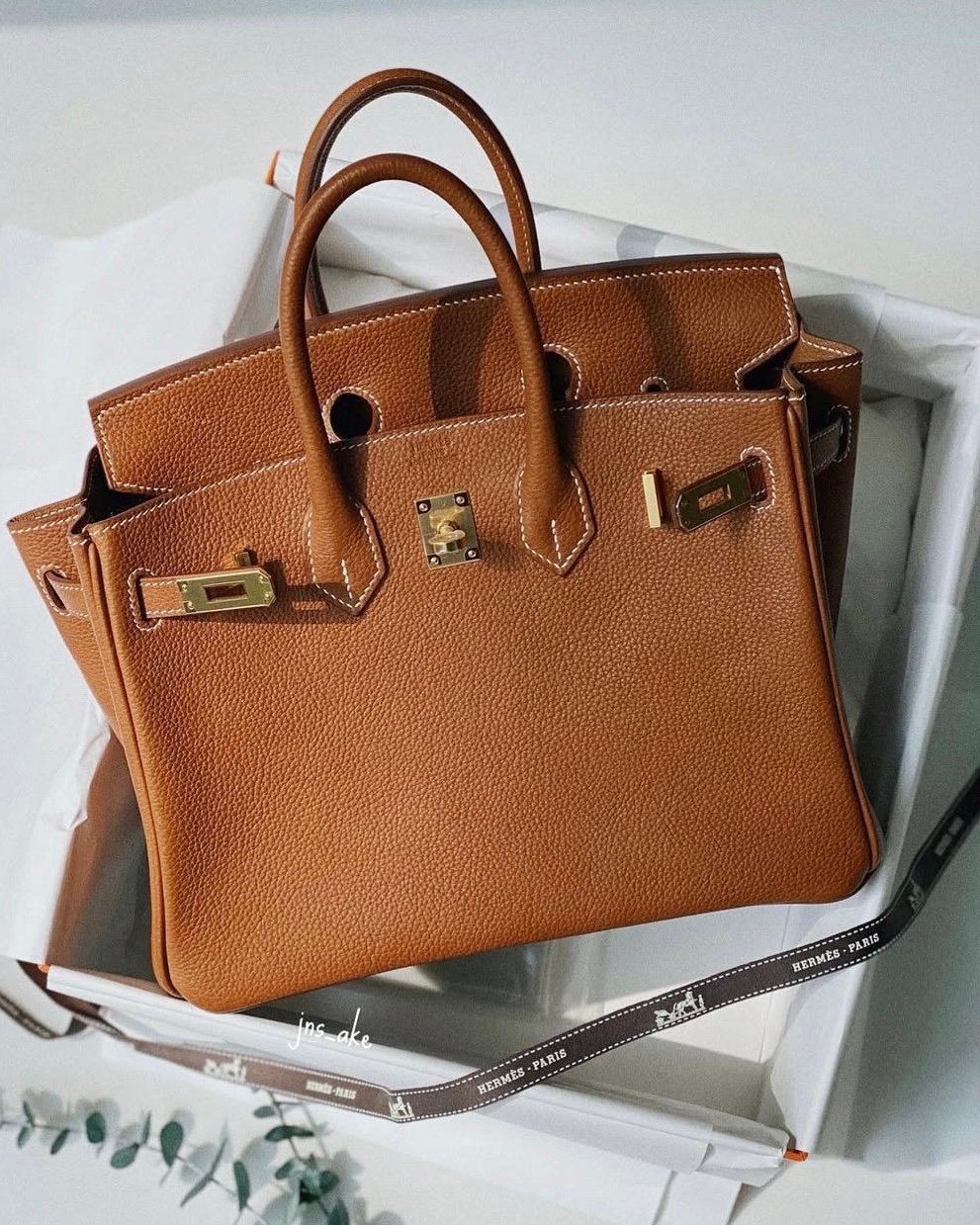
Image courtesy: @jns.ake
Textures of Other Hermès Leathers
| Leather | Texture |
| Barenia Faubourg | Fine grain |
| Butler | Smooth |
| Chamonix | Chamonix |
| Chèvre Chamkila | Smooth, fine grain, high-shine |
| Chèvre Chamkilight | Smooth,, fine grain, metallic shine |
| Evergrain | Embossed, soft |
| Madame | Soft, fine grain |
| Milo Lambskin | Soft |
| Negonda | Large & textured grain |
| Tadelakt | Soft, shiny |
| Taurillon Novillo | Fine, natural grain |
| Vache Liegee | Rigid |
| Veau Doblis | Smooth, napped |
| Veau Grizzly | Long nap, thick |
| Volynka | Cross-hatched, pressed grain |
Barenia Faubourg
In 2017, Hermès introduced a new variant to the Barenia family – known as Barenia Faubourg. Named after the Hermès’ flagship Paris boutique at 24 Rue du Faubourg Saint-Honoré, Barenia Faubourg offers a modern take on the classic Barenia. While it shares many properties with its predecessor, including a similar feel and scent due to the same tanning process, it also features variations that enhance its suitability for handbags. The leather is pressed to create a finer grain, which makes Barenia Faubourg more resistant to scratches, blemishes, and water than the original.

Barenia Faubourg
Butler
Considered a Hermès Heritage leather, Butler was introduced in 2013. Boasting a smooth finish, Butler is natural and untreated. Known for its rarity, Butler requires careful maintenance since it is prone to showing scratches. Fortunately, many of these marks can be buffed out. This leather is often likened to Barenia due to its ability to develop a beautiful patina over time.
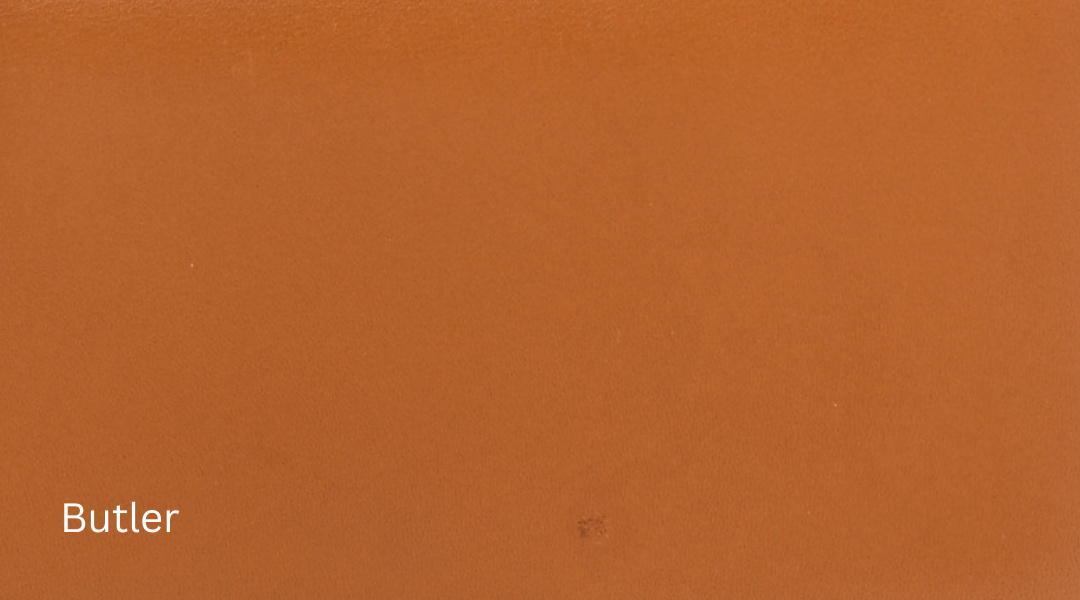
Butler Leather
Chamonix
Hermès Chamonix leather is sourced from male calves that reside in the commune of Chamonix, located in the French Alps. Often referred to as the matte version of Box Calf leather, Chamonix offers a smooth finish. Despite its matte appearance, Chamonix isn’t as prone to scratches – however, it is extremely sensitive to water and can blister when exposed to water.

Chamonix Leather
Chèvre Chamkila
Introduced to the Hermès goatskin family in 2018, Chèvre Chamkila features a smooth, fine grain with a high-shine finish. The name ‘Chamkila,’ meaning ‘shiny’ in Hindi, perfectly reflects the leather’s brilliant, almost glossy appearance. Unlike other goatskins, such as Mysore, Chèvre Chamkila has a less pronounced spine, giving the leather a more refined and polished look.
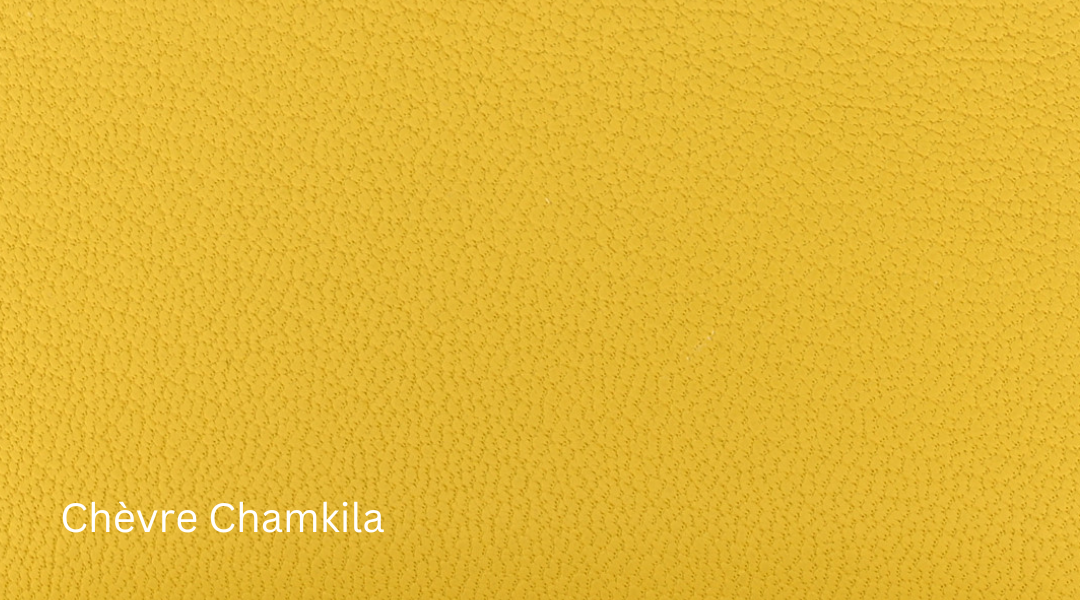
Chèvre Chamkila
Chèvre Chamkilight
Chèvre Chamkilight is a premium variation of goatskin leather, typically reserved for smaller bags and SLGs. While details remain limited, it is prized for its natural sheen, which is further elevated in the coveted Doré shade – a limited-edition metallic finish that enhances its luminous appeal.
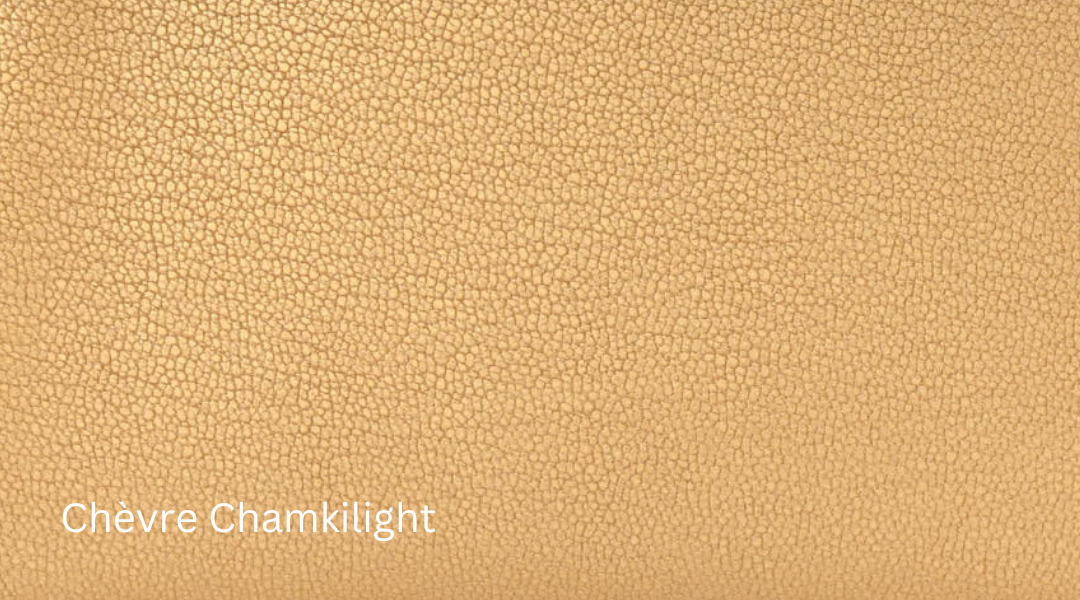
Chèvre Chamkilight
Evergrain
Known as Evercalf leather’s sister, Evergrain is embossed with a specific crackled motif, resulting in a soft feel. Due to this finish, Evergrain is more prone to scratches – more so than any other embossed Hermès leather. Although minor marks can be buffed out at home, more significant scuffs will need to be addressed at the Hermès Spa.
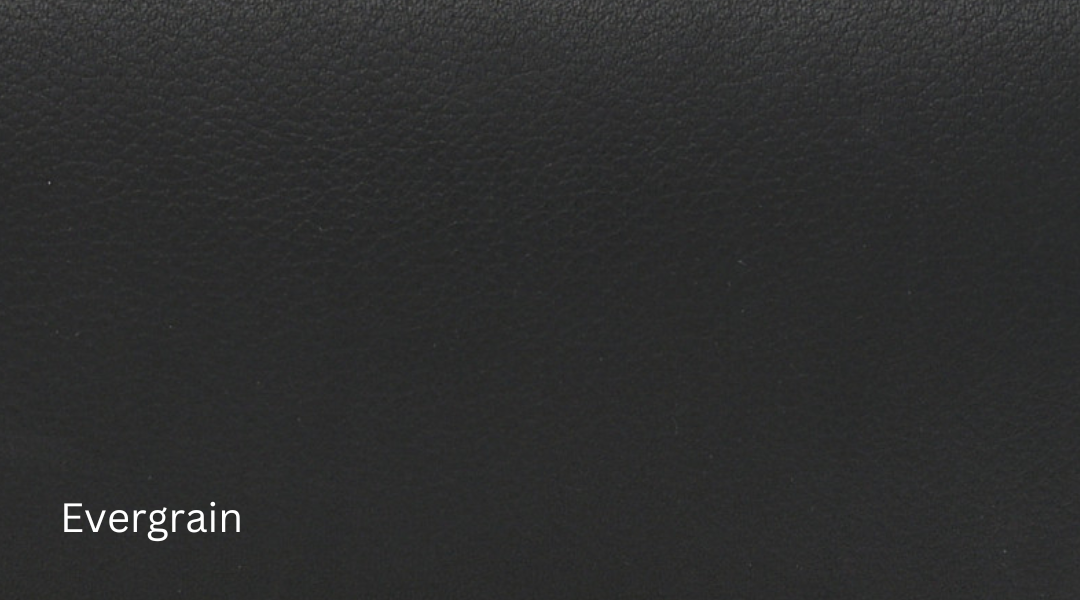
Evergrain Leather
Madame
Similar to Epsom leather, Hermès Madame features a finer grain and softer feel. Known for being relatively lightweight, it also has a subtle sheen. Madame leather is most commonly used to produce Birkins and Kellys in the Sellier style.
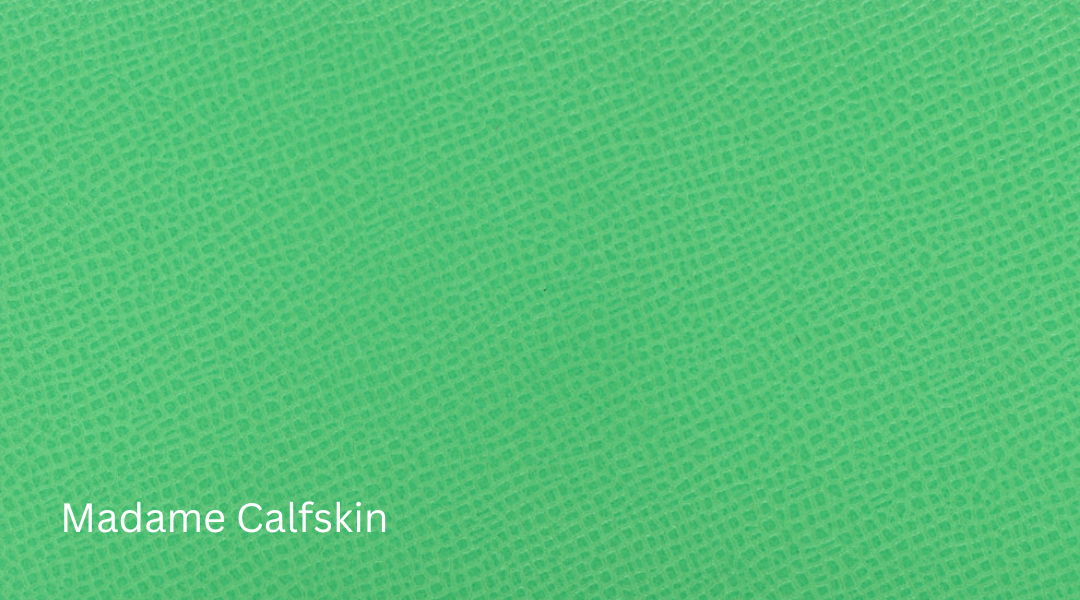
Madame
Milo Lambskin
Although Hermès doesn’t use lambskin leather for its handbags, the Maison offers small leather goods and, notably, handbag charms crafted from delicate soft leather like Milo lambskin. Known for its softness, Milo lambskin absorbs color beautifully, making it an ideal choice for bag charms – most commonly the iconic Rodeo and Pegase, which are not subjected to heavy wear and tear.

Milo Lambskin
Negonda
Introduced in 2007, Negonda leather is recognized for its large, textured grain. This male calf leather is completely water-resistant and is therefore often used in large bags and everyday offerings, and has been particularly favored for the Garden Party.
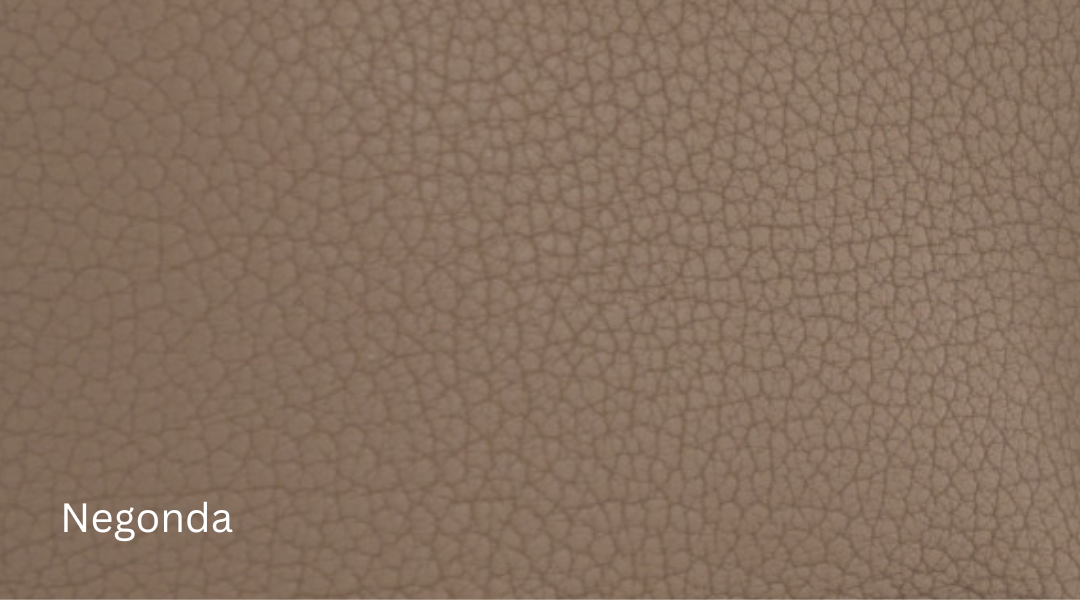
Negonda
Tadelakt
At first glance, Tadelakt can easily be confused with Box Calf leather. While it shares many of the same qualities, Tadelakt is softer and more lustrous, without any visible graining. However, like Box Calf leather, Tadelakt is susceptible to scratches and can blister when exposed to water.
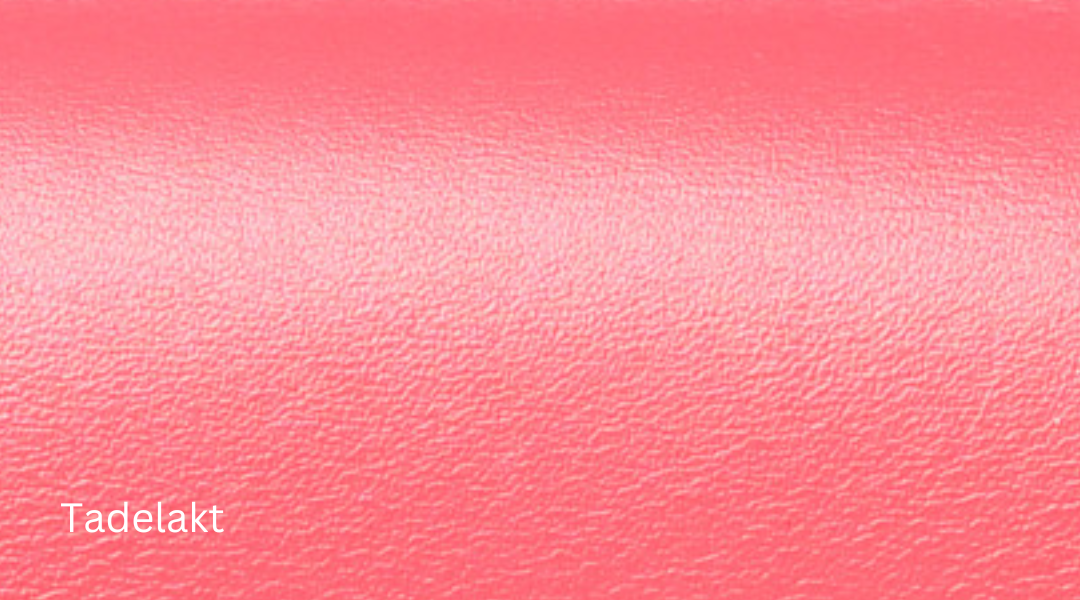
Tadelakt
Taurillon Novillo
Taurillon Novillo leather was first introduced by Hermès in 2015. Sourced from bull hides, this leather has a very fine, natural grain that offers a smoother finish than Togo or Clemence. While its texture can resemble Togo or Evercolor, Taurillon Novillo leather has a substantial feel, and is less structured and more prone to scratches. Known for absorbing colors beautifully, Taurillon Novillo is an ideal choice for vibrant, brightly colored bags.
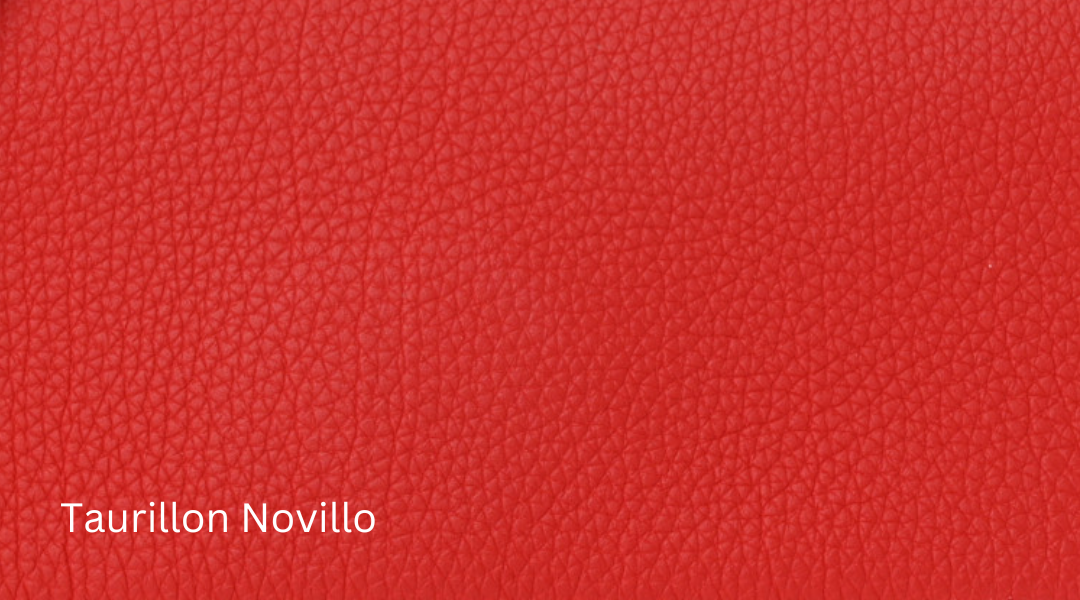
Taurillon Novillo
Vache Liegee
Hermès’ Vache Liegee was introduced in 2004, as a replacement for Ardennes leather, which was discontinued in the early 2000s. Vache Liegee, made from male calves, is the Maison’s thickest leather, known for its exceptional rigidity, making it ideal for larger bags and structured designs. Unlike Ardennes, which was prone to fading over time due to its dyeing process, Vache Liegee is a more resilient option.
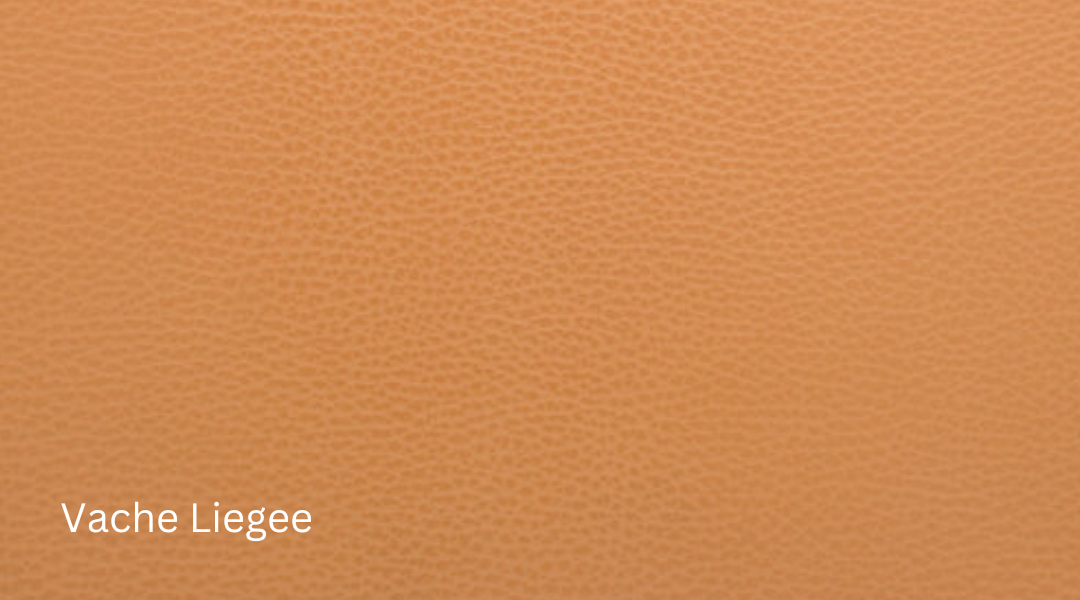
Vache Liegee
Veau Doblis
The ‘original’ version of Hermès suede, Veau Doblis, dates back to the 1930s. It features a smooth touch and a napped finish; however, like most suedes, it is highly sensitive to water. Additionally, discoloration can occur over time, particularly on the handles. Veau Doblis is famously featured in the coveted Hermès Teddy Kelly.
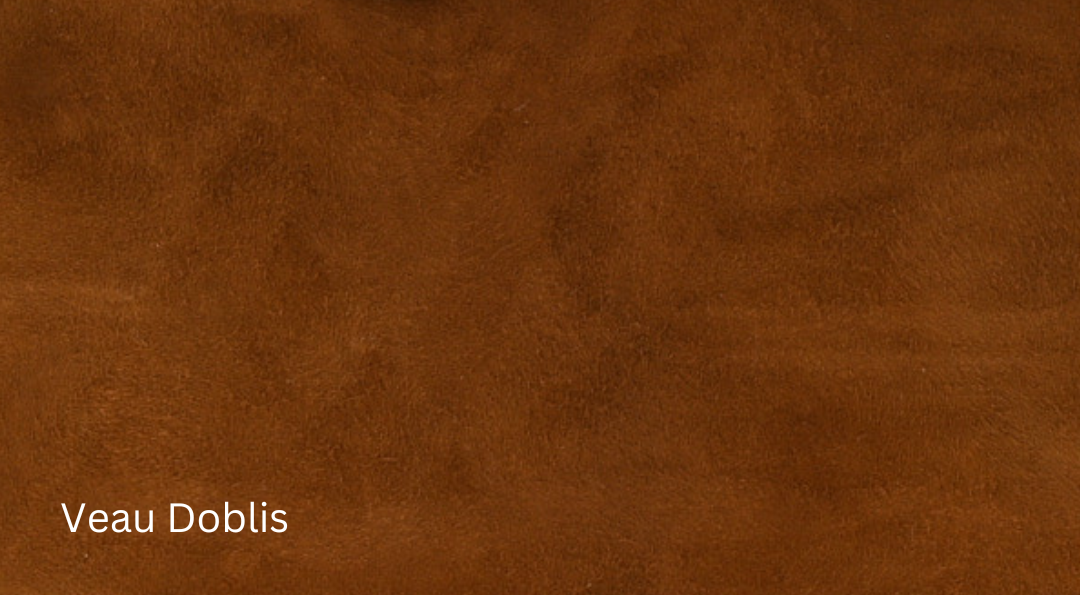
Veau Doblis
Veau Grizzly
Hermès expanded its suede lineup in 2010, with the launch of Veau Grizzly. While similar in softness to Veau Doblis, Grizzy is distinguishable due to its longer nap, thicker texture, and rougher appearance, which is created by a sanding process.
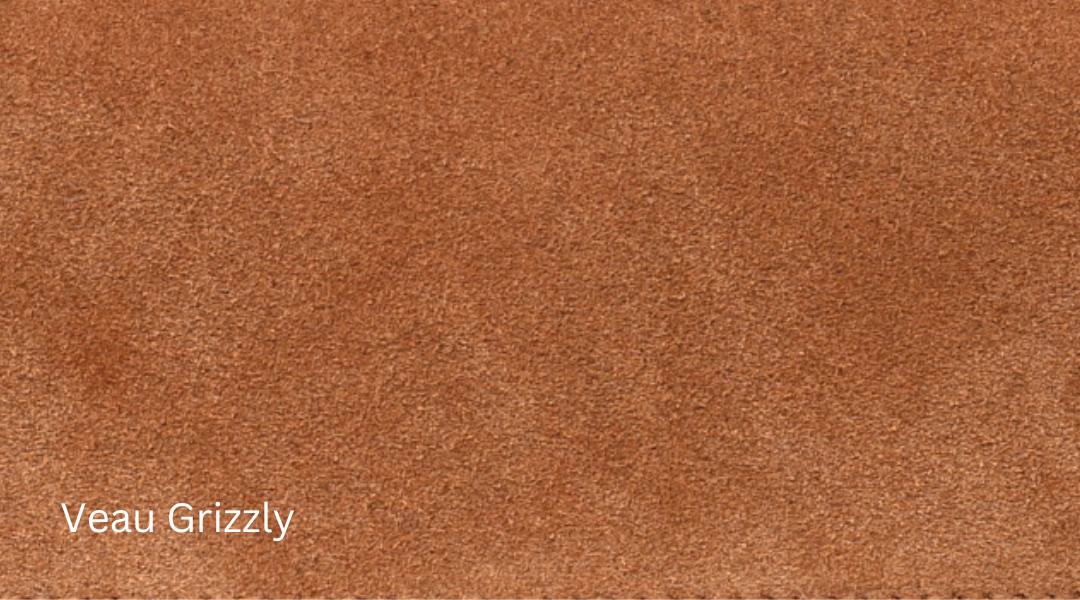
Veau Grizzly
Volynka
Volynka leather, also known as Russian leather, is renowned for its robust and durable qualities, Volynka features a distinctive cross-hatched pressed grain that resists wear. Volynka leather is celebrated in select Hermès bags – the Bolide Voyage, Haut à Courroies, and Plume Voyage.
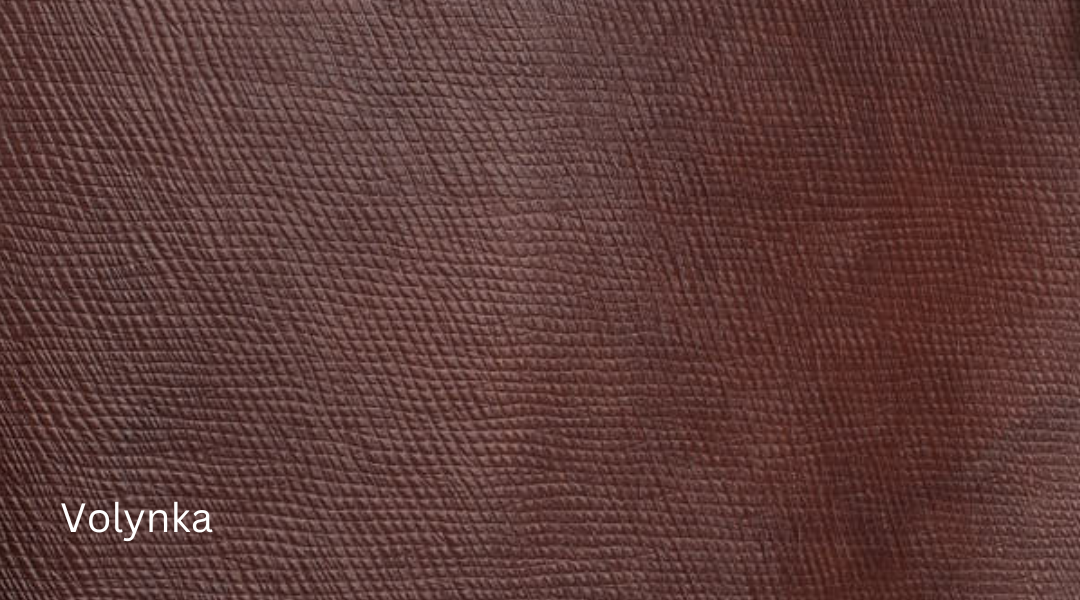
Volynka
Caring for Hermès Leathers and Skins
Whether you’re lucky enough to own a Hermès bag or several, you’ll want to ensure they last a lifetime. Hermès does as well; it offers repair and refresh services for many of its pieces. However, proper maintenance, cleaning, and storage will help keep your bags in good shape. Here are some top tips. . .
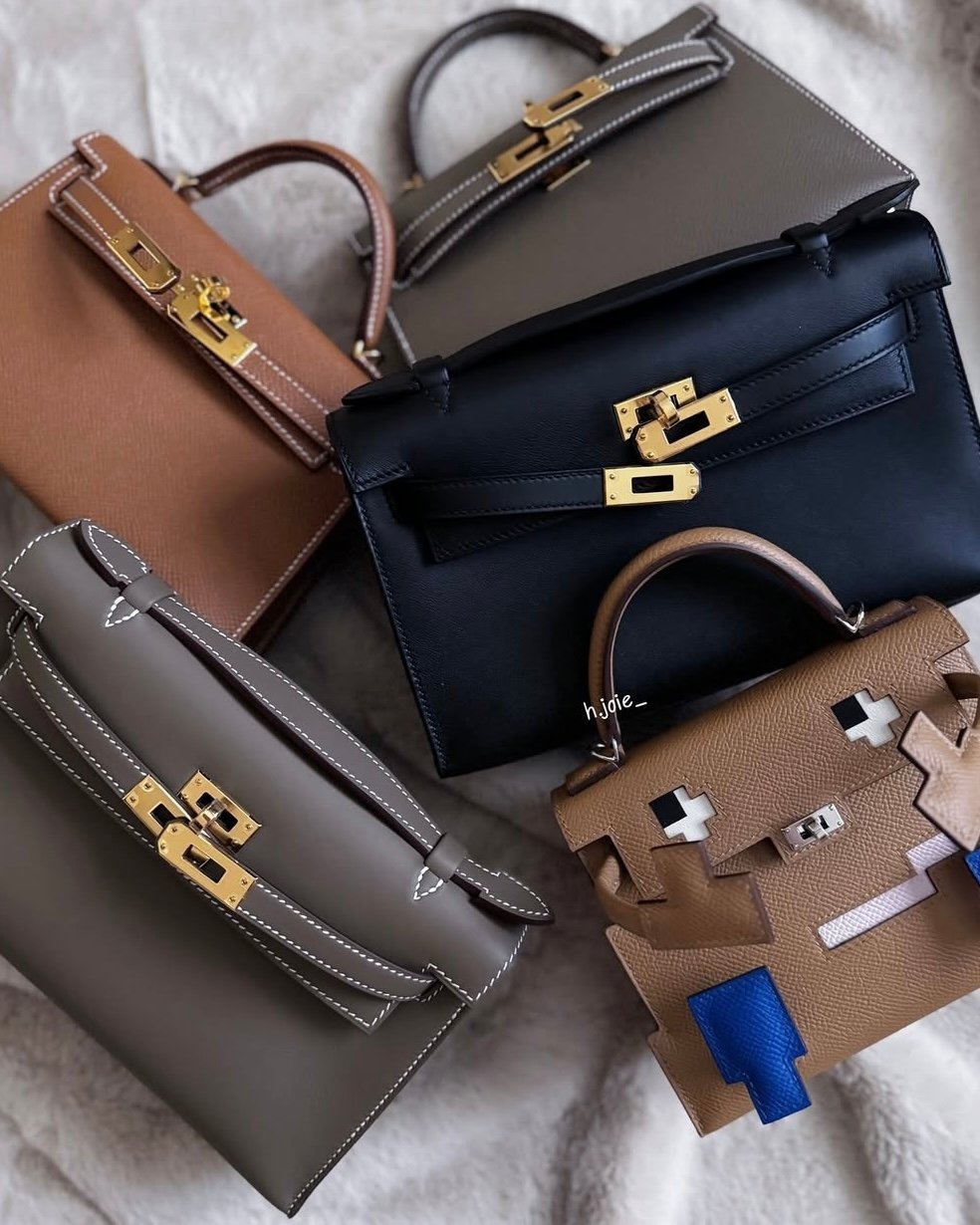
Image courtesy: @h.joie_
Essential Tips for Leather Care
Here are some key tips for maintenance, cleaning, and storage.
Maintenance
- Avoid Scratches and Scuffs: Keep bags away from rough surfaces and handle them with care.
- Elevate Your Bag: Use a handbag hook instead of placing it on the floor to avoid damage.
- Avoid Overloading: Avoid filling bags with bulky things that may distort their shape.
- Mind Your Contents: Keep loose pens, cosmetics, and perfume out, or store them within a pouch to prevent permanent stains.
- Prevent Color Transfer: Limit contact with dark textiles, such as denim, especially with lighter-colored bags.
- Weather Precautions: Protect bags from rain and snow. Use a handbag raincoat or avoid using the bag in bad weather.
- Rotate Your Collection: Give each bag a chance to be used and seen. It will help prevent wear and tear.
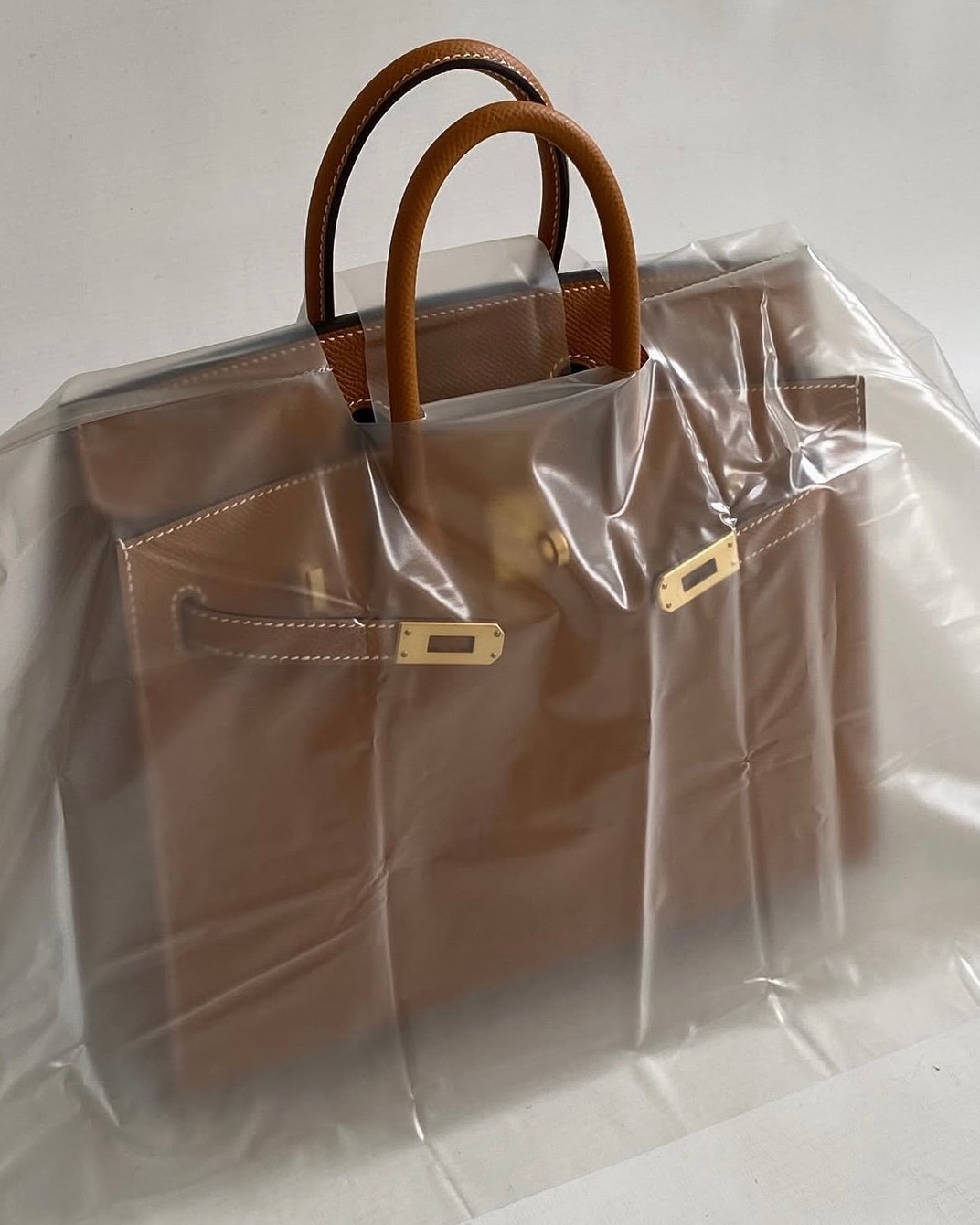
Image courtesy: @looxlikecarrie
Cleaning
- Regular Maintenance: Wipe bags with a clean, soft, lint-free cloth to remove dust and dirt after use and periodically when in storage.
- Deep Cleaning: Steer clear of commercial care products entirely, and have your bags cleaned by Hermès’ experts at the Hermès Spa.
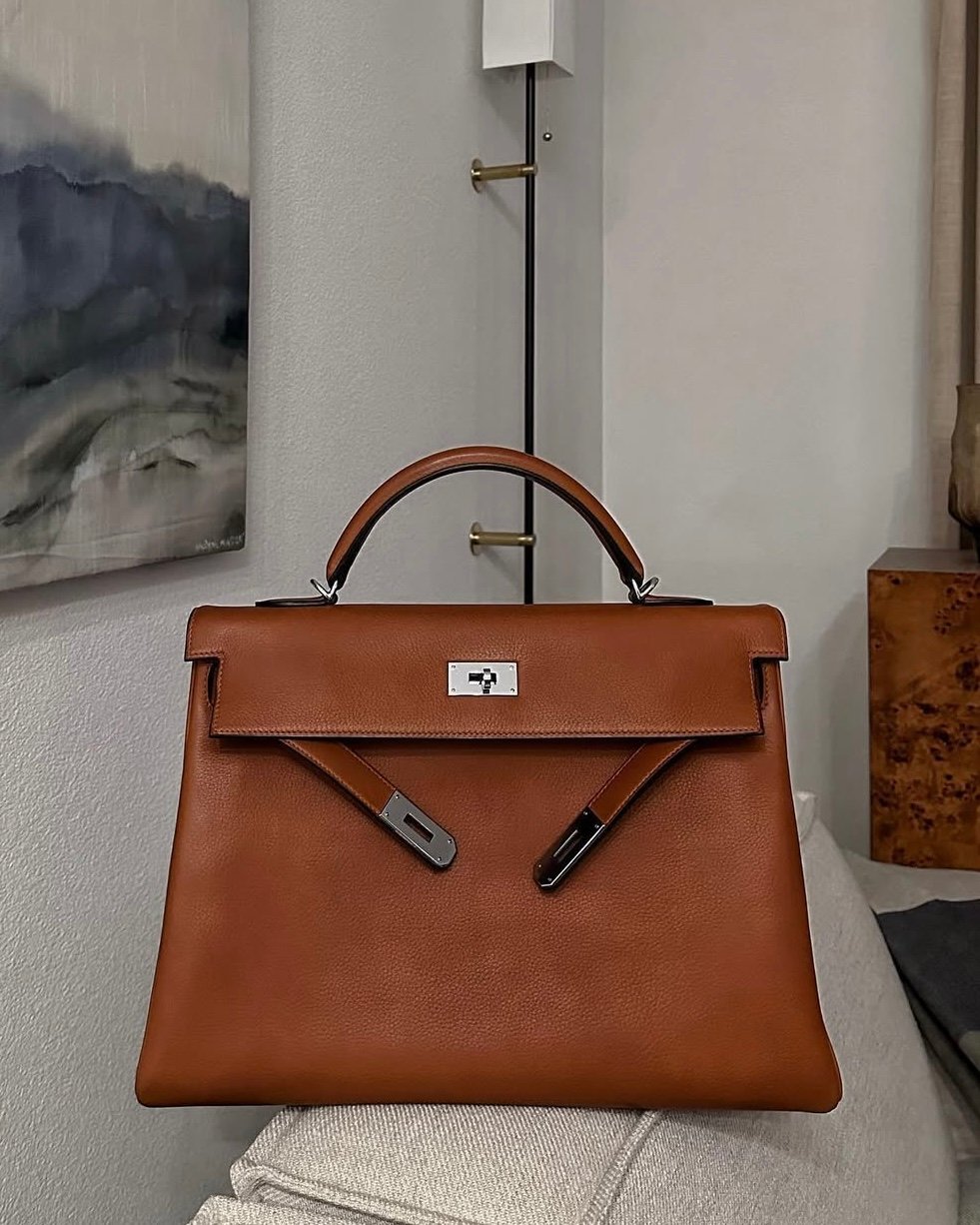
Image courtesy: @heynixon
Storage
-
- Ideal Conditions: Store bags in a cool, dry place away from direct sunlight and moisture, preferably in their original dust bags or boxes.
- Avoid Anti-Humidity Sachets: Refrain from using anti-humidity sachets, as they can dry out the leather over time.
- Maintain Shape: Stuff bags with tissue paper or bubble wrap to prevent sagging but avoid overstuffing.
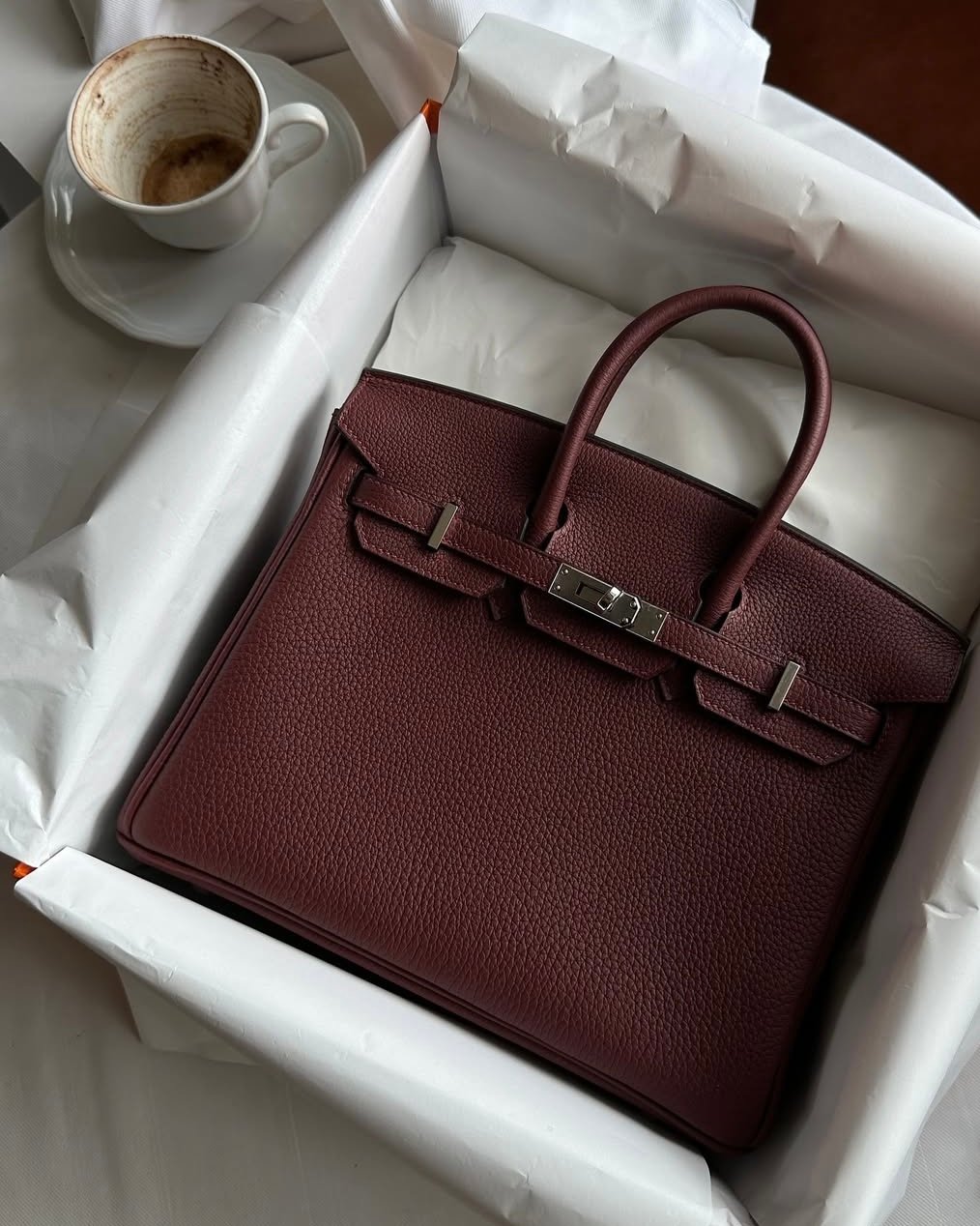
Image courtesy: @masha_lobanovaa
Specialized Care for Exotic Skins
Hermès’ exotic skins require special care and attention to preserve their unique qualities. While these organic materials are sensitive, they can improve with age when properly cared for. Following specific guidelines is essential to extend their longevity.
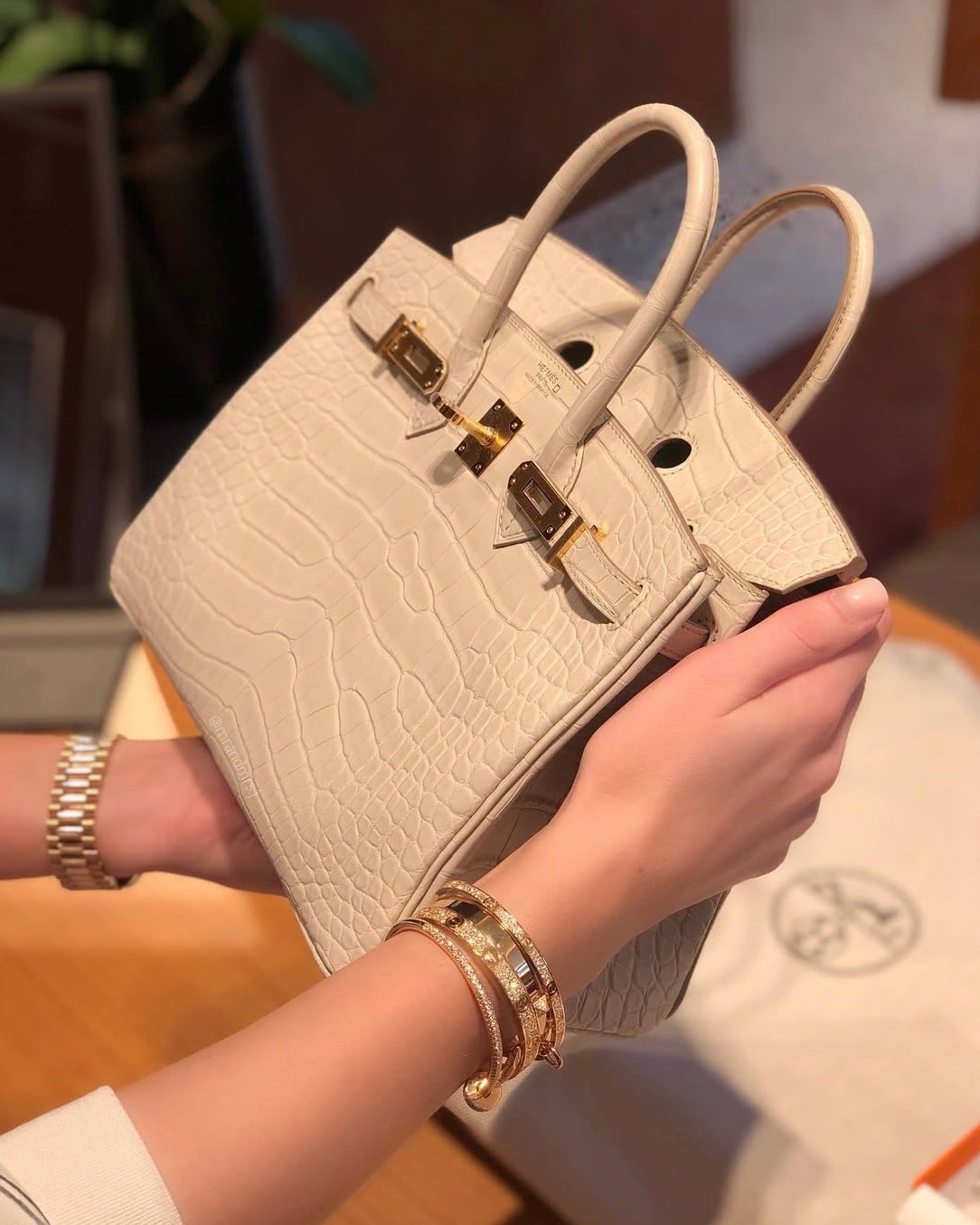
Image courtesy: @mrandmrs.j
Maintenance
- Water and Humidity: Contrary to the animal’s natural habitat, Crocodile and Alligator skins are extremely sensitive to moisture. If subjected to water, blot them immediately with a soft, lint-free cloth to prevent staining or blistering.
- Limit Over-Exposure: Avoid prolonged exposure to intense light and heat, such as direct sunlight, as that can significantly alter the color and texture of exotic skins.
- Prepare for Patina: Over time, exotic skins, particularly Ostrich will develop a natural patina, enhancing its character.
- Prevent Permanent Marks: Ink, lipstick, and fragrances can leave lasting impressions, so avoid storing these items in your exotic bags.
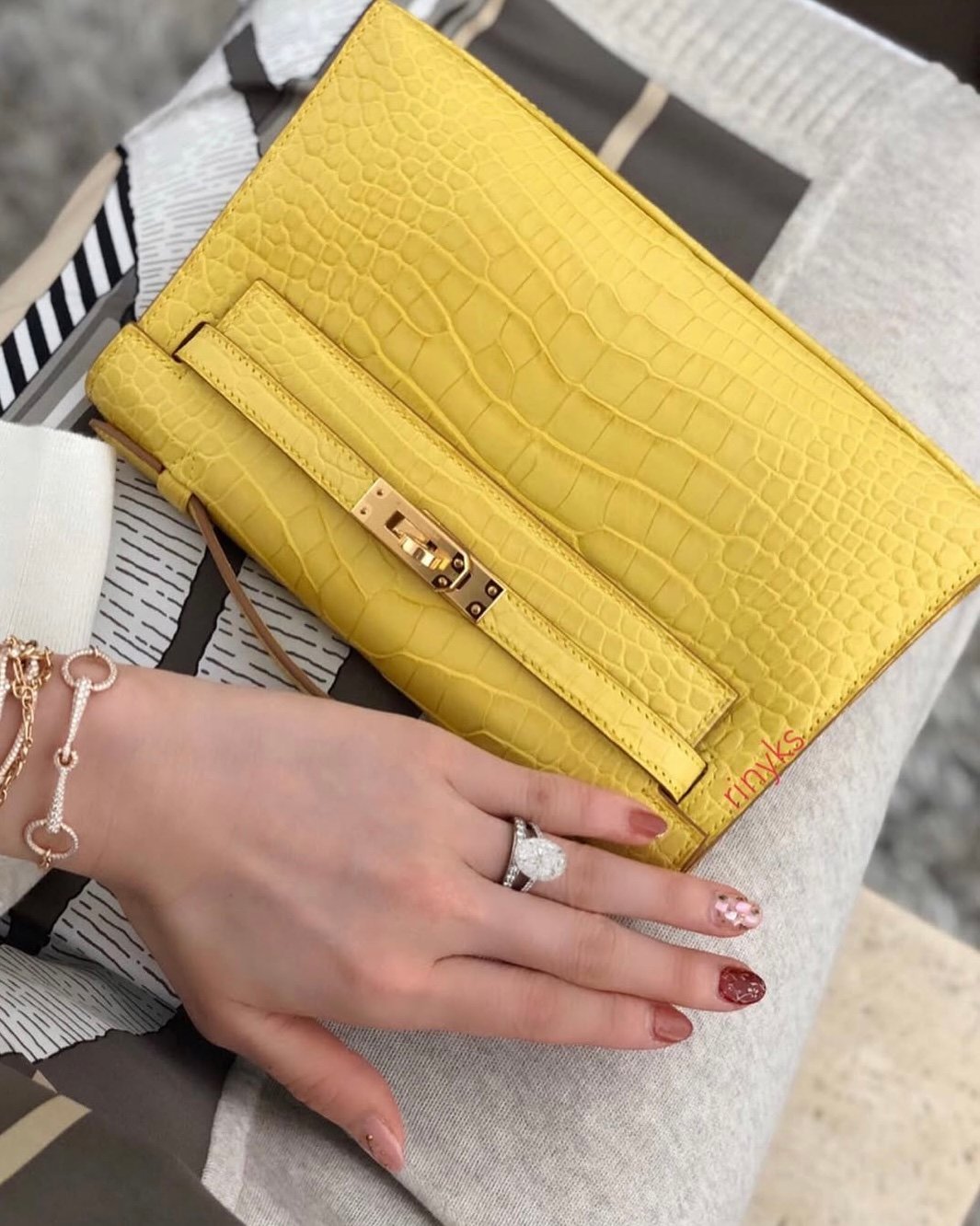
Image courtesy: @rinyks
Cleaning
- Routine Wipe Down: Regularly wipe down your exotic skins with a soft cloth to remove dust and dirt.
- Professional Care: For deep cleaning, consult Hermès about their Hermès Spa services.
Storage
- Ideal Conditions: Keep your exotic bags in a cool, dry place away from direct sunlight and moisture. Storing your handbag in its original dust bag is essential for protecting the skin.
- Skip Anti-Humidity Sachets: It’s best to avoid using anti-humidity sachets, as they can dry exotic skin out over time.
- Maintain Shape: Use tissue paper or bubble wrap to help retain the bag’s shape when not in use. Just be careful not to overstuff, as this can cause distortion.
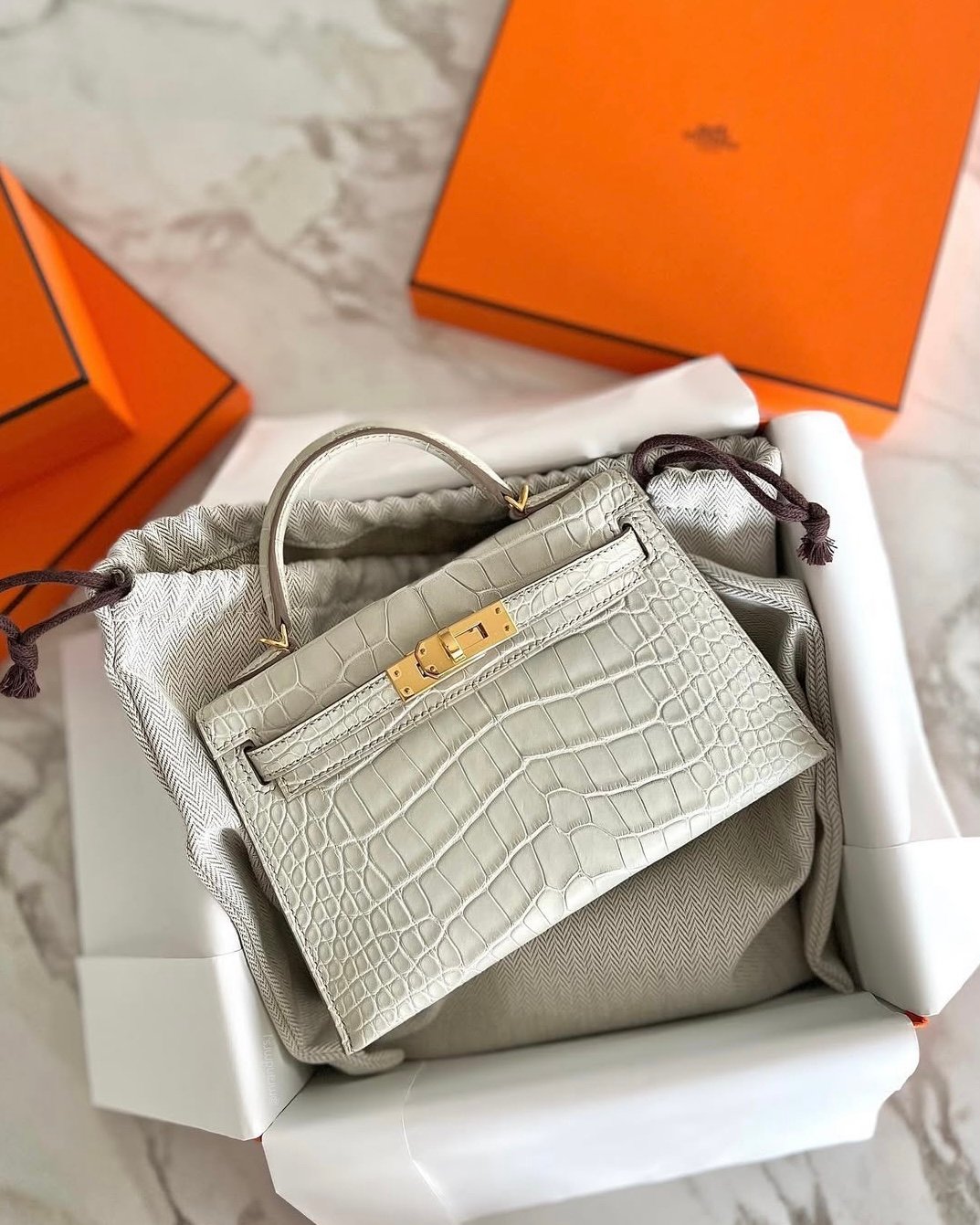
Image courtesy: @mrandmrs.j
Why Hermès Spa Services Matter
Proper care, maintenance, and storage are vital for keeping your Hermès bags in excellent condition, but utilizing the expert services at the Hermès Spa is crucial for ensuring their long-term preservation.
The Hermès Spa provides a range of services, including bag zipper replacements, seam repairs, re-dyeing leather, and more –all designed to keep your items in top condition. Regular visits to the Hermès Spa can rejuvenate your pieces, helping to maintain their beauty and extensive their lifespan
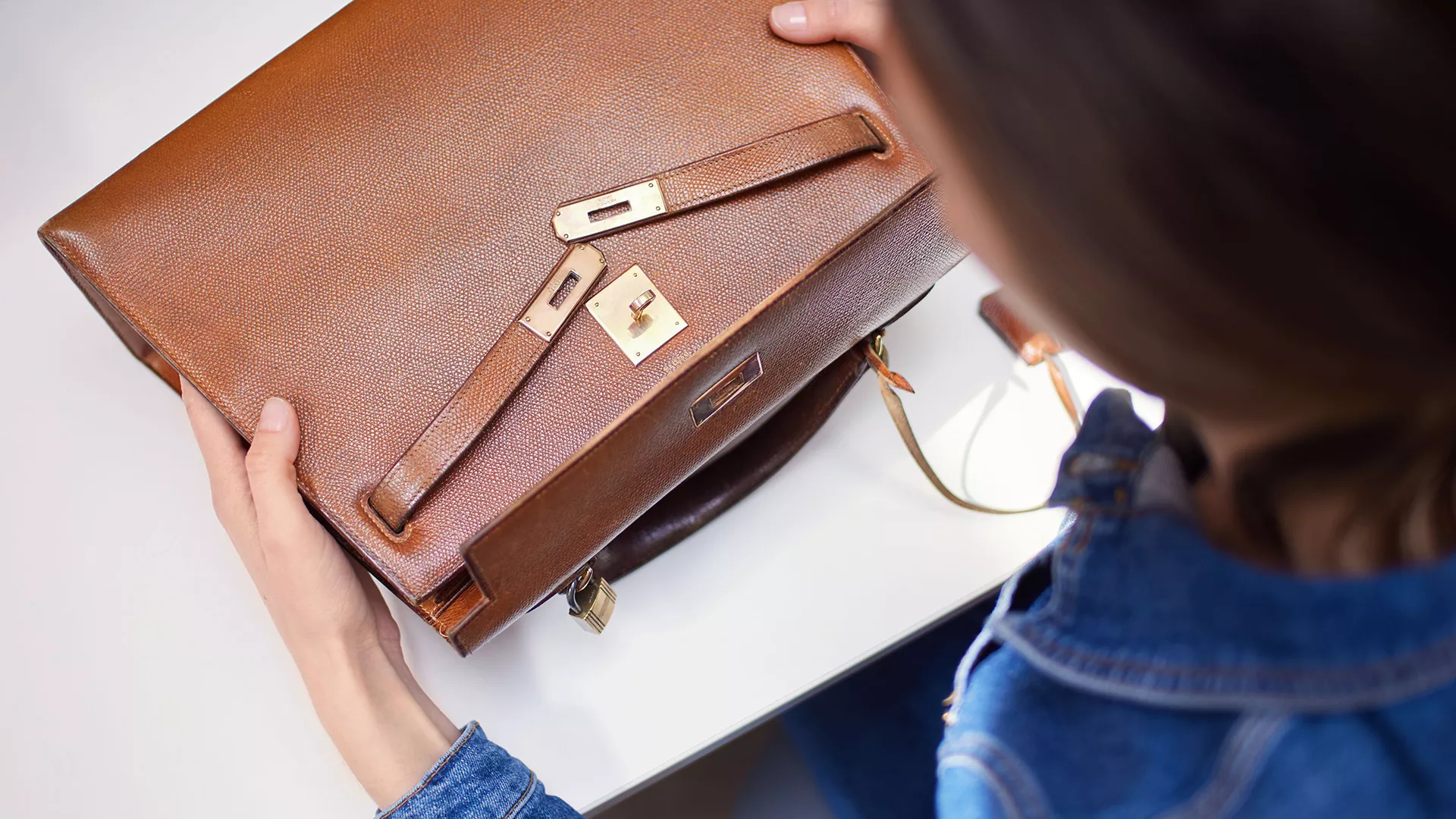
Image courtesy: Hermès
Hermès Materials Beyond Leather
While the world of Hermès revolves around the leather lineup, the Maison also embraces a diverse range of fabrics and materials –ranging from canvas to wool and beyond.
Canvas and Fabrics

Image courtesy: @thebirkinboy
Officier Canvas
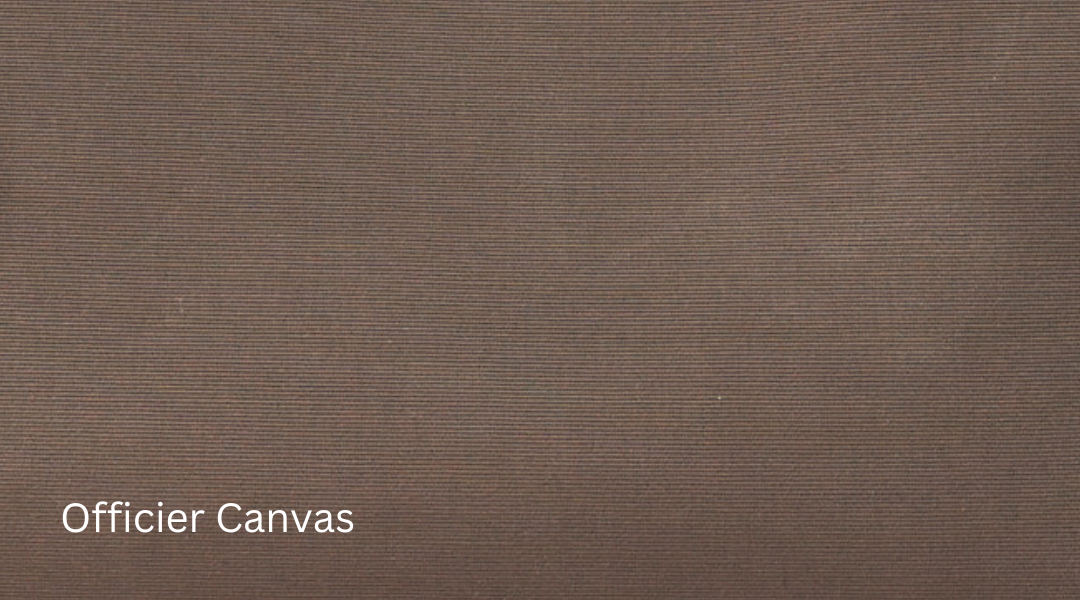
Officier Canvas
This cotton canvas features a smooth, refined fine finish, achieved through its thin, single-color thread construction. It is most commonly found in the Herbag and Garden Party collections.
Military Canvas
Similar to Officier canvas, Military canvas is a smooth, lightweight, yet durable material, commonly used in the construction of the Herbag.
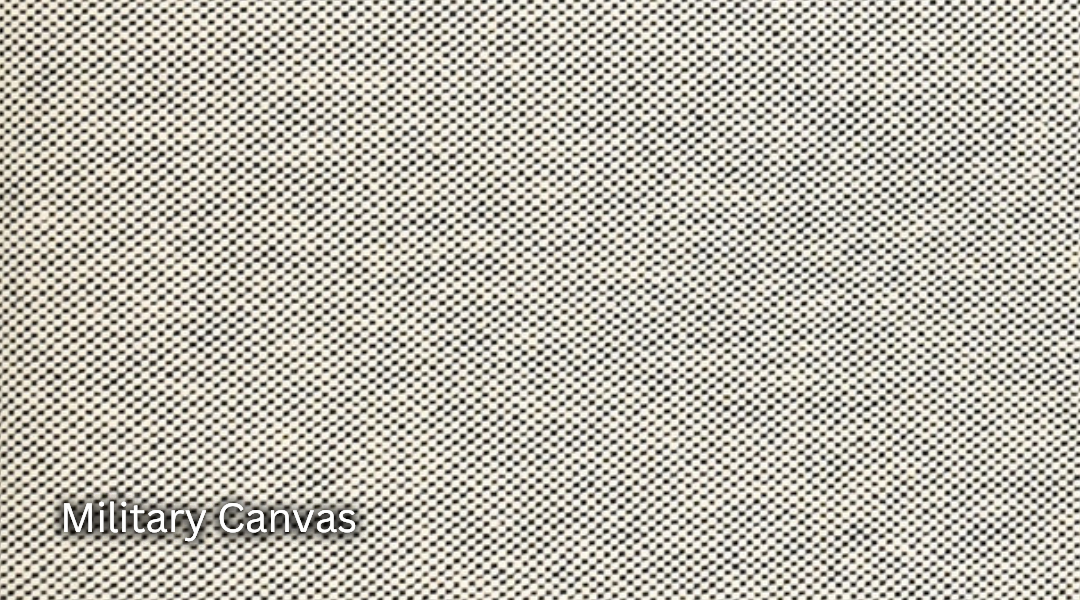
Military Canvas
Berline Canvas
Berline is the most durable of all Hermès’ canvases, featuring a grainier texture with a coated finish that provides a glossy appearance. This canvas is among the most durable and waterproof and is commonly found in the Herbag.
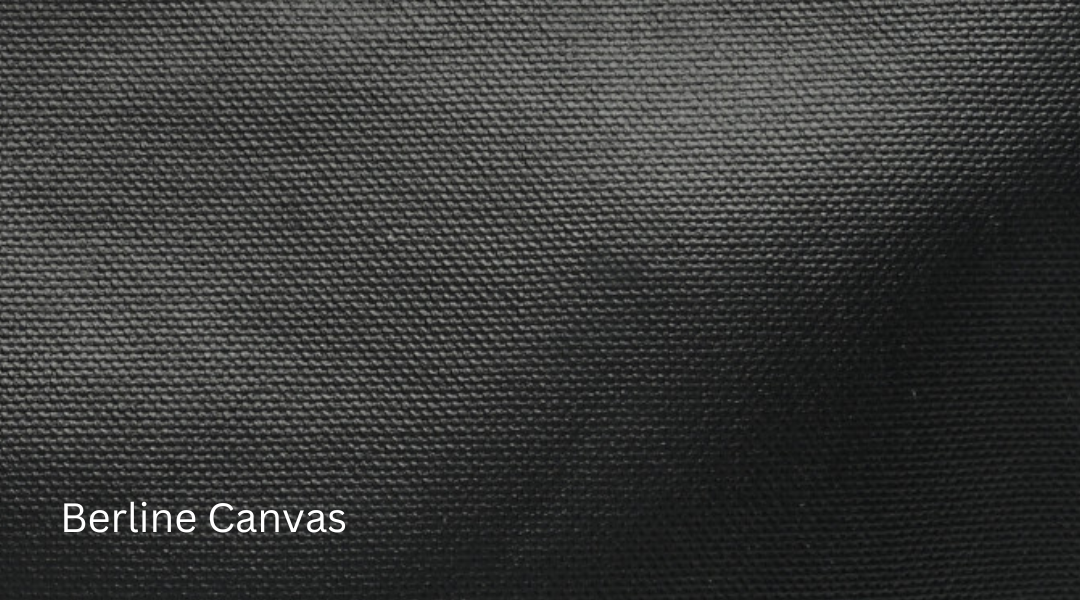
Berline Canvas
Criss Viking
Criss Viking stands out in the Hermès canvas collection with its unique checkerboard pattern, crafted from two different colored threads.
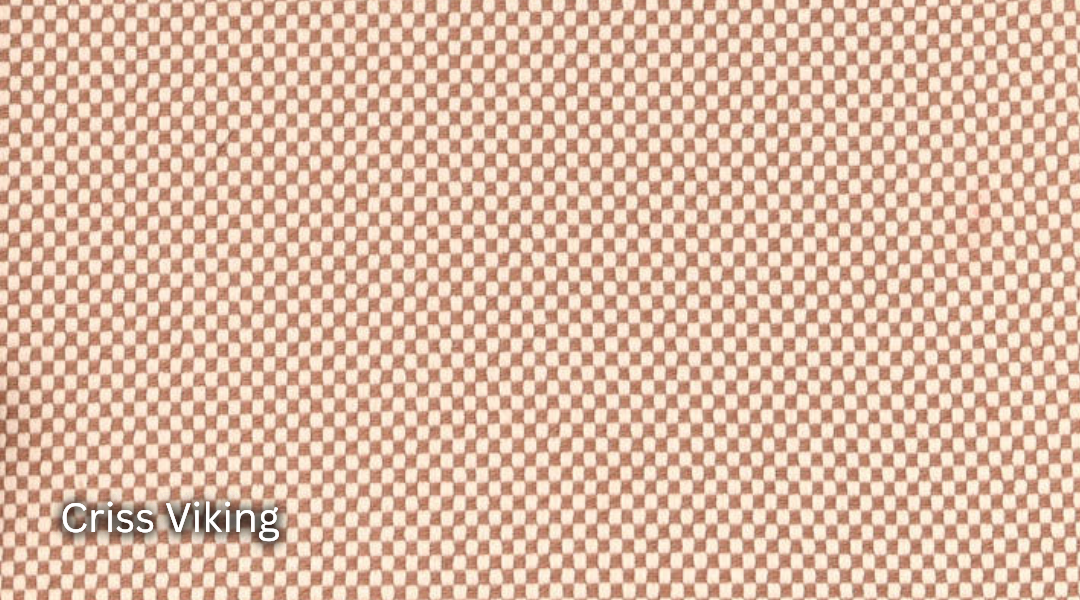
Criss Viking
H Canvas
H Canvas is one of the most recognizable fabrics in Hermès’ canvas lineup, and it is known for its distinctive woven design. It is crafted by intertwining two different colored threads to create the signature motif. Often paired with Hermès leathers, H Canvas features in a range of styles including the Birkin, HAC, Garden Party, and various other totes.
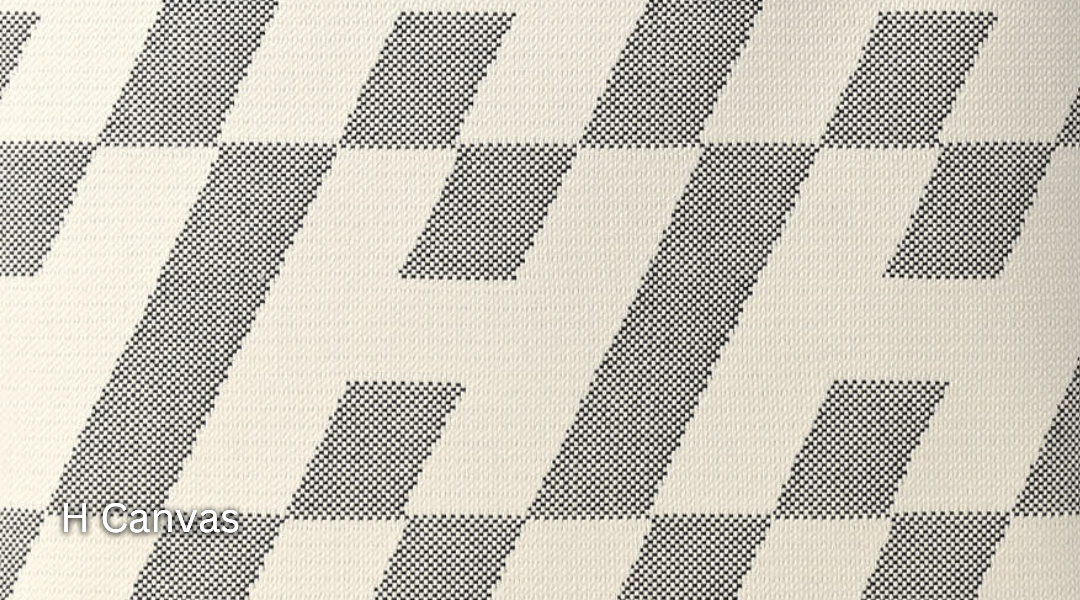
H Canvas
Toile Jean
Another significant cotton canvas in Hermès’ collection is Toile Jean, a durable denim fabric that adds structure to various designs. Although the term ‘Toile Jean’ is used by Hermès to refer to any bag made with denim, there are a variety of denim shades, from light wash to dark indigo. Often paired with leathers, Toile Jean can be found in several Hermès bag styles, including the original Shoulder Birkin as well as its recent reimagined version.
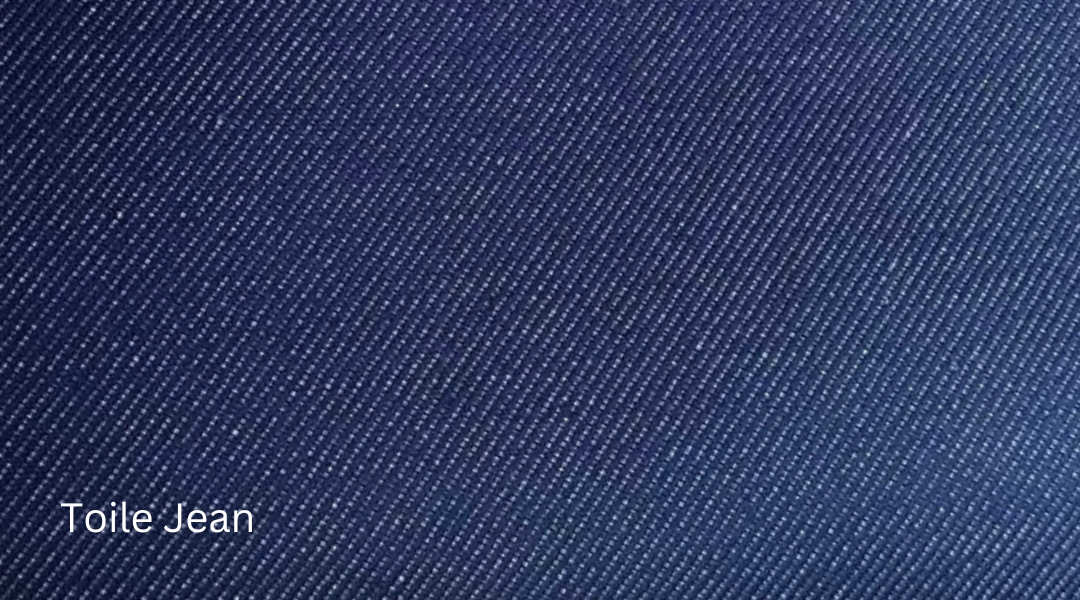
Toile Jean
Feutre Wool
Feutre is a soft, thick, felted wool often paired with leather trim to create a distinctive bi-material look. This wool is most commonly used for alternative iterations of the Hermès Picotin Lock.
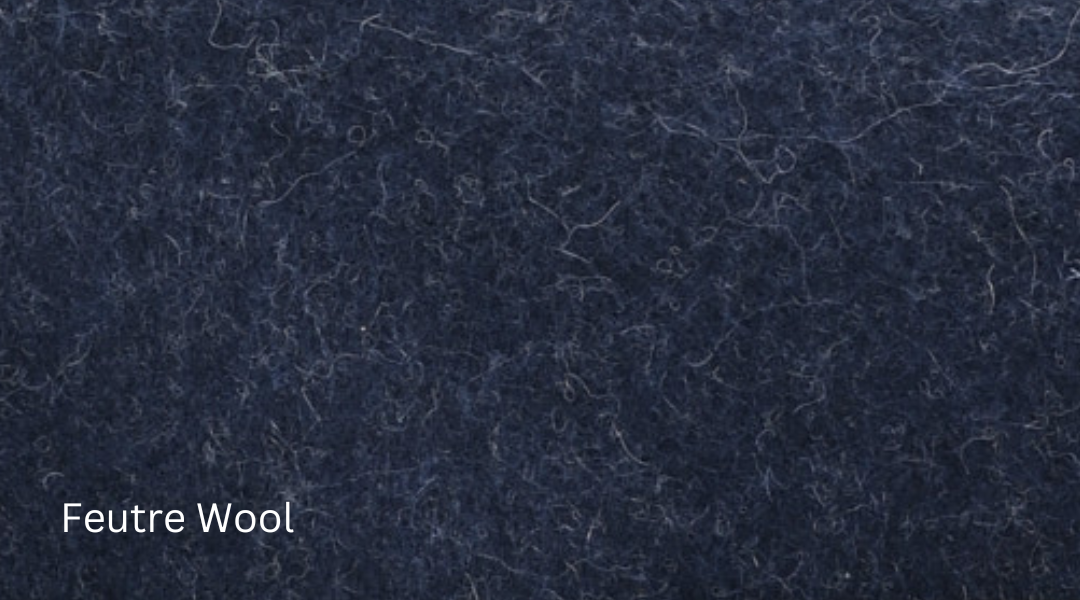
Feutre Wool
Silk
Silk has long been synonymous with Hermès, beginning with its iconic silk scarves, first introduced in 1937, which precede the Maison’s leather handbags. Today, several handbag styles feature a printed silk body paired with leather trim, including the Balusoie and the Sac Lassoie from the upcoming Spring Summer 2025 collection.
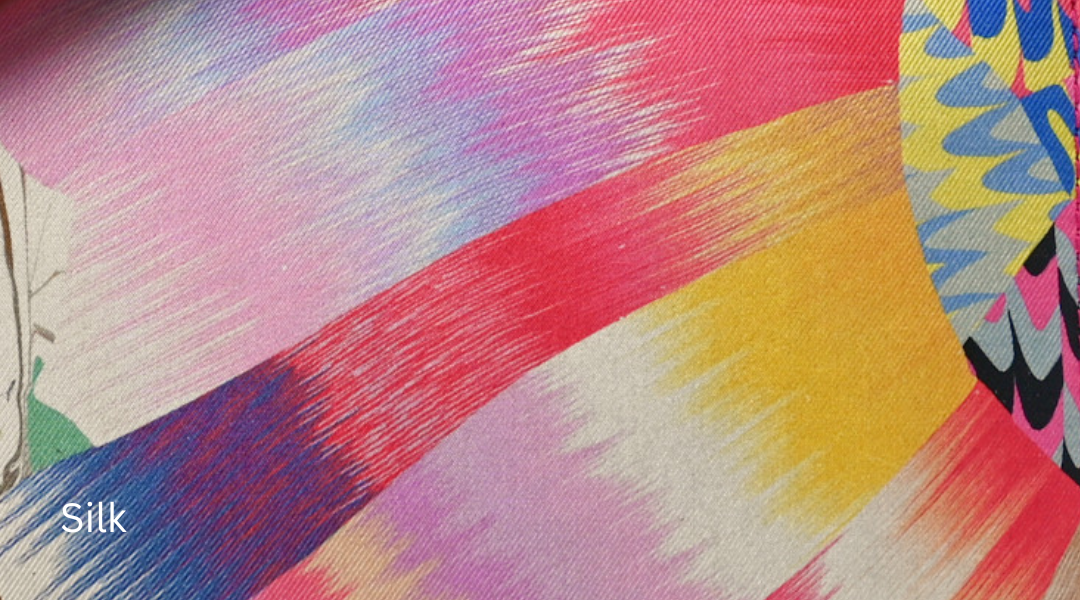
Silk
Innovative Materials
Known for cutting-edge innovation, Hermès continuously pushes the boundaries by incorporating unique materials into its iconic designs, ranging from wood to feathers and everything in between.
One notable example is the Maison’s celebrated use of handwoven Osier wicker, particularly within the coveted Hermès Picnic collection. Creating these exceptional pieces requires two master artisans – a skilled saddler for the leather and an expert basket weaver for the intricate wicker body, a process that can take up to 10 hours.
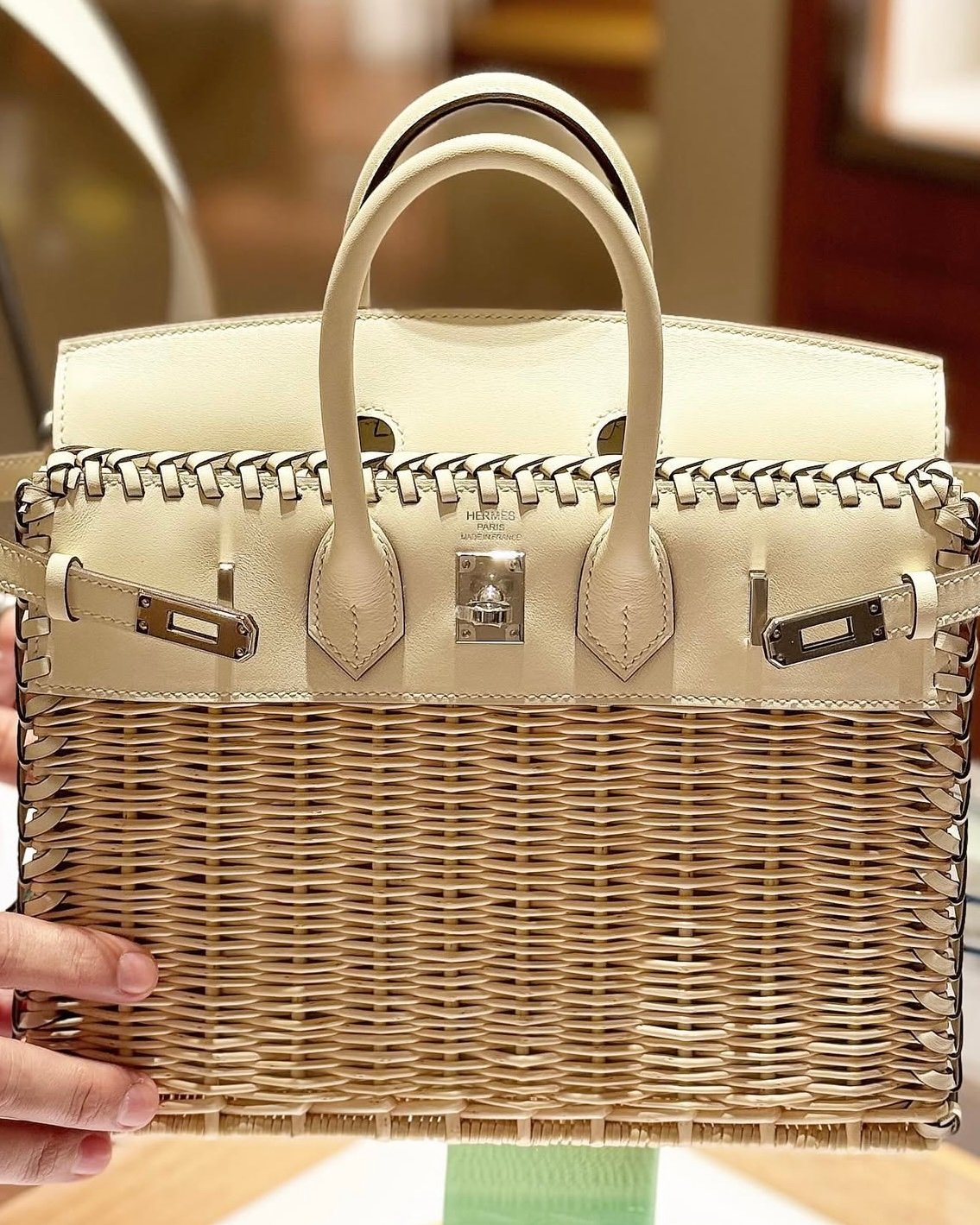
Image courtesy: @itsbreebeach
Hermès recently expanded its woven bag lineup by utilizing horsehair – a material that resonates deeply with the brand’s heritage. In its upcoming Spring-Summer 2025 collection, Hermès unveils the Cabas Tressage and Panier Tressage, each featuring intricate weaves that combine Barenia calfskin and horsehair.
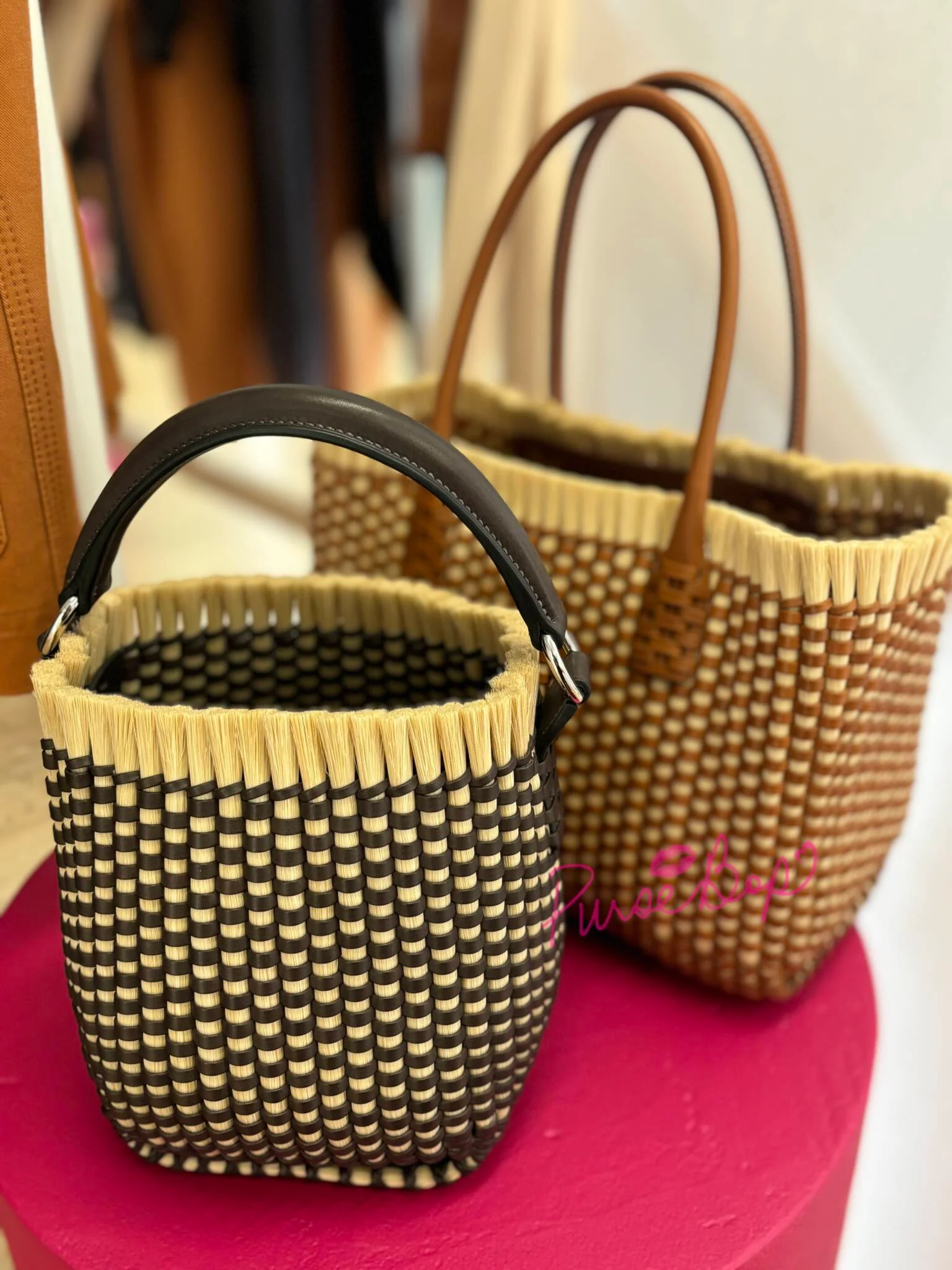
Hermès’ commitment to innovation doesn’t stop there – it extends to even more unusual materials, such as wood. The Hermès Kellywood Perspective Cavaliere Kelly 22 is a remarkable creation, crafted from beechwood and adorned with an intricate design achieved through the Maison’s expertise in marquetry.
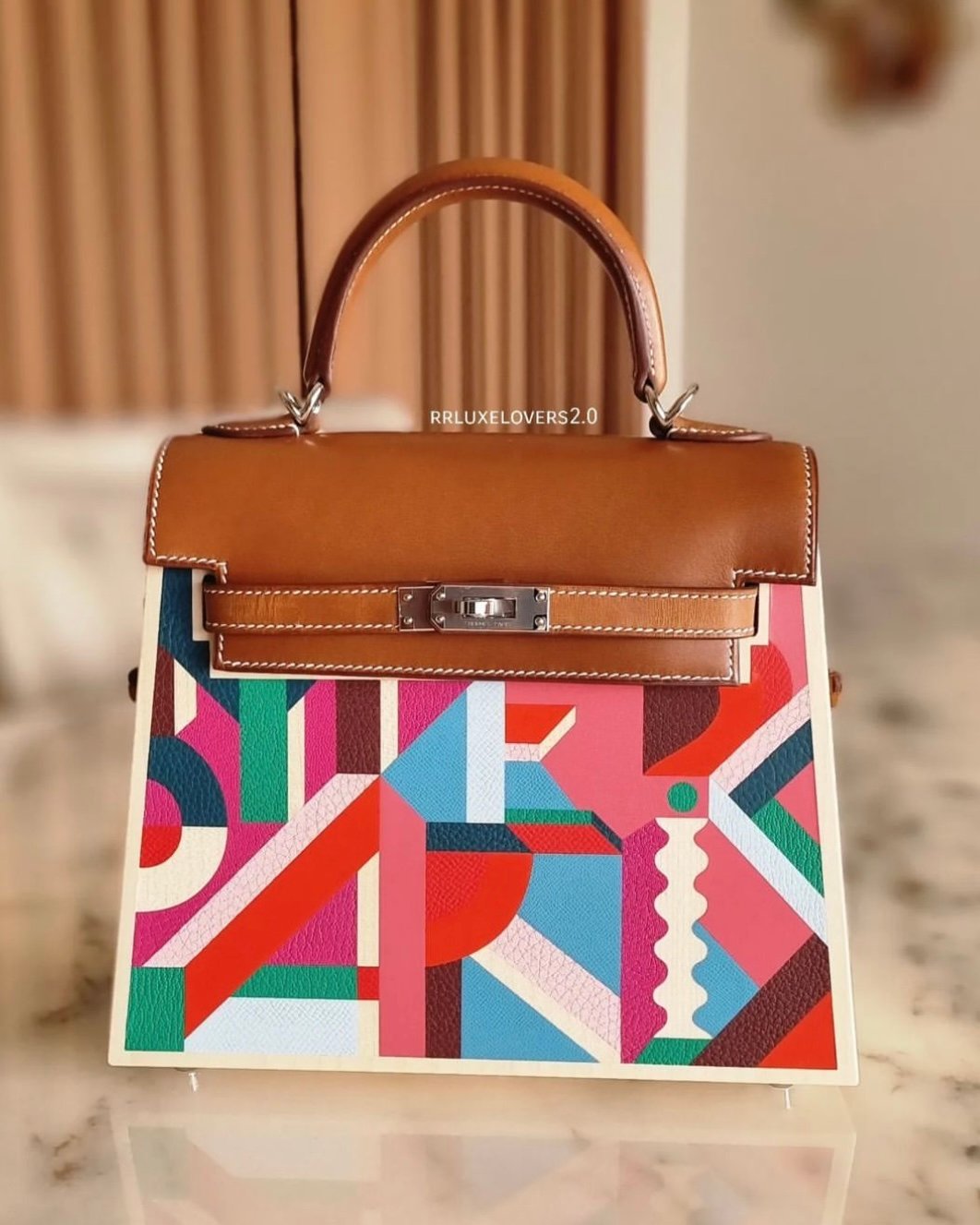
Image courtesy: @rrluxelovers2.0
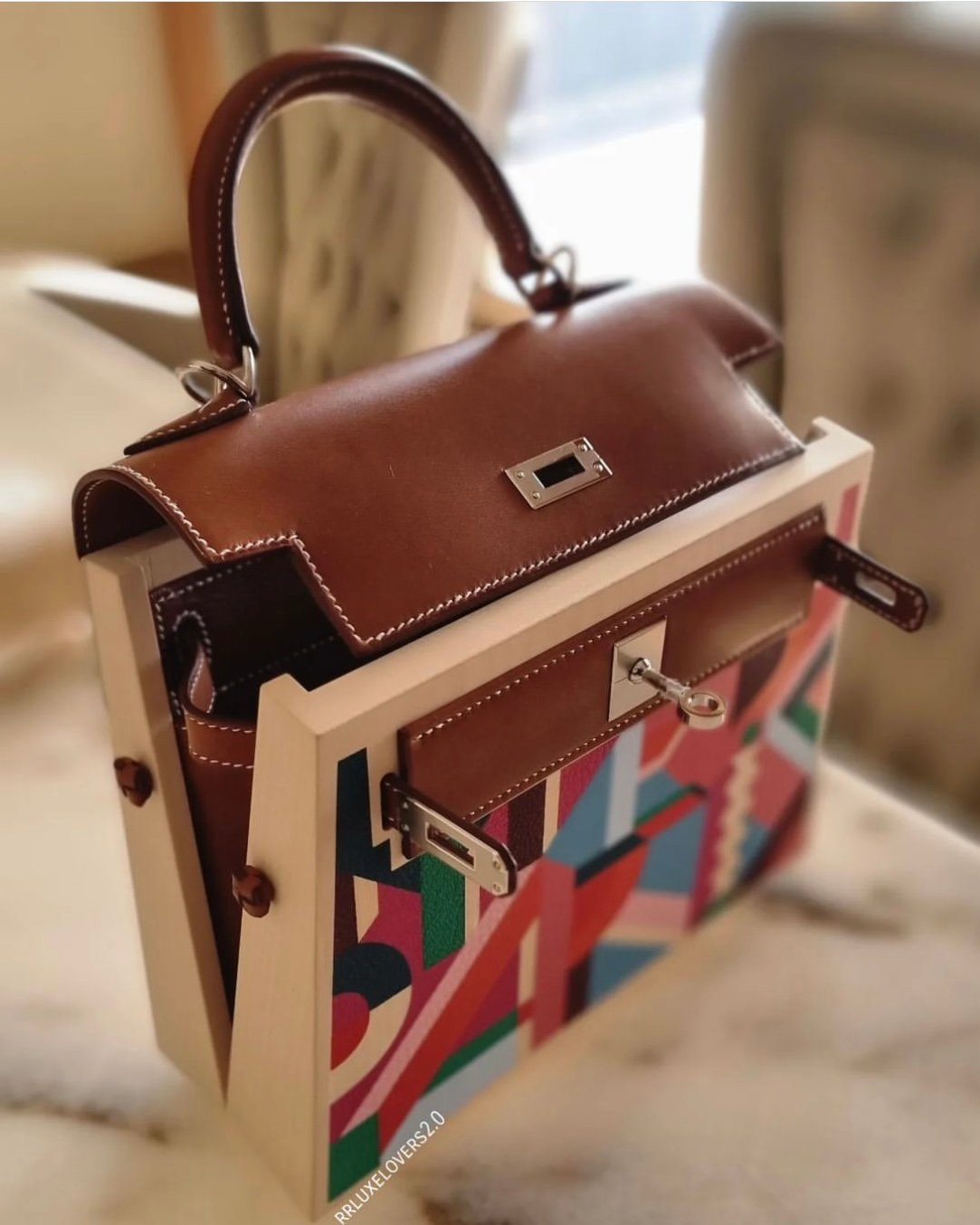
Image courtesy: @rrluxelovers2.0
In addition to its innovative designs, Hermès has also embraced sustainability through the introduction of the Petit h line in 2010. This initiative transforms unused materials and off-cuts into new creations, embodying the motto of Petit h – “Nothing is lost, everything is transformed.”
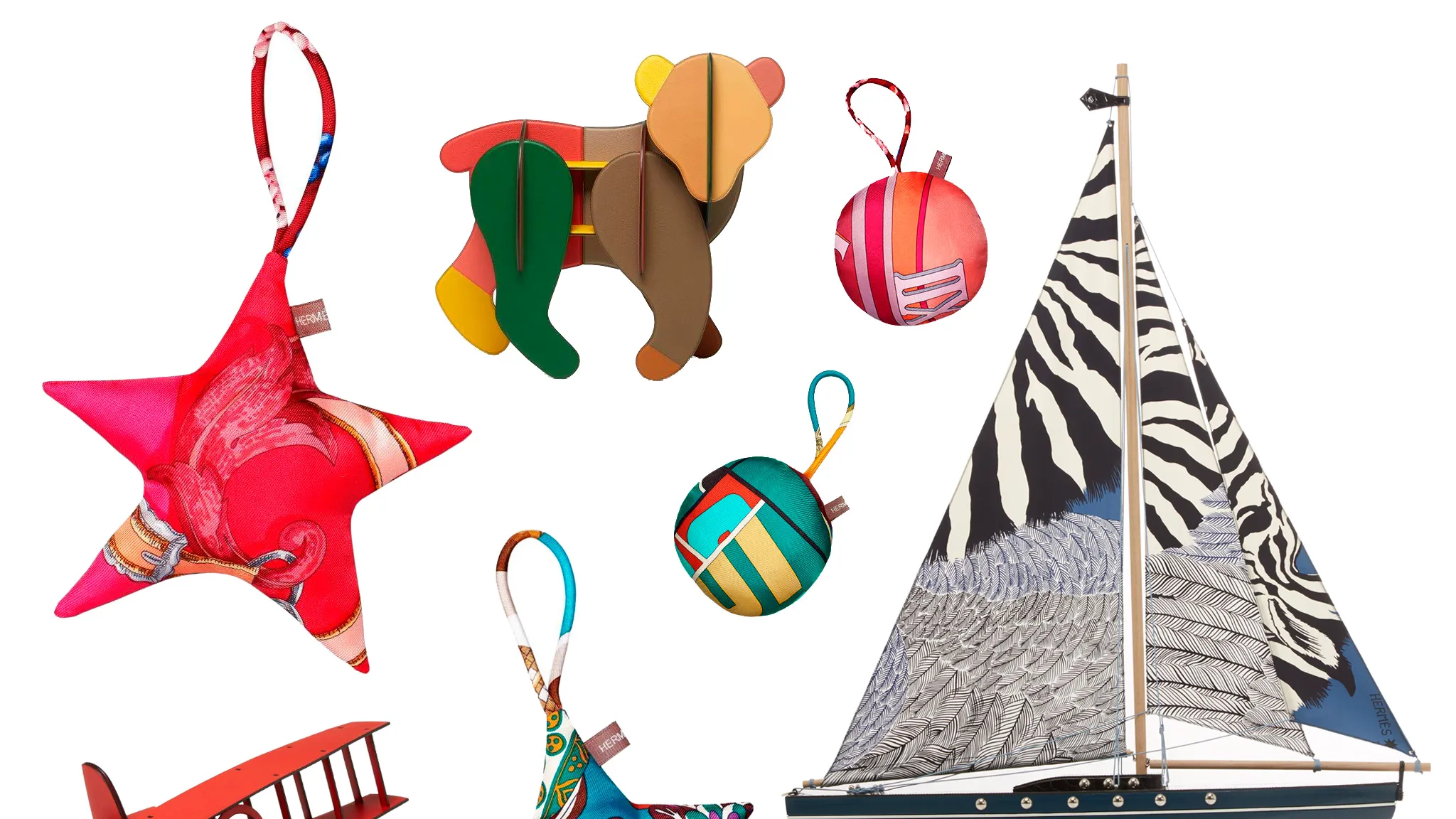
Image courtesy: Hermès via Condé Nast Traveller
Decoding Hermès Leather Markings and Stamps
Like many luxury Maisons, Hermès uses a distinctive system of markings and stamps on its handbags to signify its authenticity and origin.
Each bag is embossed with a unique stamp that indicates the year of manufacture and the artisan involved. Though Hermès’ coding format has evolved – from single letters to letters within circles or squares – date codes remain essential for authenticating Hermès products.
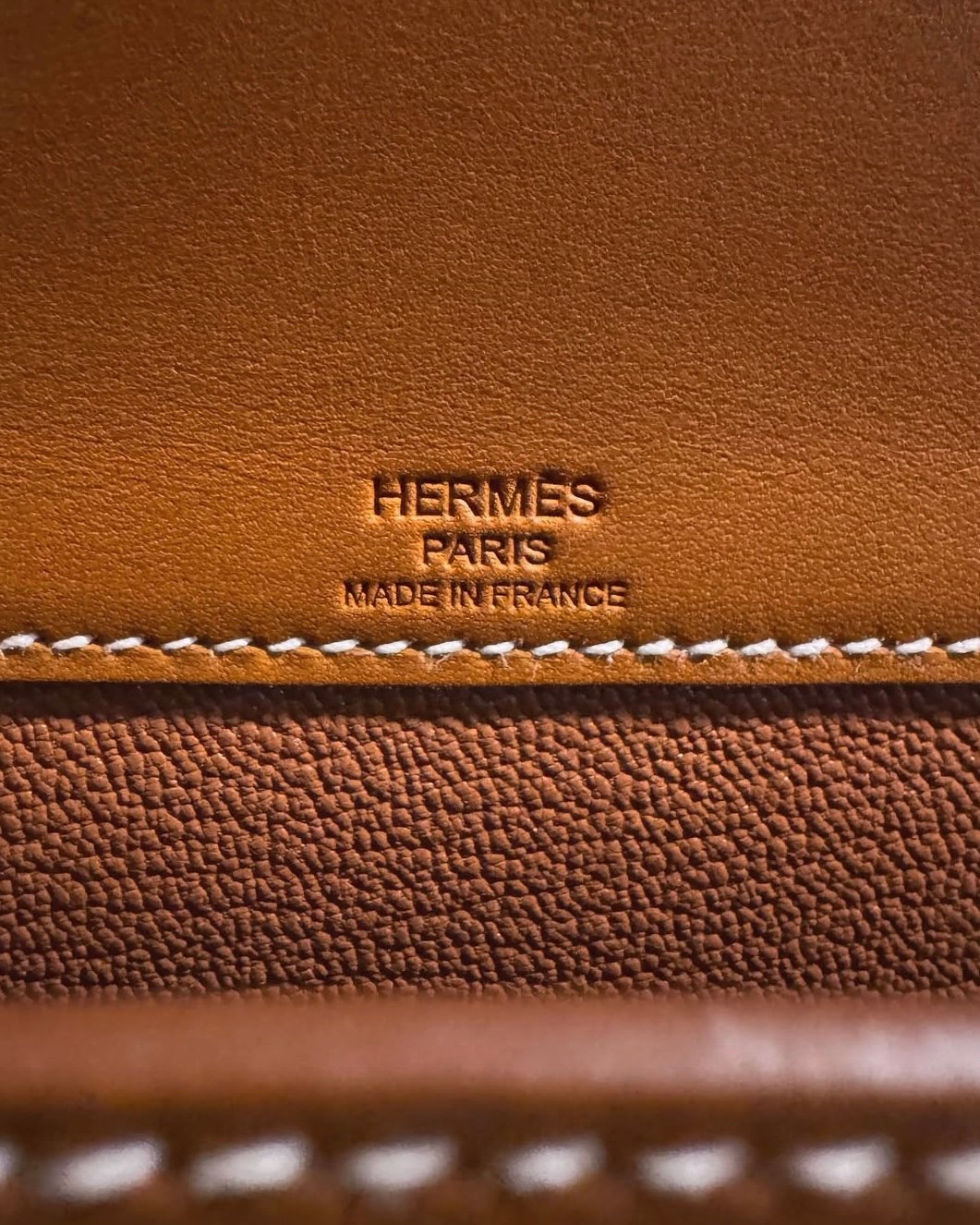
Image courtesy: @heynixon
In addition to date codes, each bag features the ‘Hermès Made in France’ stamp, hot-stamped in a metallic shade that corresponds to the hardware color of the bag. The placement of the stamp can vary depending on the style of the bag. For example, it is located on the interior base of the Picotin, while on the Birkin and Kelly, it is found on the exterior, under the flap, above the Touret fastening.
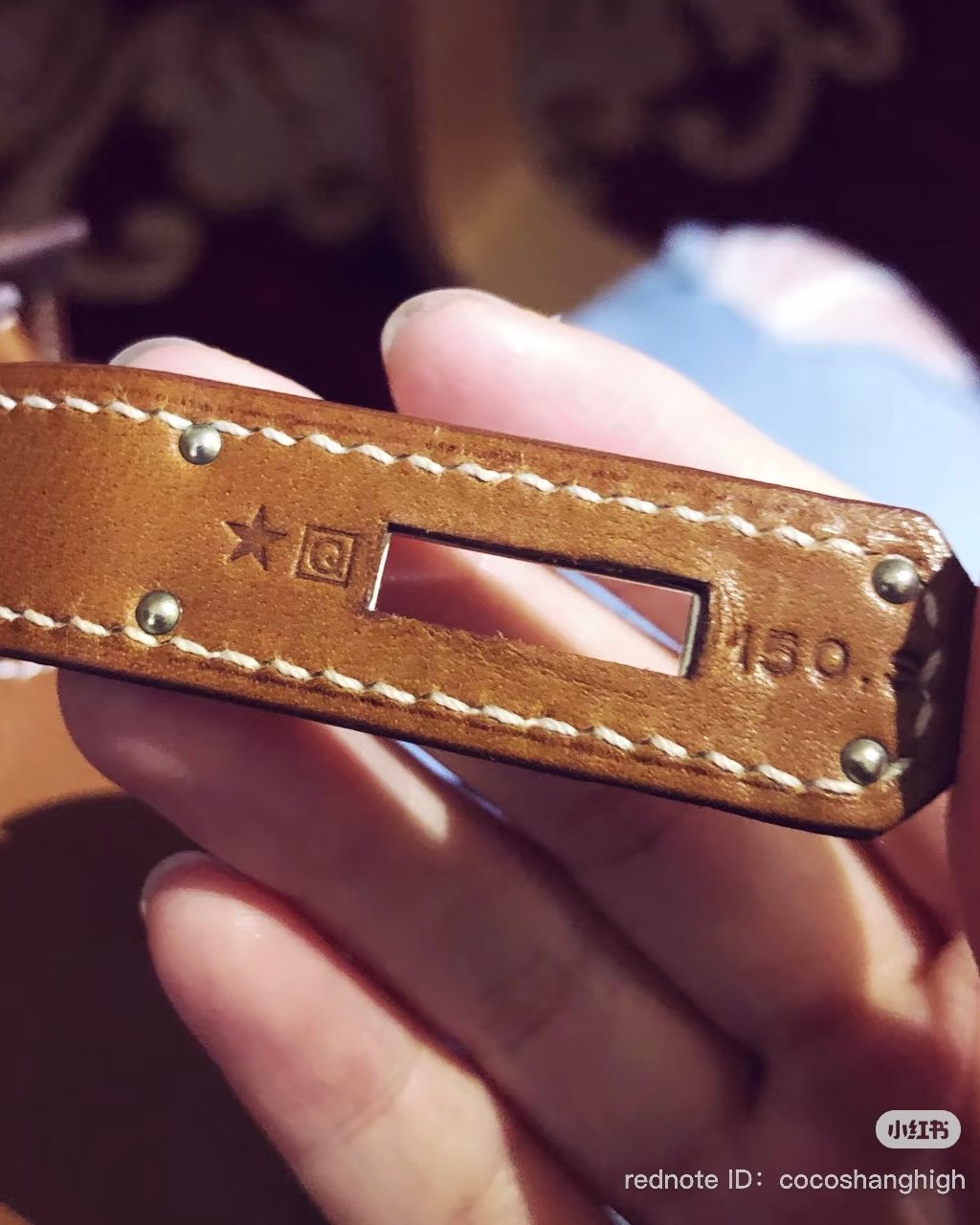
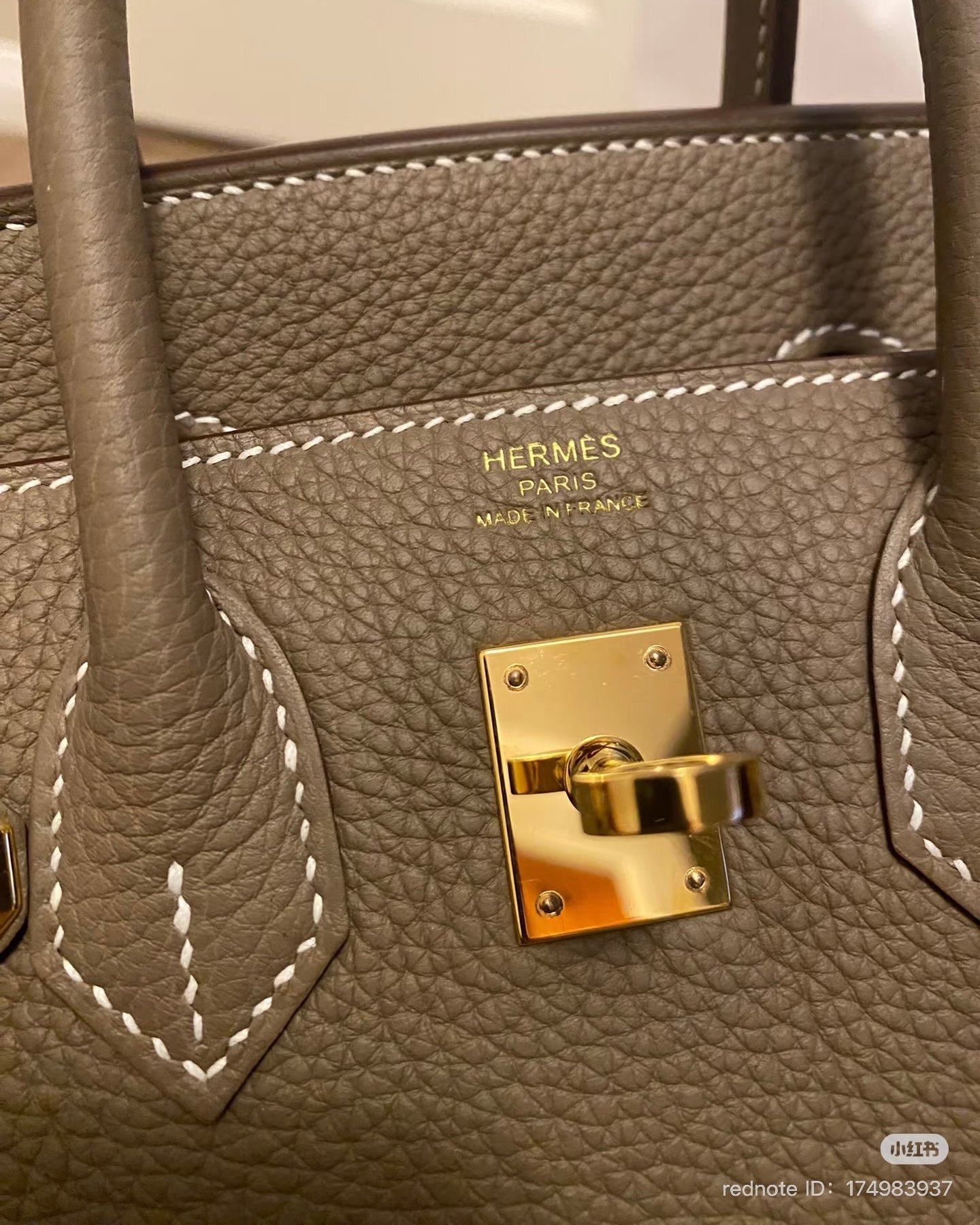
Understanding Hermès Symbols
Beyond the above markings, Hermès uses additional symbols to distinguish and describe exotic skins, special orders, push orders, and products crafted by personal artisans.
Exotic Skin Symbols
Hermès defines its exotic skins with unique markings that specify the type of skin used. These symbols are positioned on the right side, adjacent to the ‘Hermès Made in France’ stamp. Below are the specific markings for each type of exotic skin.
Alligator Mississippiensis: Square (☐)
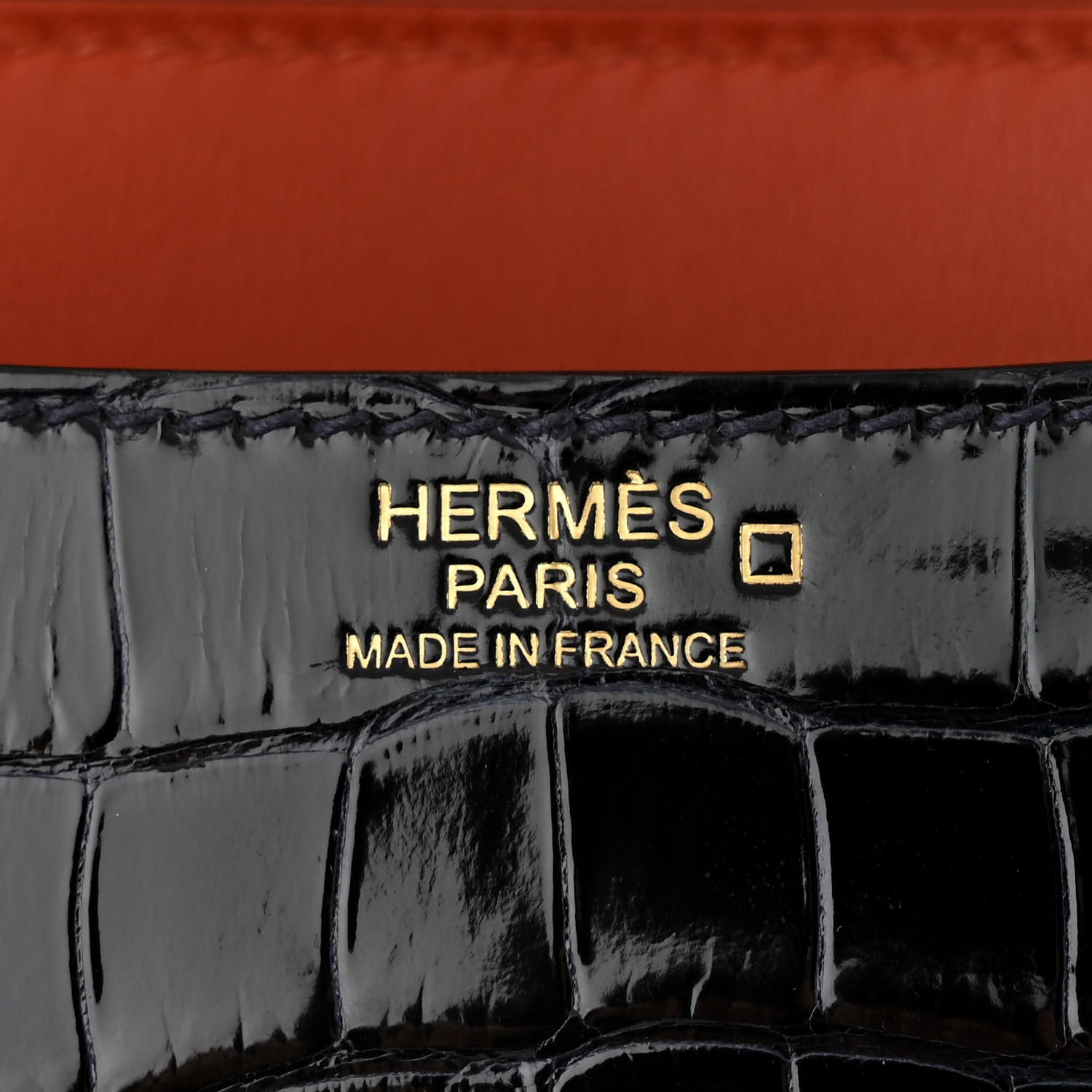
Image courtesy: FASHIONPHILE
Crocodile Niloticus: Two dots (••)
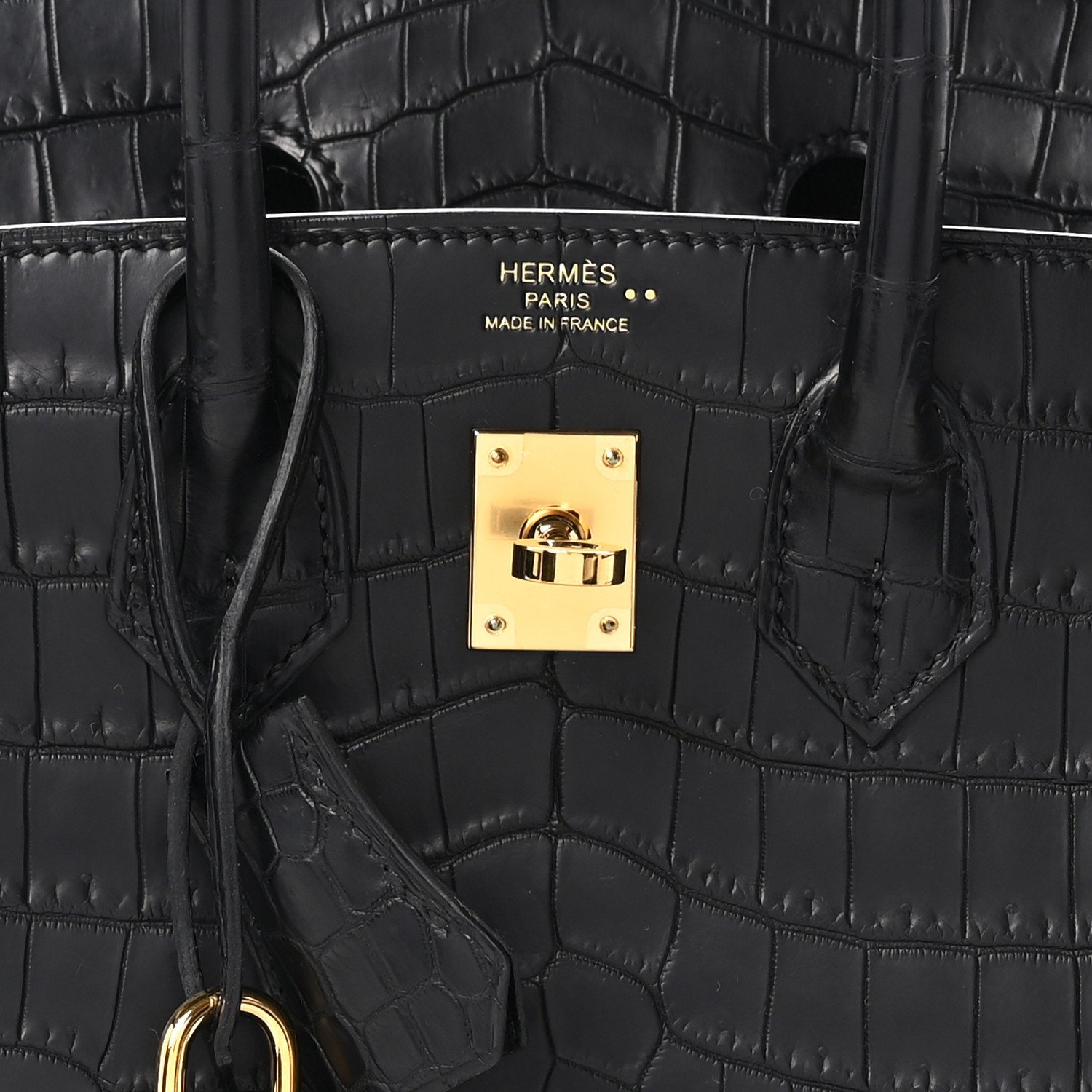
Image courtesy: FASHIONPHILE
Crocodile Porous: Caret symbol (^)
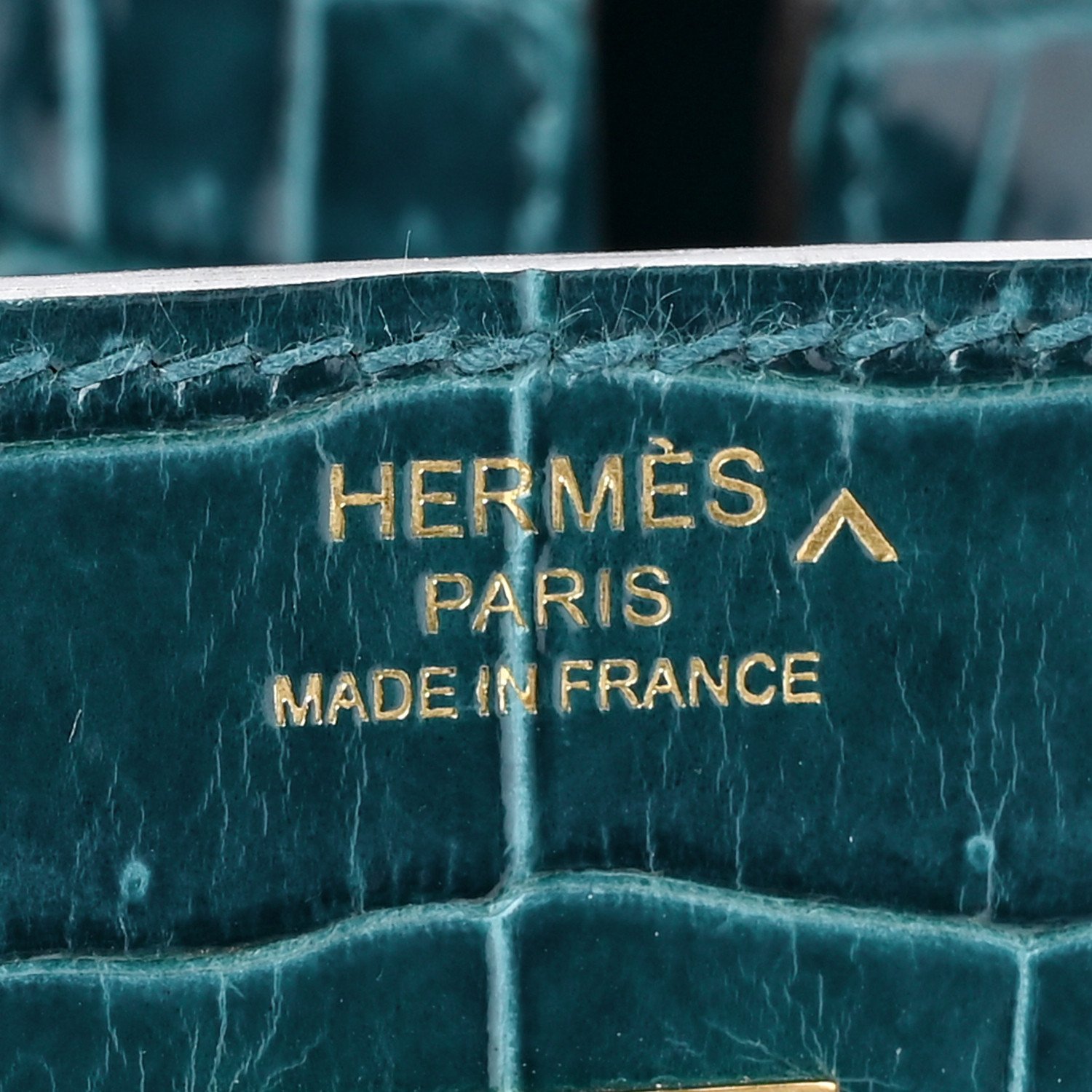
Image courtesy: FASHIONPHILE
Lizard Niloticus: Single hyphen (-)
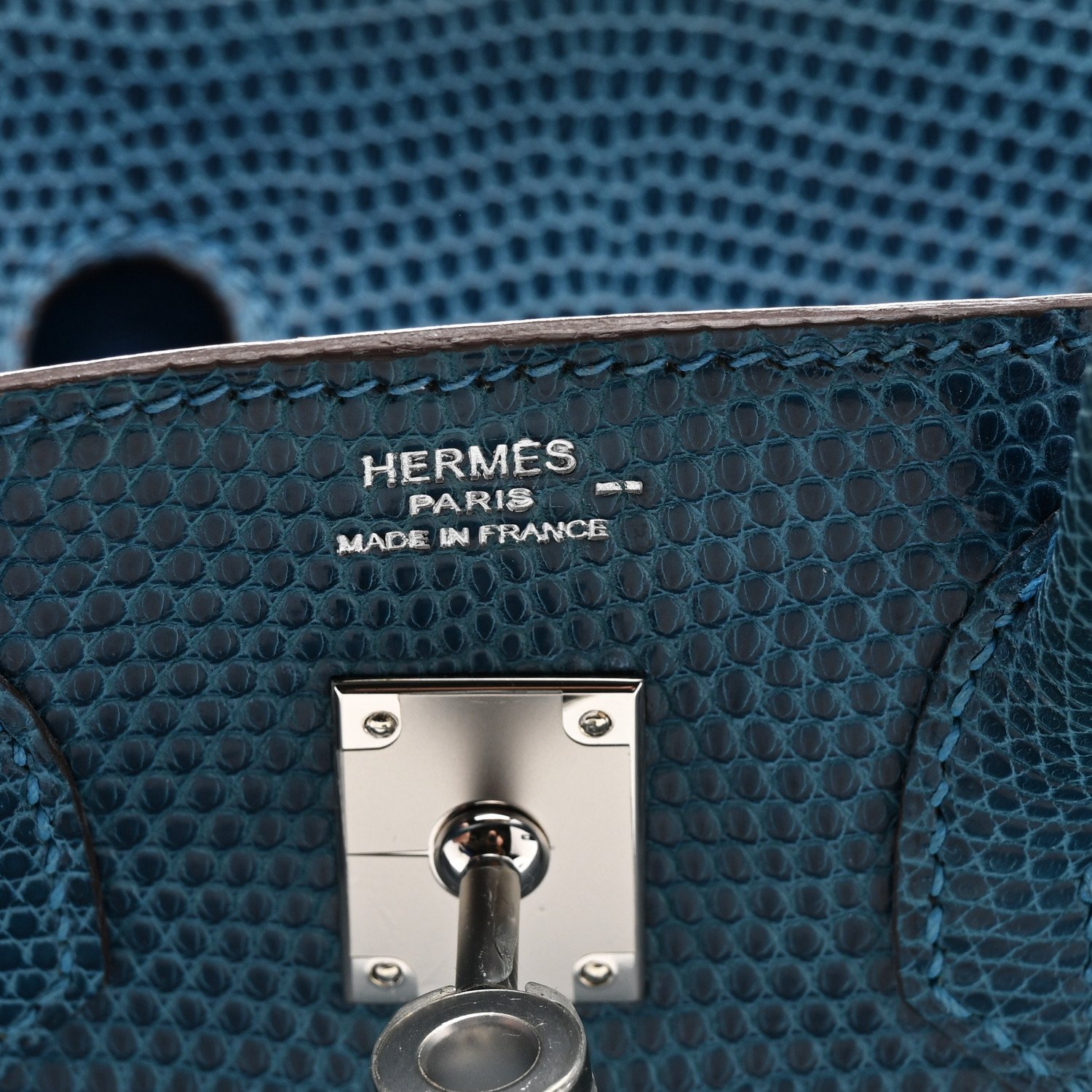
Image courtesy: FASHIONPHILE
Lizard Salvator: Equal sign (=)
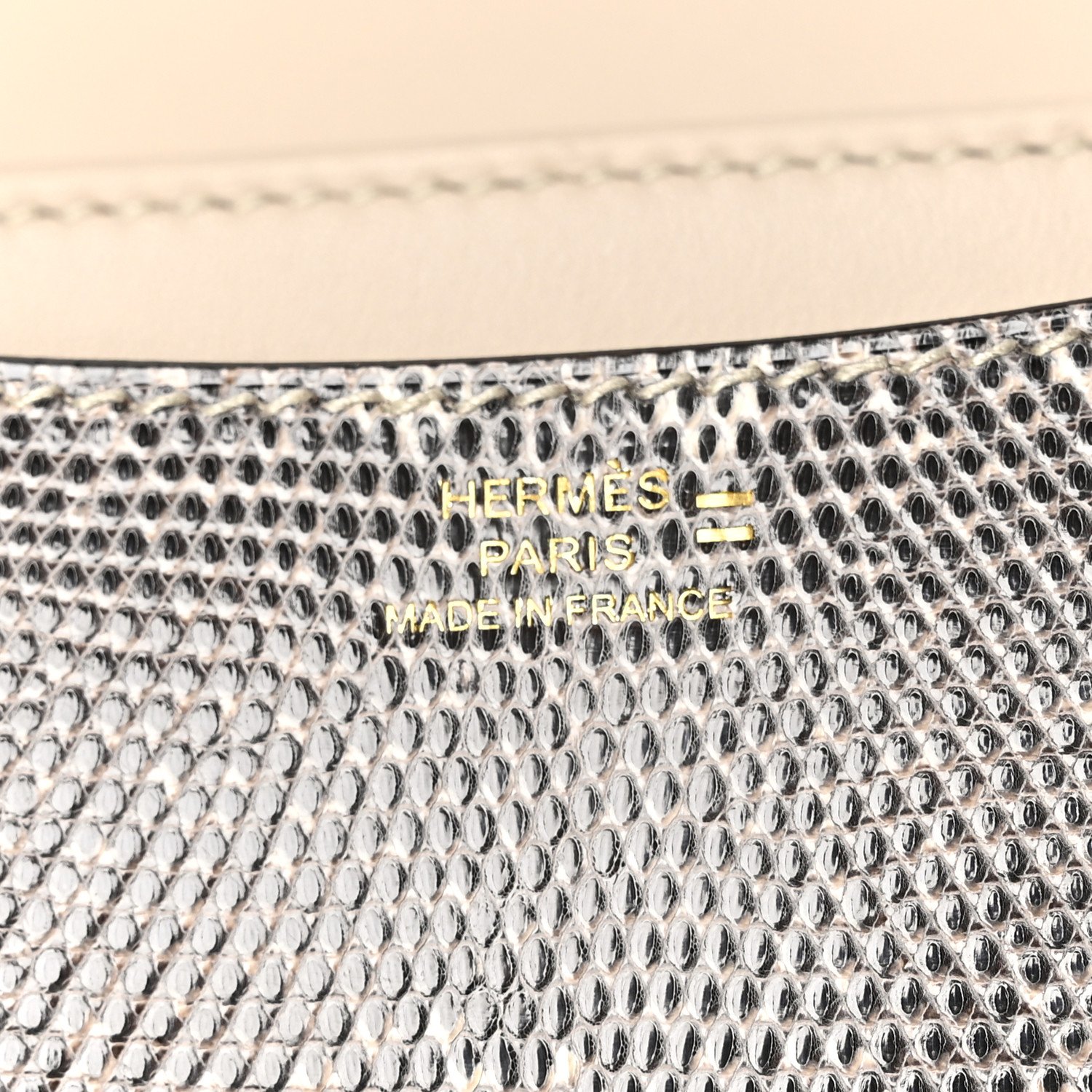
Image courtesy: FASHIONPHILE
Ostrich: No stamp
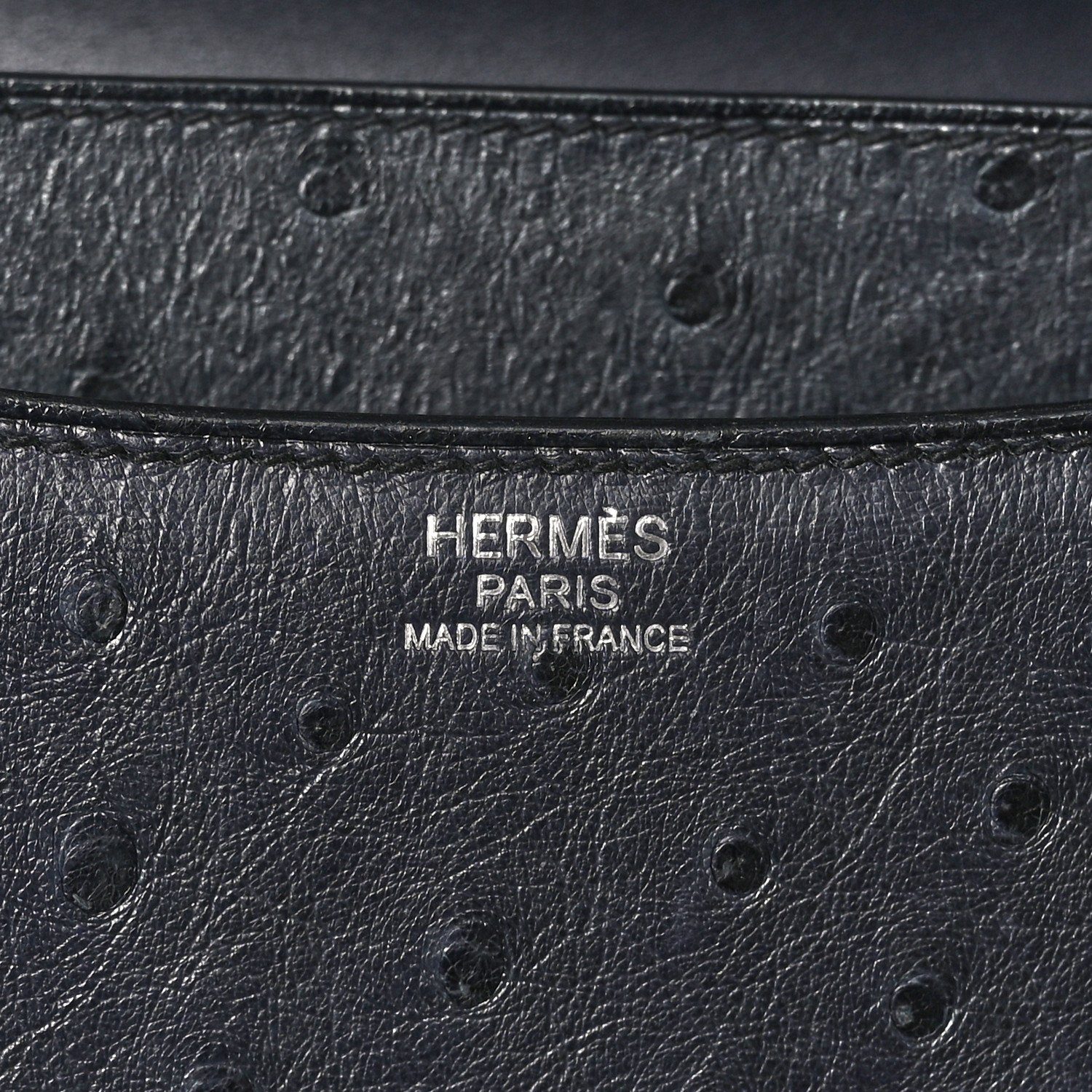
Image courtesy: FASHIONPHILE
Special Order ‘Horseshoe’ Bags
The coveted horseshoe stamp represents a special order bag and is located on the left side of the ‘Hermès Made in France’ stamp.
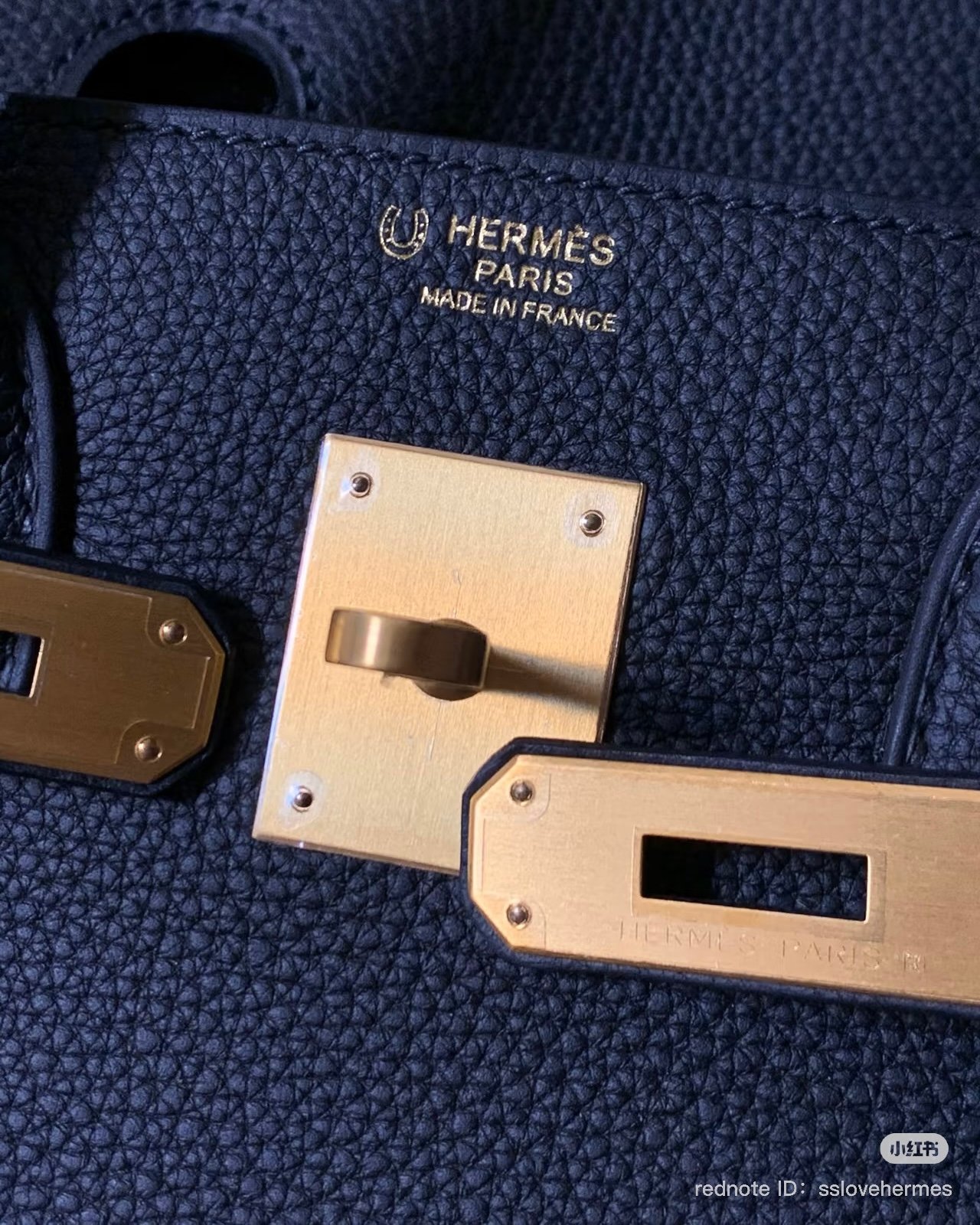
Hermès Craftspeople’s Personal Product
The shooting star symbol indicates that a piece was crafted for a Hermès craftsperson’s personal use. This unique marking appears below the ‘Hermès Made in France’ stamp.
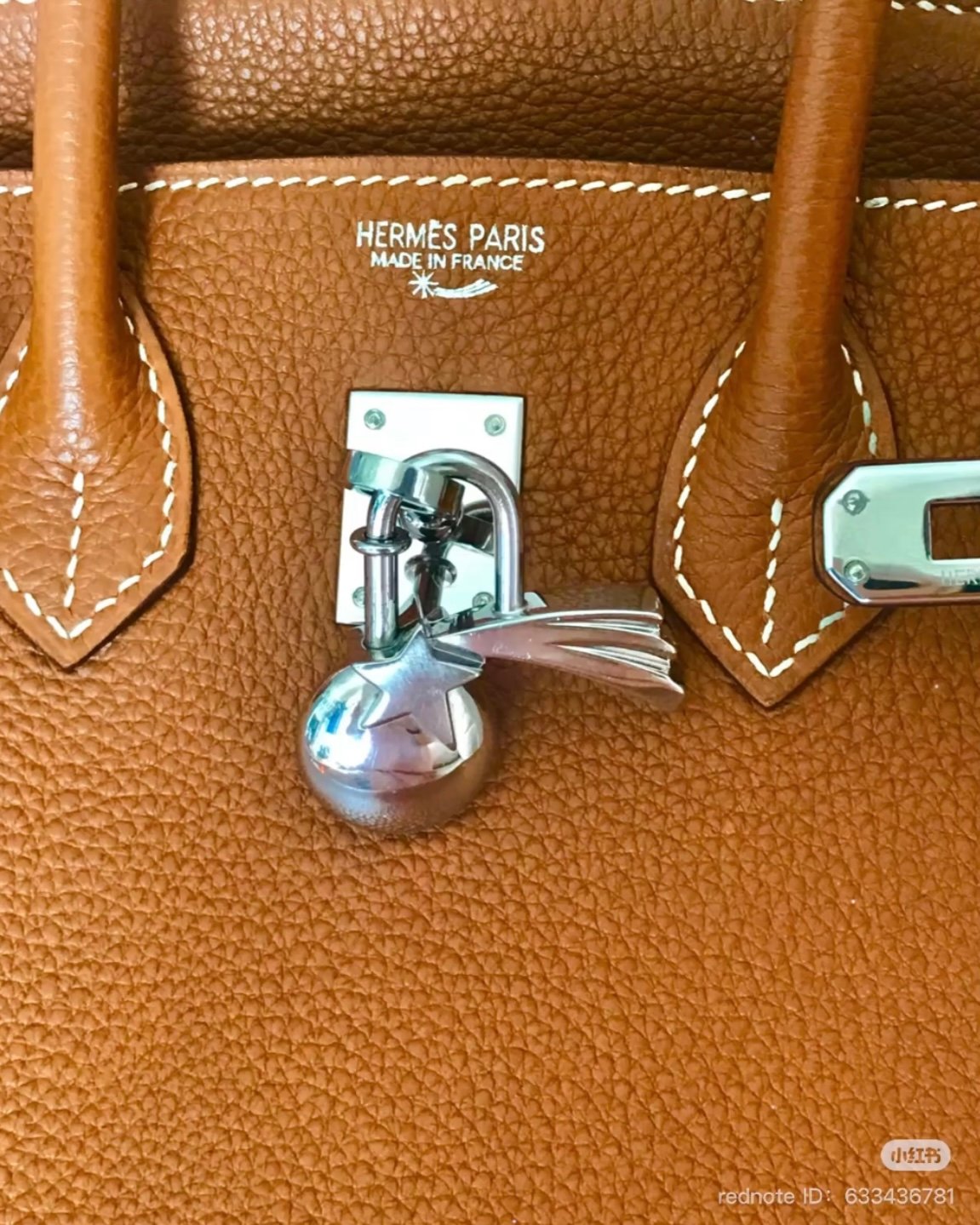
Hermès Authentication Tips
To ensure the authenticity of Hermès bags, always purchase through official channels. Of course, the most reliable way to authenticate your item is to buy directly from Hermès, whether in person at a Hermès boutique or on the official Hermès website.
Given the difficulty of purchasing handbags on demand from Hermès, many turn to the secondary market, where these bags may command premium pricing. If considering a preloved item or a box-fresh piece from a reseller, shop only from recognized and authorized retailers with expertise in authenticating Hermès products.
It’s important to note that Hermès does not authenticate bags upon request. However, if you send a preloved bag to the Hermés Spa for service and they refuse to work on it, this may indicate that the bag is not authentic.
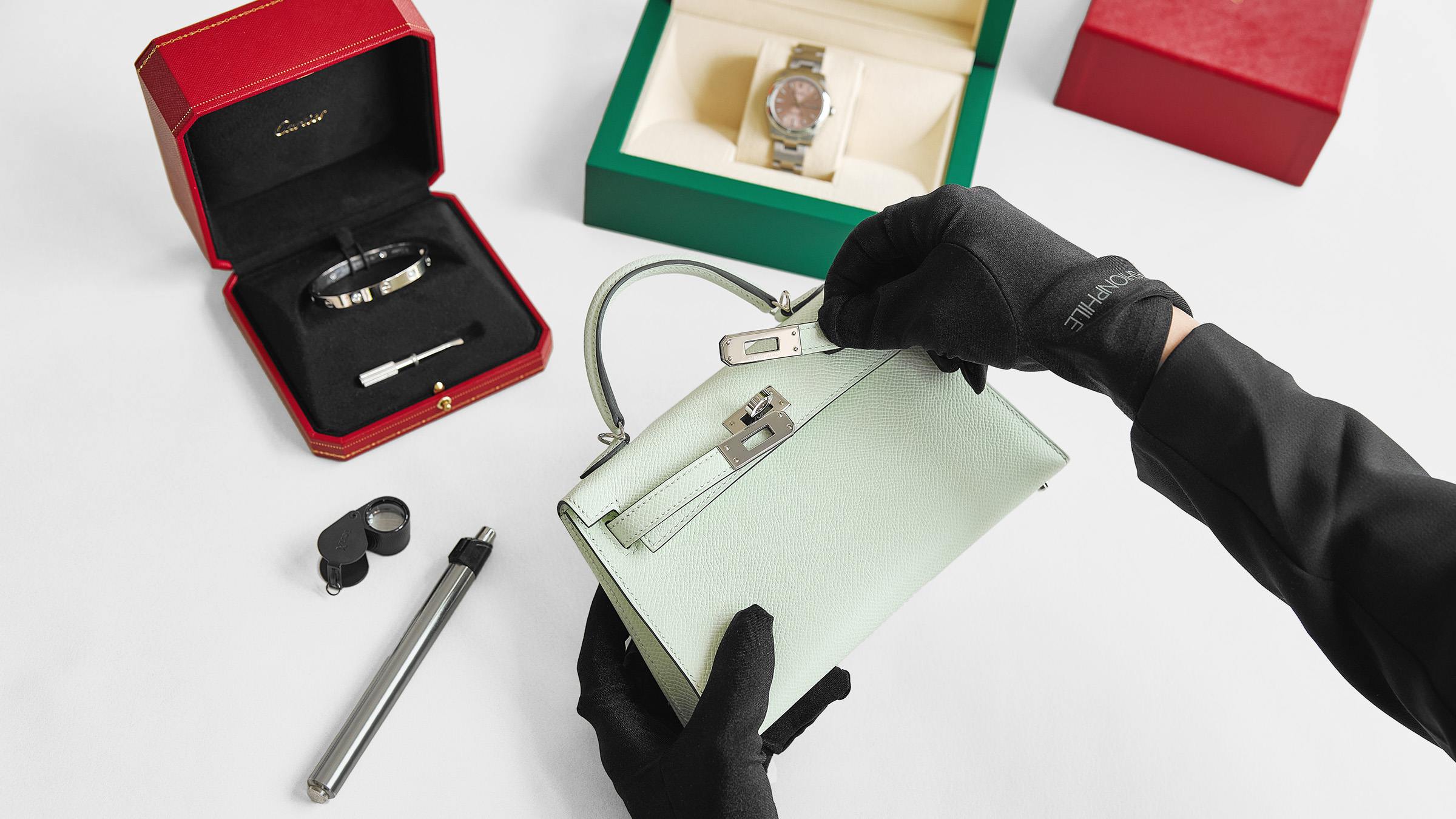
Image courtesy: FASHIONPHILE
The Art of Hermès Craftsmanship
At Hermès, craftsmanship is not just a skill – it’s an art. Since 1922, every bag has been handmade in France, upholding a tradition of excellence. The Birkin bag, for instance, requires a minimum of 18 hours for a single artisan to craft. The Kelly follows a similar path, composed of 36 individual leather pieces, and 680 hand-sewn stitches – taking between 18 and 24 hours to complete.
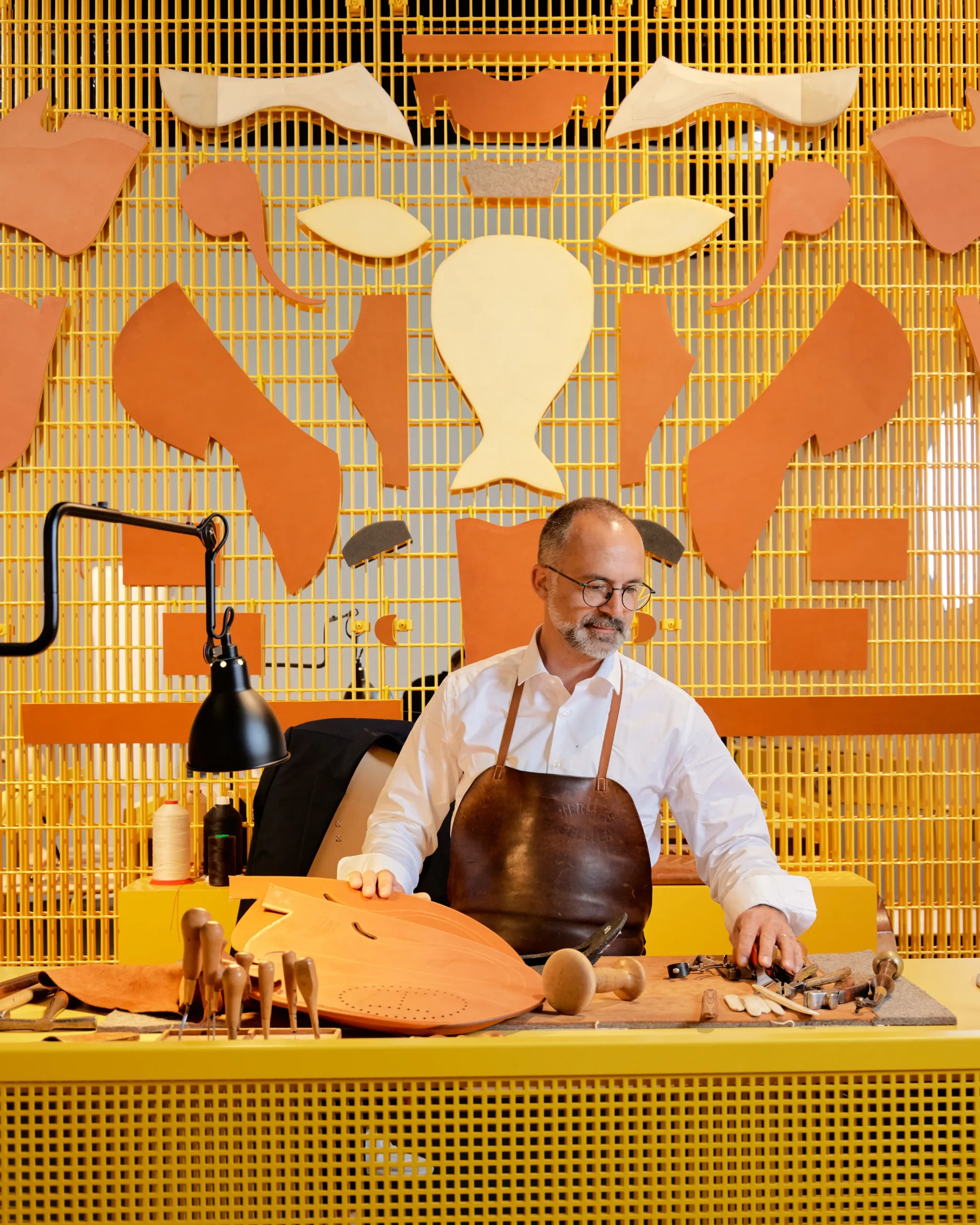
Image courtesy: Vogue
The Expertise of Hermès Artisans
Artisans undergo extensive training at Hermès’ École des savoir-faire where they spend between two and six years mastering the craft before working in the leather workshops. Each year, Hermès recruits over 200 new craftspeople for its leather goods division. They learn intricate techniques passed down through generations, mastering every aspect of the craft, including leather cutting and the Maison’s signature saddle stitch.

From Concept to Creation: The Hermès Design Process
Creating any Hermès bag is an art that demands both precision and dedication. After completing rigorous training, artisans undergo an additional five years of skill development before they are entrusted with crafting their first Birkin or Kelly.
Each Hermès bag is meticulously crafted at every stage. True to the Maison’s commitment to unparalleled quality, a single artisan is responsible for the entire creation of the entire bag. While the specific procedures differ by design, all bags undergo a series of essential stages.
Leather Selection
This is where it all begins – the most crucial step in the Hermès creation process. Artisans first carefully inspect each piece of leather, looking for flaws, even as small as a mosquito bite. Only the flawless skins move on to the next stage, ensuring quality from the very start.

Cutting
Once the leather is approved, the artisan carefully cuts it according to the bag’s design. Bags like the Birkin 25 are created from a single piece of leather, while larger designs may require multiple skins. In exotic skins like Lizard, four to five individual skins may be needed to complete even a smaller bag like the Kelly Pochette.
Stitching and Assembly
Each piece of the bag is then carefully hand-stitched together using the Maison’s signature saddle stitch. Developed originally for saddles, and a hallmark of Hermès bags, this stitch is known for its durability. Pieces are held firmly in a wooden clamp as the artisan works with two needles from opposite directions, embedding the waxed linen thread so that even if one stitch breaks, the seam remains intact.
The distinctive saddle stitch is especially visible on bags with contrasting natural stitching in colors like Gold, Fauve, Étoupe, and Bleu Jean, as well as on select special-order pieces.
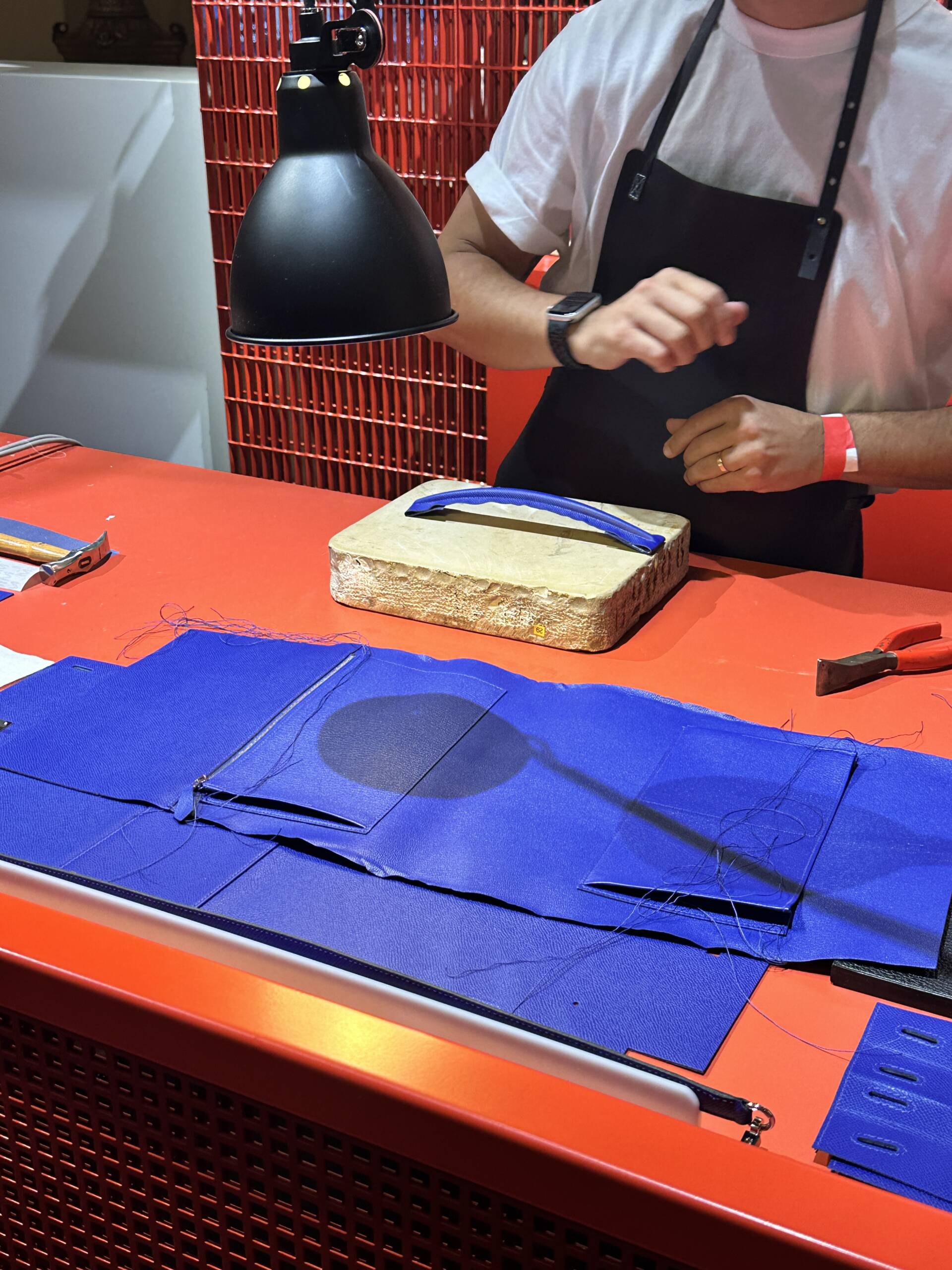
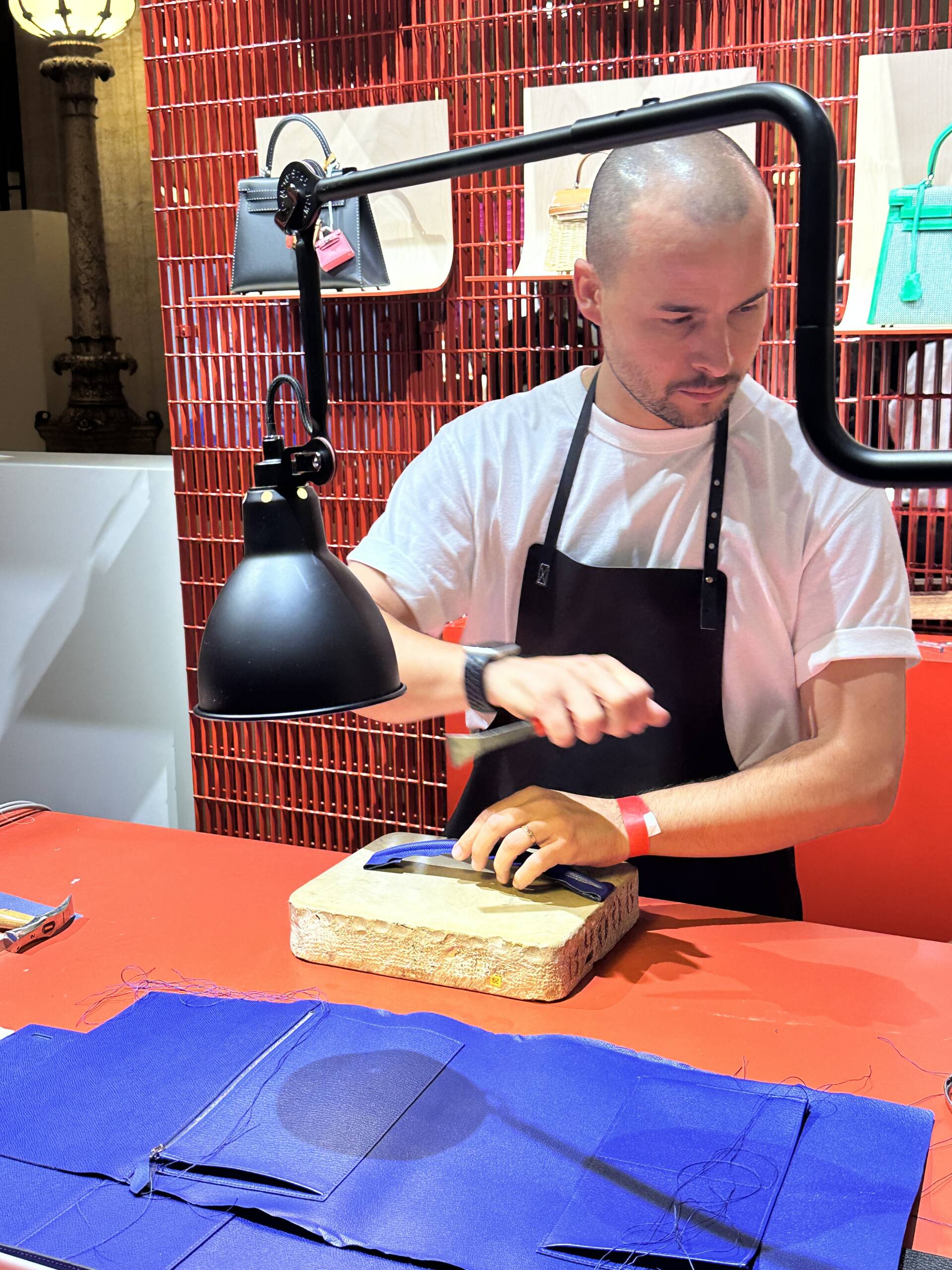
Hardware
Most Hermès bag styles include metal hardware, hardware, including plates, clasps, padlocks, locks, studs, and buckles. Hermès hardware is typically crafted from brass, which is then hand-polished and plated with fine gold, palladium, or permabrass.
Adding hardware is one of the final steps in the bag’s construction, with protective stickers applied to each piece to prevent scratches and scuffs. These stickers remain in place until purchase, allowing customers to remove them to reveal pristine hardware.

Image courtesy: Vanity Fair
Quality Control
Each bag undergoes a series of rigorous quality checks, where artisans and senior artisans meticulously inspect each bag for any defects or inconsistencies. Every detail from stitching to hardware is examined, ensuring that only flawless pieces are approved for sale.
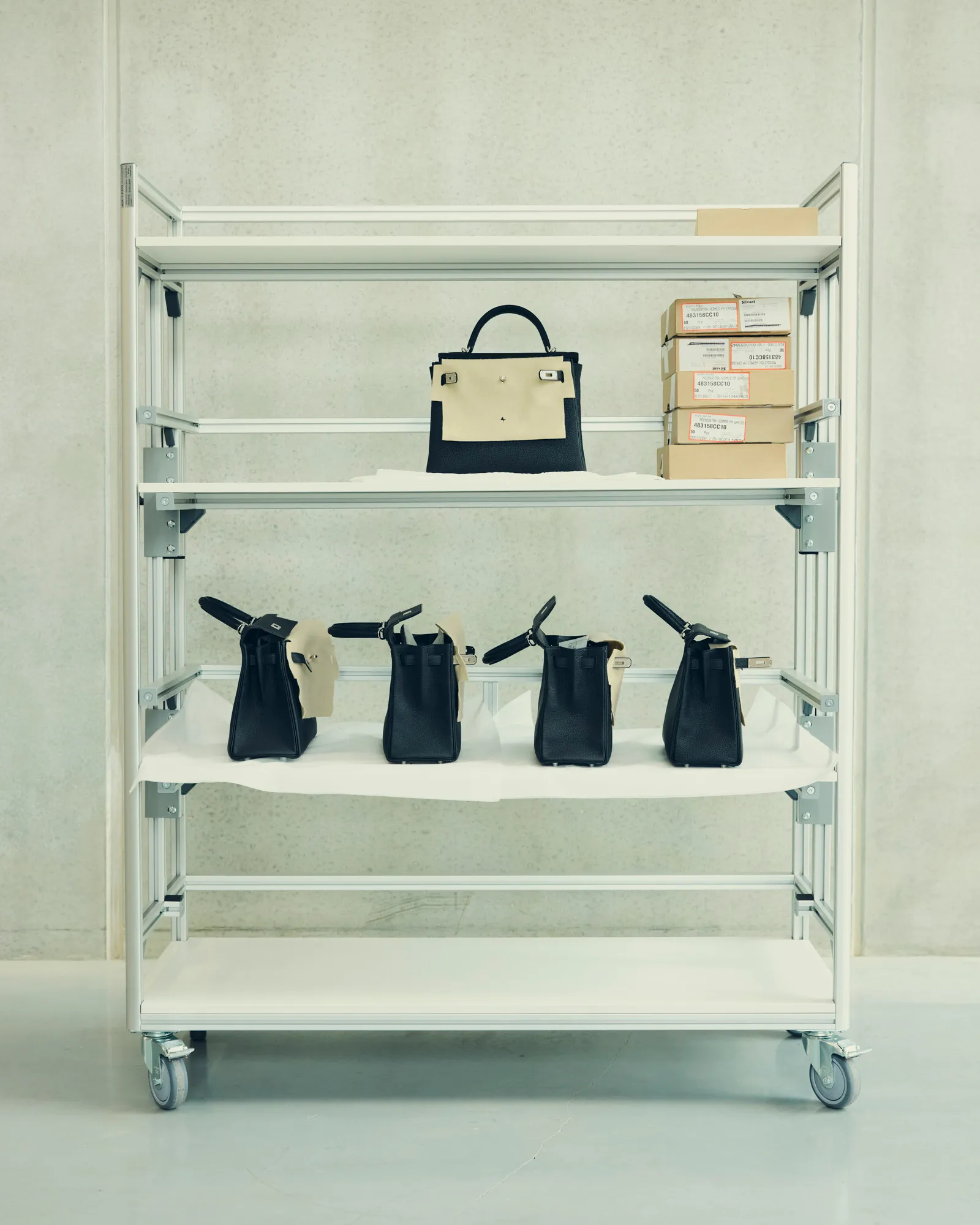
Image courtesy: Vanity Fair
Why Some Hermès Leathers Are Retired
Hermès has retired several leathers over the years, driven by factors such as material availability and evolving fashion trends. However, a key reason for these retirements lies in the unique relationship between the Maison’s dedicated artisans and the leathers they work with.
Certain leathers require specialized techniques and exceptional skills, which only a select group of highly trained craftspeople possess. As these artisans retire or move on, maintaining the same level of quality can become increasingly challenging. As a result, Hermès may choose to retire particular leathers to uphold the artistry and skill that define the Maison’s legacy.
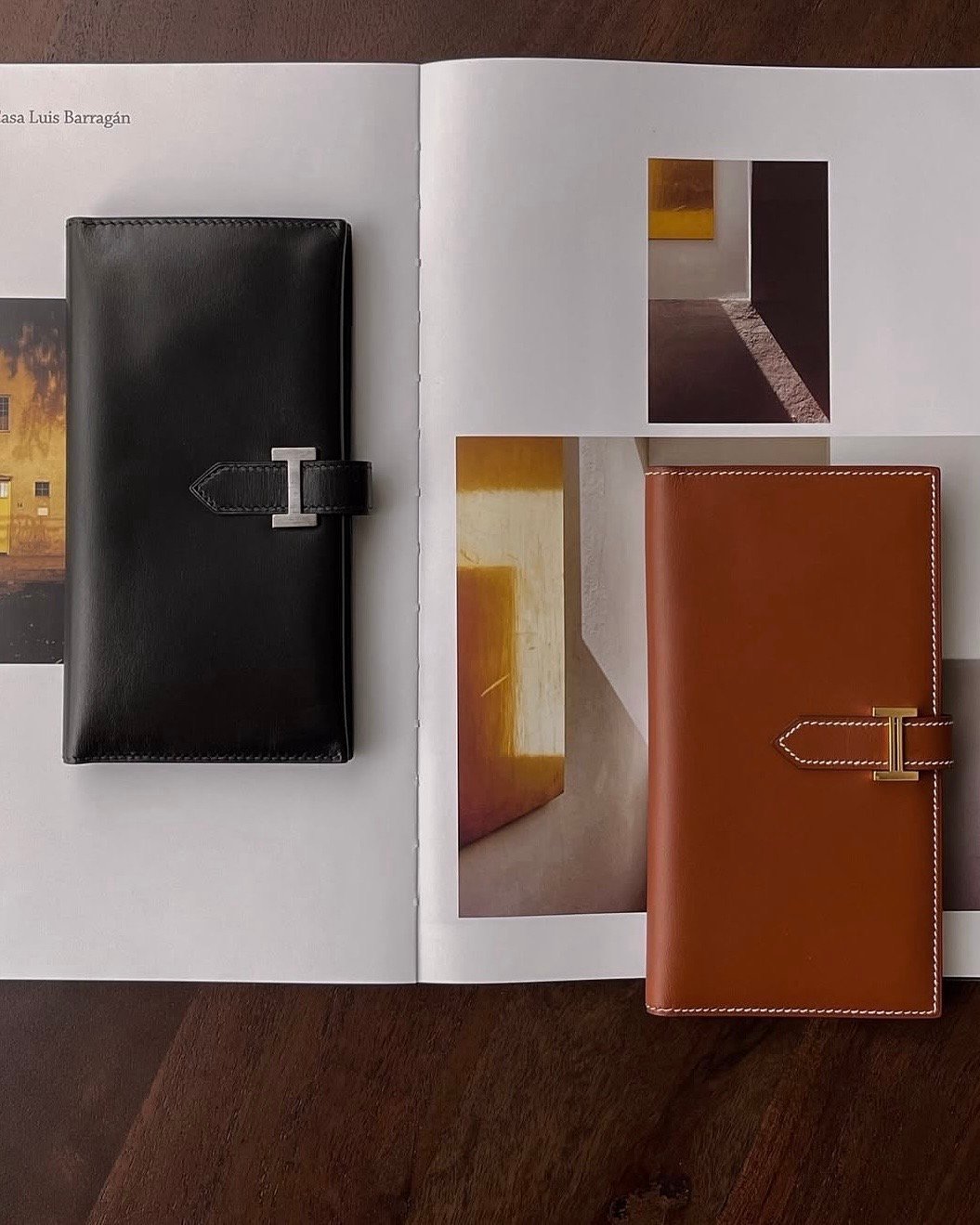
Image courtesy: @heynixon
Celebrating Hermès Leathers
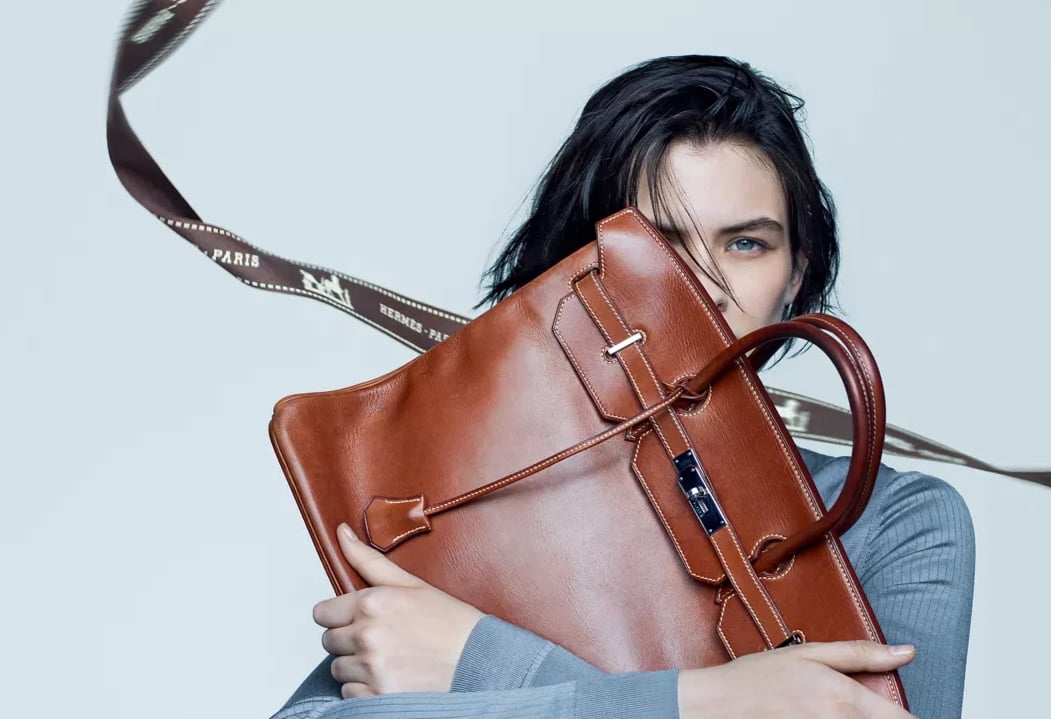
Image courtesy: Hermès
The Lasting Beauty of Hermès Leather
More than just materials, Hermès leathers reflect the Maison’s rich history. Whether crafted from timeless, heritage, or exotic skins, Hermès artisans, with their unparalleled expertise, transform these exquisite leathers into wearable works of art meant to be enjoyed for many years to come.
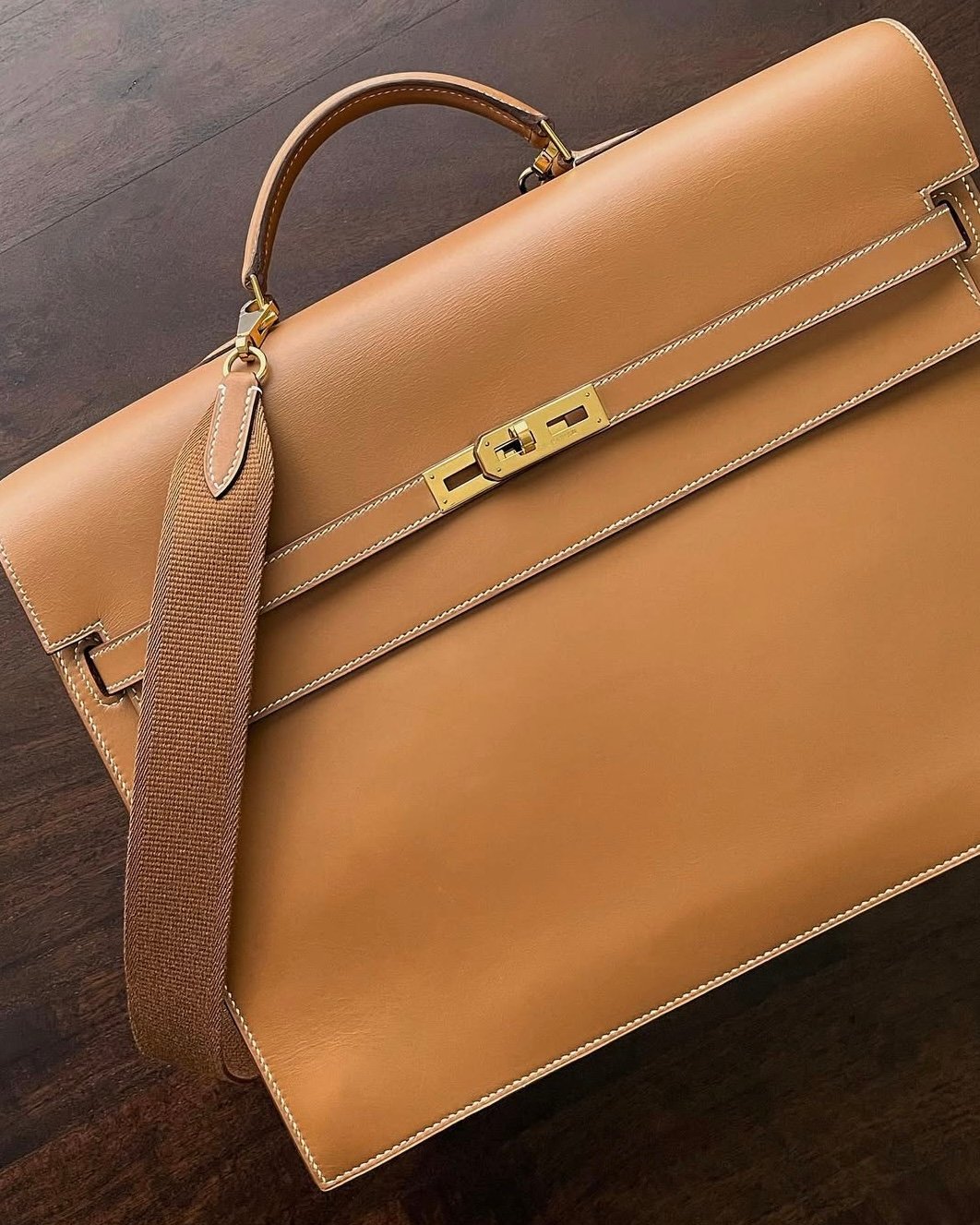
Image courtesy: @heynixon
Choosing the Perfect Hermès Leather
Selecting the right Hermès product is an opportunity to express your personal style. By understanding the unique characteristics of each leather, you can choose pieces that truly resonate with you.
Whether you value durability, color vibrancy, or a specific texture, there’s a Hermès leather to suit your needs. Take the time to explore the various options, and within time, you’ll find the addition to your collection.
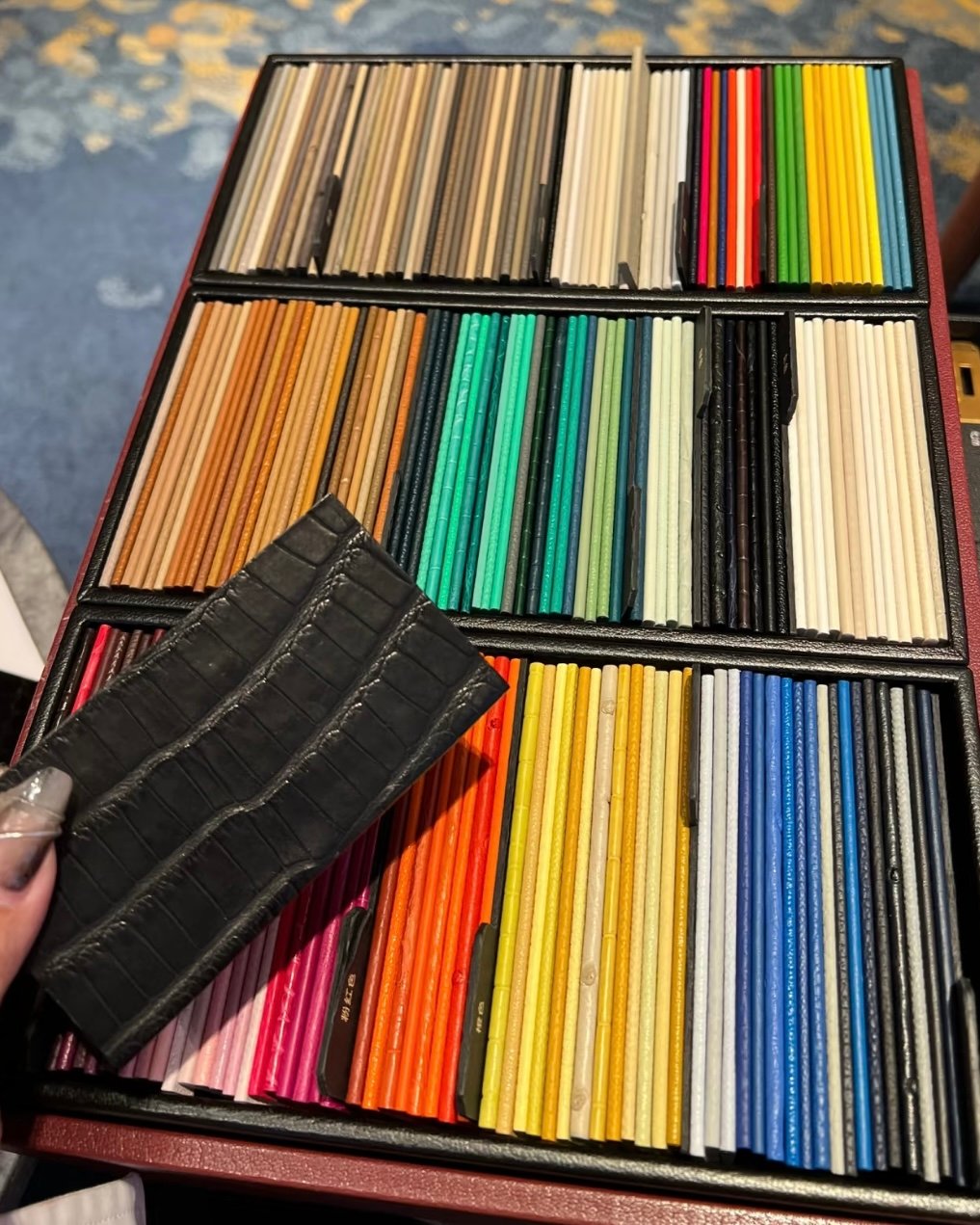
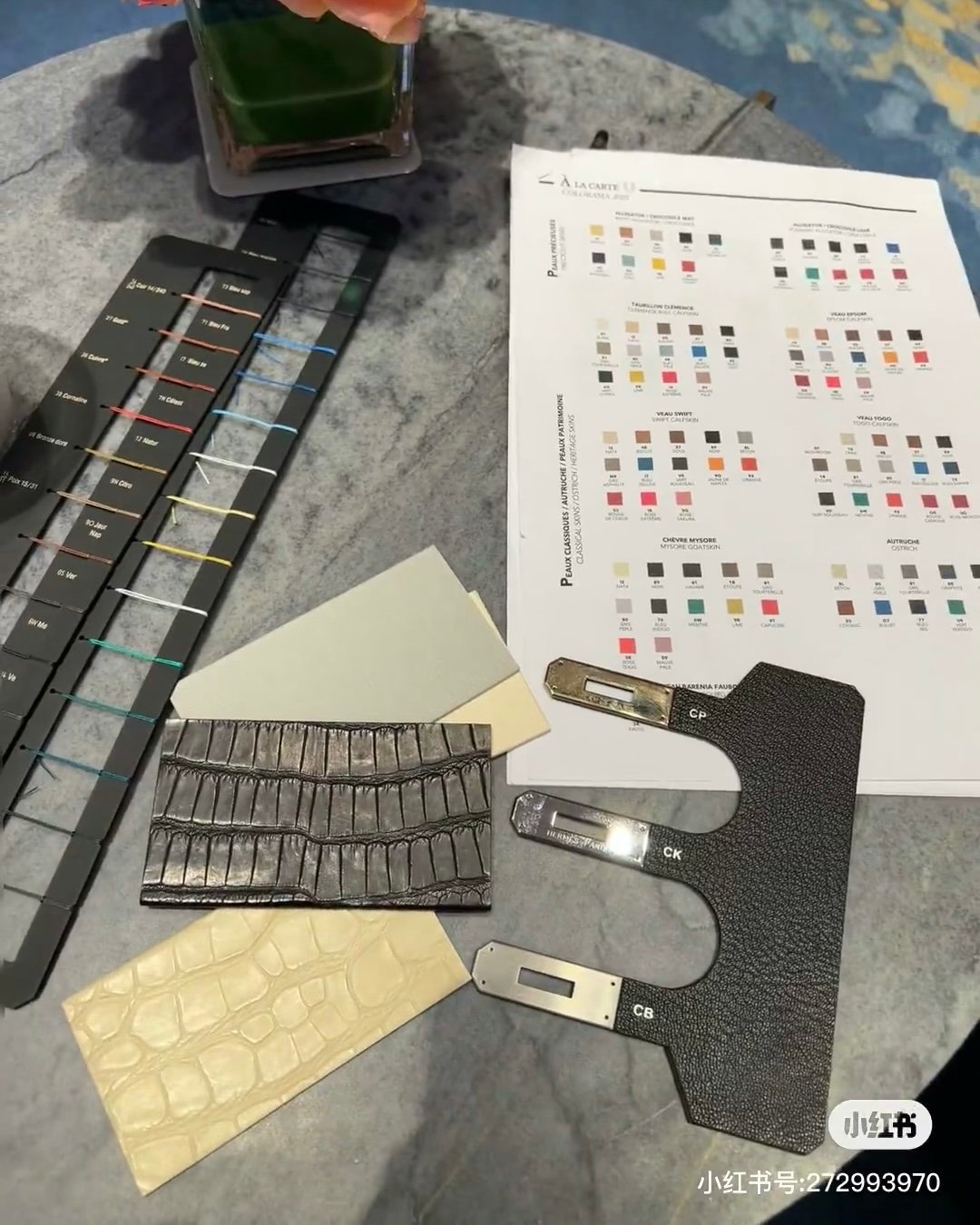
Embracing the Legacy
Each Hermès bag carries the legacy of the Maison – a symbol of luxury imbued with the spirit of craftsmanship, tradition, and innovation. At its core lies the choice of leather, defining the artistry of every creation.
Thank you FASHIONPHILE for access to great leather close ups.
Read related articles:
6 Exclusive Hermès Bags You’ll Dream About This Season
Hermès Introduces 11 New Handbags for Spring-Summer 2025
The Original Hermès Bag: The Hottest HACs
How Much Does a Mini Kelly II Really Cost in Paris in 2025? The Handbag Math
US Hermès Price Increase 2025 – Here are the New Prices
New Confirmed Hermès Prices in Europe 2025
Love, PurseBop
XO
Updated: February 28th, 2025



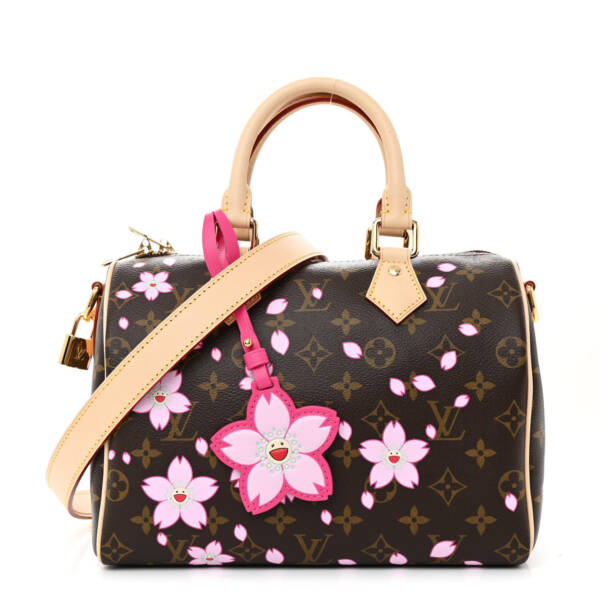
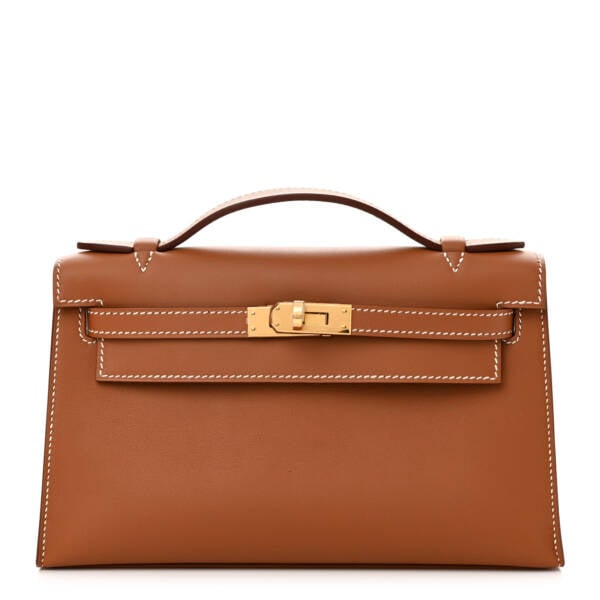
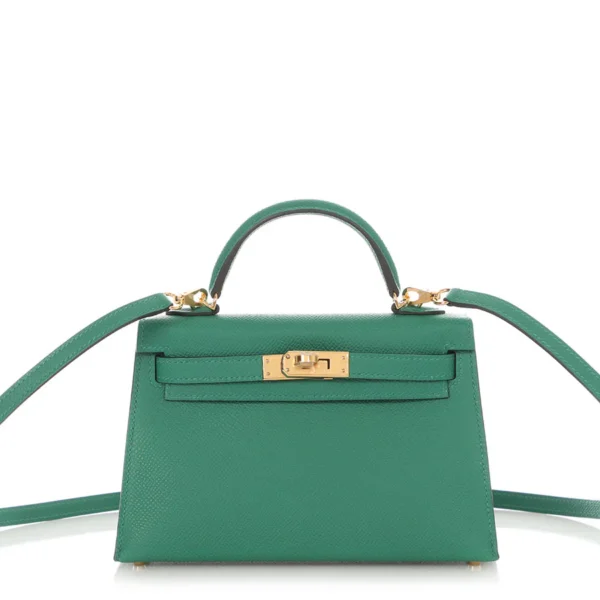
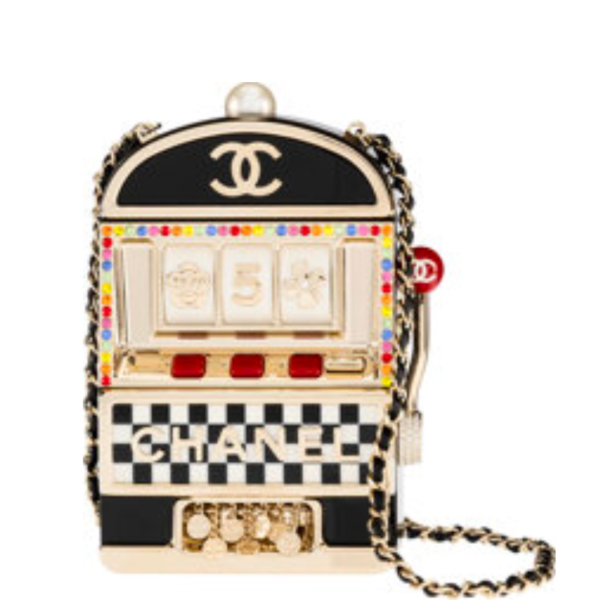
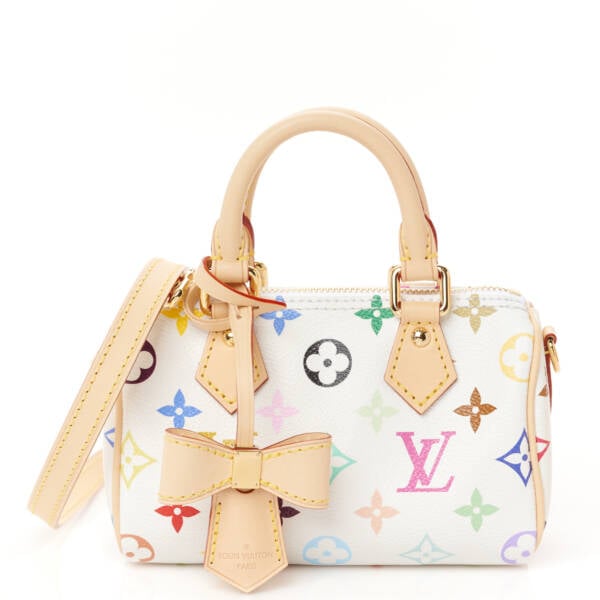
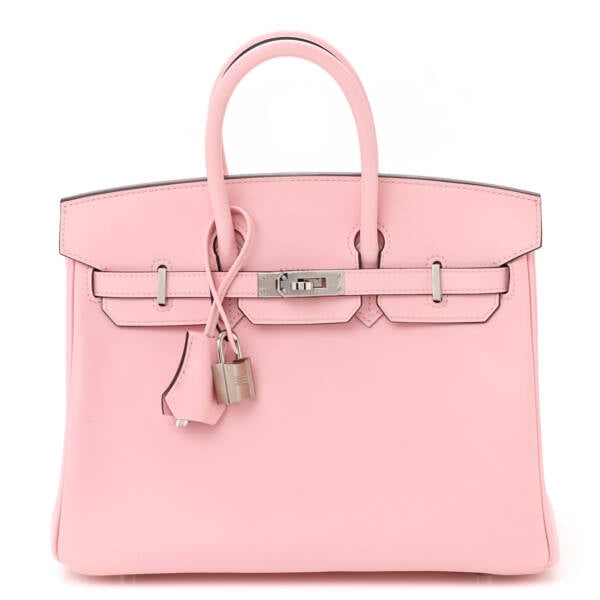

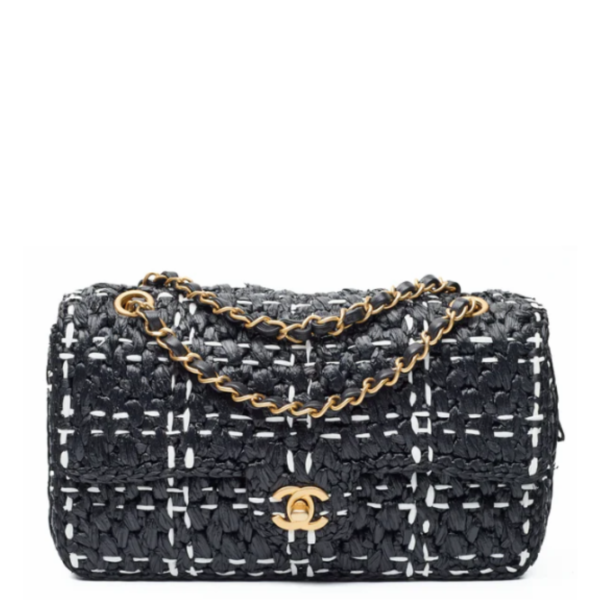
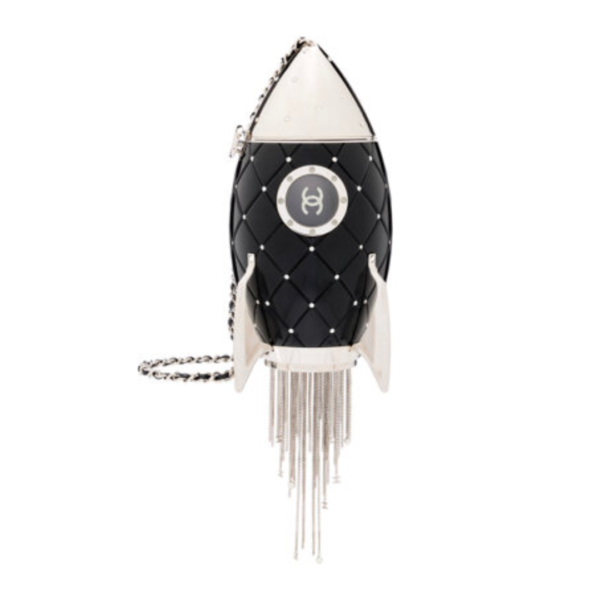


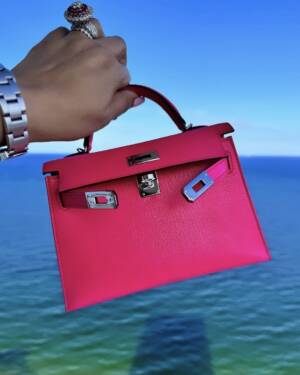
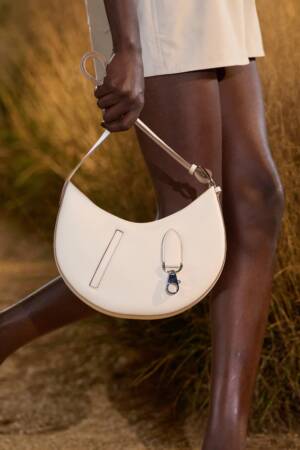
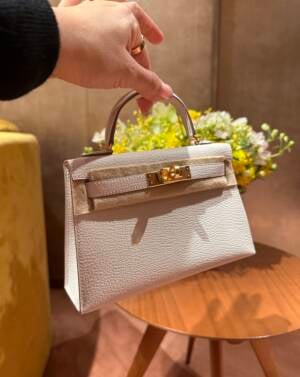

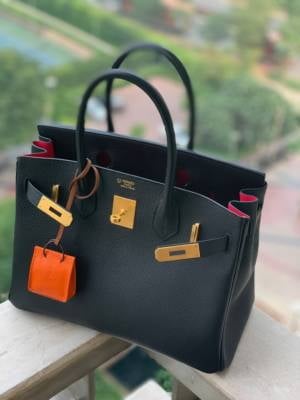



Comments